Phalacrocorax carbo
Vist sovint en caiac
Illes Formigues
Port Fòrum, setembre 2016

on situar el que hem viscut, el que podem pensar tot el que hi ha, hi ha hagut, el que voldria recordar o tornar a veure
Phalacrocorax carbo
Vist sovint en caiac
Illes Formigues
Port Fòrum, setembre 2016
Hirundo rustica
Cada any les espero, a mitjans d’abril, i m’alegren l’estiu quan les veig volar veloces fent curses al pati de veïns, o quan estic assegut a la terrassa.

Miró. Oiseau dans l’espace 1976. Reina Sofía
Llavors Diotima i jo ens envolàvem; corríem d’ací d’allà com orenetes, d’una primavera del món a l’altra, per l’ample domini del sol i més enllà, cap a les altres illes del firmament, per les ribes daurades de Sírius, per les valls d’Arctur plenes d’esperits… [ Hölderlin, Hiperió, p.76]
Turdus merula
Em saluda els matins i m’acompanya les tardes a la terrassa.
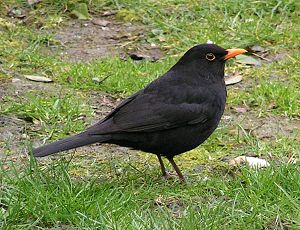
Parus major?, terrassa
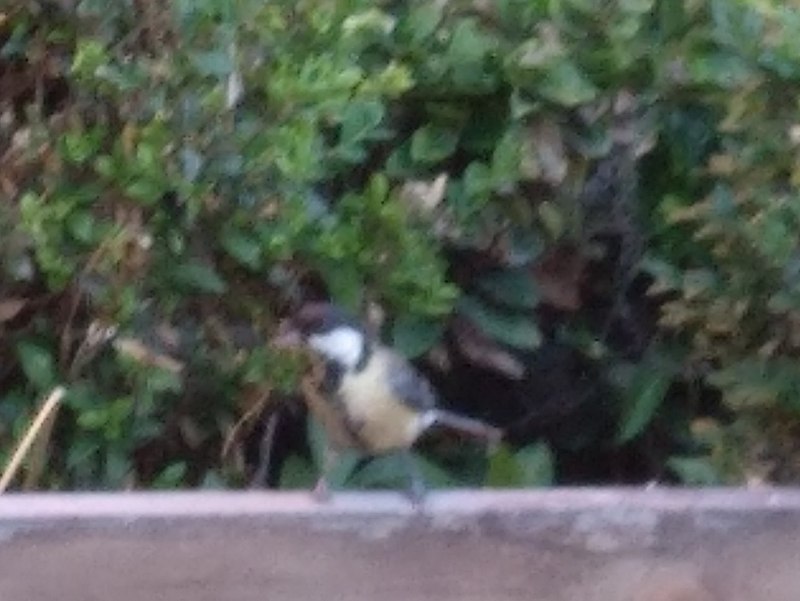

Cogulada Galerida cristata?
Un moixó amb cresta ha visitat la terrassa. No estic segur si era aquest.

Alosa, Alauda arvensis?

Quercus Pyrenaica (tot i que no n’hi ha Pirineu), a Catalunya només al bosc de Poblet a les muntantes de Prades. Es diu reboll perquè rebrota després de tallar-lo.
juny 2019
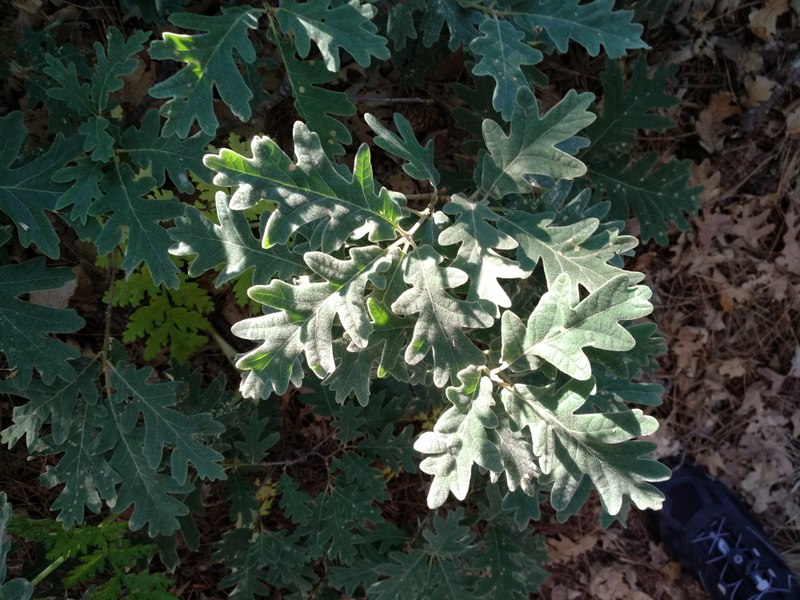
La Terra, geografia | Ciències de l’atmosfera
Composició de l’aire:
0-12 km Troposfera: És la capa inferior de l’atmosfera i es troba en contacte amb la superfície terrestre. Té un gruix variable degut al moviment de rotació terrestre, que fa que a l’equador predomini la força centrífuga i el gruix de la troposfera és d’uns 17 km, mentre que en els pols) predomina la força centrípeta i el gruix d’aquesta capa és d’uns 8 km.[5] Dins d’aquesta capa es produeixen importants fluxos convectius verticals i horitzontals (anomenats vent de forma genèrica), provocats per les diferències de pressió i temperatura existents entre unes regions i altres. Per això, en aquesta capa tenen lloc els anomenats fenòmens meteorològics que caracteritzen les zones climàtiques de la Terra. Com que la troposfera es troba en contacte amb la hidrosfera i la biosfera, presenta quantitats importants, però variables, de vapor d’aigua i de diòxid de carboni, així com quantitats també variables de partícules en suspensió (sobretot en els primers 500 m, que és la part coneguda com a capa bruta). La troposfera s’escalfa principalment per la transferència d’energia d’infraroig (calor) des de la superfície terrestre. Per això, en general la part més baixa de la troposfera és la més calenta mentre que la temperatura disminueix amb l’augment de l’altitud, a raó d’aproximadament 1 °C cada 150 m
12-50 km Estratosfera. Aquesta capa conté aproximadament el 10% de la massa atmosfèrica. Es caracteritza per la pràctica inexistència de circulació vertical de l’aire. En canvi, els fluxos horitzontals d’aire assoleixen sovint velocitats d’uns 200 km/h. Es tracta d’una atmosfera molt tènue i poc turbulenta, ja que l’aire calent que es troba a la part superior és menys dens i per tant és estable damunt de l’aire més fred. Per aquest motiu els avions comercials volen a aquest nivell.
50-85 km Mesosfera. La característica més remarcable d’aquesta capa és un nou descens de la temperatura en augmentar l’altitud, fins a arribar als -100 °C aproximadament, a una altitud de 80 km, on se situa la mesopausa, que és la zona més freda de l’atmosfera. La mesosfera conté només el 0,1% de la massa total de l’aire.
85-500 km Termosfera o Ionosfera. La termosfera és la capa més gran de l’atmosfera, situada per sobre la mesosfera i per sota de l’exosfera. En la termosfera la temperatura augmenta amb l’altitud fins a arribar a la termopausa (o exobase), que marca el límit entre la termosfera i l’exosfera. Aquest límit varia segons l’activitat solar i se sol trobar entre els 350 i els 800 km. La temperatura d’aquesta capa pot assolir els 1500 °C, encara que les molècules de gas estan tan allunyades que el terme temperatura no es pot fer servir en el sentit habitual. L’aire està tan enrarit que una molècula individual (per exemple d’oxigen) viatja de mitjana 1 km abans de col·lidir amb altres molècules.
500-10.000 km Exosfera. L’exosfera és la capa més externa de l’atmosfera terrestre i s’estén des de la termopausa cap a dalt (aproximadament des dels 500 km fins a uns 10000 km d’altitud). L’exosfera marca el límit entre l’atmosfera terrestre i l’espai exterior. Està composta principalment per hidrogen i heli. Les partícules estan tan allunyades entre si que poden viatjar centenars de kilòmetres sense col·lidir entre elles. Com que les partícules rarament xoquen, l’atmosfera no es comporta com un fluid.
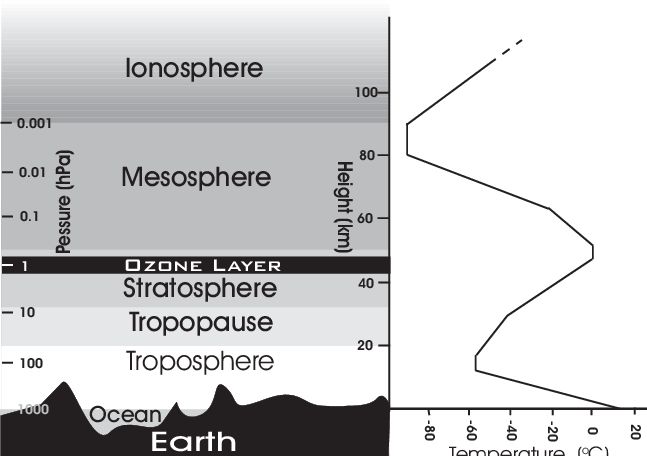

La Terra, geografia | Estructura de l’atmosfera | Meteorologia | Ciències de la terra
[font DKS]
[Abans
Alhacen estima l’alçada de l’atmosfera en 15 km, basant-se en que el crepuscle comença quan el sol és 19º sota l’horitzó.
Galileu va estimar la densitat de l’aire, en 0.22% la de l’aigua, una aproximació prou bona al valor de 0.12%]
16xx Hadley: L’aire puja a l’Equador i es desplaça a nord i sud per dalt, essent desplaçat de W a E per la rotació de la terra. Retorna per superfície desplaçant-se de E a W.
1856 William Ferrell, refina el model proposant unes cel·les intermitges
[aire]
1784 Cavendish estableix que la composició de l’aire és bàsicament oxígen i nitrogen. ( l’estudi de l’evolució revela que les cianobactèries van transformar la composició de l’atmosfera de reductora a oxidant, fa 2400 milions d’anys: “la catàstrofe de l’oxígen“)
1804 Gay-Lussac i Biot pugen en globus 4 km per mesurar la concentració d’oxígen, pressió i temperatura. Disminueixen gradualment. S’envien sondes no tripulades més amunt i s’arriba a la conclusió que hi ha una primera capa, la Troposfera, de 0-12 km, on tenen lloc els fenomens meteorològics 0-12km. Segueix la Estratosfera, més uniforme i calma (12-50km).
1904 es veu que les ones de ràdio són reflectides, la qual cosa implica que hi ha d’haver una capa de plasma. S’anomena ionosfera [de moment no se sap l’alçada] > 50km
1930 Els globus sonda que mesuren temperatura, humitat i pressió són capaços d’enviar els resultats per ràdio.
1940 Explorant amb coets es troba una capa on la temperatura cau de sobte, la mesosfera. de 50 a 85 km, i després una capa de 85km en amunt on la temperatura augmenta, la termosfera, on hi ha els ions que fan reflectir les ones de ràdio.
Òptica
Perquè el cel és blau?
La terra, Geografia | Geografia dels continents
Verticalment NS: les serralades al llarg del pacífic N-S: rocky mountains i Andes, per subducció de la placa oceànica del pacífic sota la continental americana (-150Ma). Les apalatxes, bàltiques i escòcia de l’orogènia caledoniana (450 a 400Ma). Urals, 300Ma.
Horitzontalment: W-E: Atlas, Sierra morena, Pirineus (300Ma Varisca + 100Ma Alpina ), Alps, Cárpats, Anatòlia, Càucas, Himalaia, Kolyma (100 Ma Alpina),
Europa: Danubi, Rin, Elba, Volga
Àsia:
Irtysh, Yenisey, Lena, Kolyma, Amur
Indus, Ganges
Yangze, Huang He (riu groc), Mekong
Amèrica:
Yukon, Mckenzie, Missouri-Mississipi
Amazonas, Paraná, San Francisco
Àfrica:
Nil, Niger, Congo
Austràlia:
Darling Murray
La Terra, evolució Geografia | Història geològica de Catalunya || Hipòtesi de plaques tectòniques | Formació de roques |
Situació actual a grans trets.
Verticalment NS: les serralades al llarg del pacífic N-S: rocky mountains i Andes, per subducció de la placa oceànica del pacífic sota la continental americana (-150Ma). Les apalatxes, bàltiques i escòcia de l’orogènia caledoniana (450 a 400Ma). Urals, 300Ma.
Horitzontalment: W-E: Atlas, Sierra morena, Pirineus (300Ma Herniciana), Alps, Cárpats, Anatòlia, Càucas, Himalaia, Kolyma
Tenim 7 grans plaques tectòniques que van desplaçant-se sobre el mantell. [les orogènies, ¿són sempre resultat d’un xoc entre plaques?]
Catalunya: a part d’alguna petita àrea emergida al carbonífer, Catalunya va estar submergida fins l’orogènia alpina fa uns 66 mA quan el xoc amb àfrica fa emergir els pirineus i la serralada costera (66-30), vulcanisme a la serralada transversal fa 10Ma . Tota la depressió era un mar obert fins que es va anar assecant a partir del Miocè.]
-4600 PRECÀMBRIC
-4600 Hadeà
La superfície terrestre es refreda i es comencen a formar plaques sobre el mantell, el vapor es condensa i la pluja crea els oceans. Les parts estables s’anomenen cratons , i les altres serien les muntanyes en evolució per orogènies (províncies geològiques).
-4000 Arqueà
-2500 Proterozoic
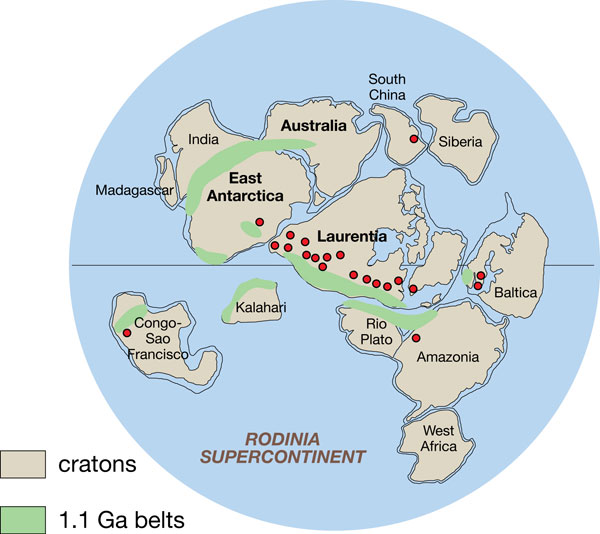

-541 Ma PALEOZOIC [unió dels continents per formar pangea amb les orogènies Caledònia i Herniciana per les col·lisions]
-256 MESOZOIC [Divisió de Pangea, Andes i Rocoses per subducció del pacífic)
-256 a -66 Formació dels Andes per subducció de la placa del Pacífic. Agafa la forma final al cretàcic. Orogènia Andina
-175 Ma Pangea es divideix entre Laurasia and Gondwana
-80 a -55 Ma Serralada nordamericana: Sierra Madre, Rocky mountains. Laramide orogeny
-66 CENOZOIC [ Àfrica i la índia pugen ja i xoca amb Lauràsia, orogènia alpina]
history of the earth | Geological history of the earth | simulació de l’evolució del planeta | els supercontinents | ICGC història geològica de catalunya
futura evolució dels continents. Aurica
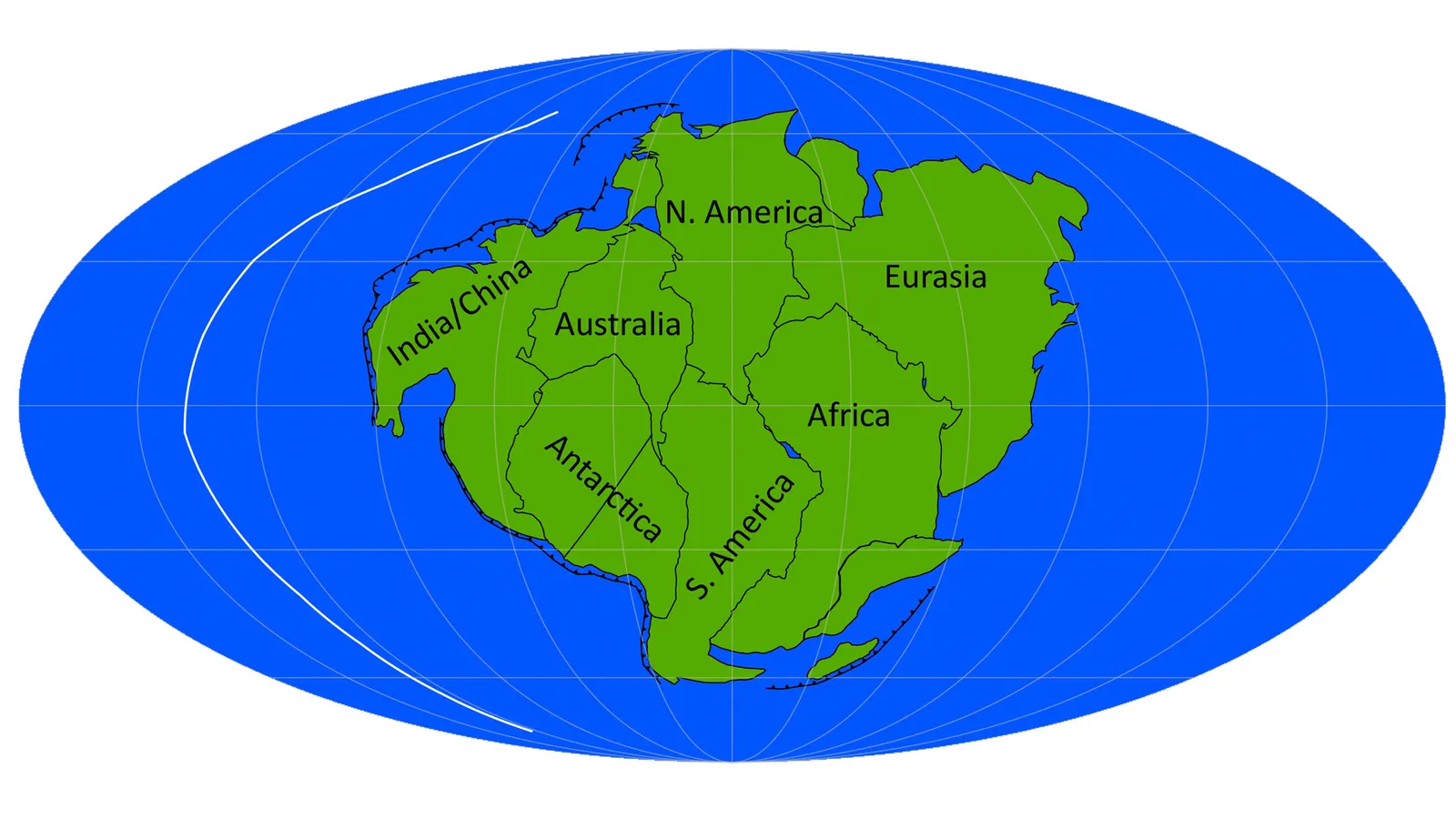
A partir de la hipòtesi de Wegener s’ha establert que la litosfera, amb l’escorça i el mantell residual, amb un gruix d’uns 100 km, està formada per 7 grans plaques que es desplacen, deriva continental, sobre el mantell. Quan convergeix un placa oceànica amb una continental ficant-se a sota, es forma una serralada litoral [Amèrica i el pacífic]. Quan topen dues plaques continentals es forma una cadena de muntanyes [Pirineus, Himalaia]. Quan divergeixen, es formen oceans, o rifts.
Les plaques es desplacen 3-7 cm cada any.
A les zones de contacte és on hi ha més activitat volcànica.
Els estudis de zones climàtiques proposen 15 biomes de 4 zones, fred, temperat, desert, tròpic. Les guies de naturalesa de les latituds temperades, que normalment no tenen ni desert ni tròpics, inclouen muntanya, rius i llacs, mars i costes. [Dins de cada bioma, l’hàbitat concret varia segons si la zona es troba a la plana, la muntanya, o al costat d’un riu]. La base de dades d’ecoregions ens dóna una idea de quin Bioma hi ha a cada lloc del món. aquesta classificació no dóna raó de quin % de la terra està ocupat per l’agricultura.
Sòl agrícola
La superfície del planeta és 29% terra, del qual un 71% seria habitable, la resta deserts, roques i platja. D’aquest 71% gairebé la meitat, un 46% està dedicat a l’agricultura, i la resta són 38% boscos, 14% arbusts, 1% aigua dolça i 1% edificis i xarxa viària. La terra agrícola es dedica en un 77% a pastures, que aporten un 18% de les calories i un 37% de les proteïnes, mentre que un 23% són conreus que aporten un 82% de les calories i un 63% de les proteïnes. (Our World in data)
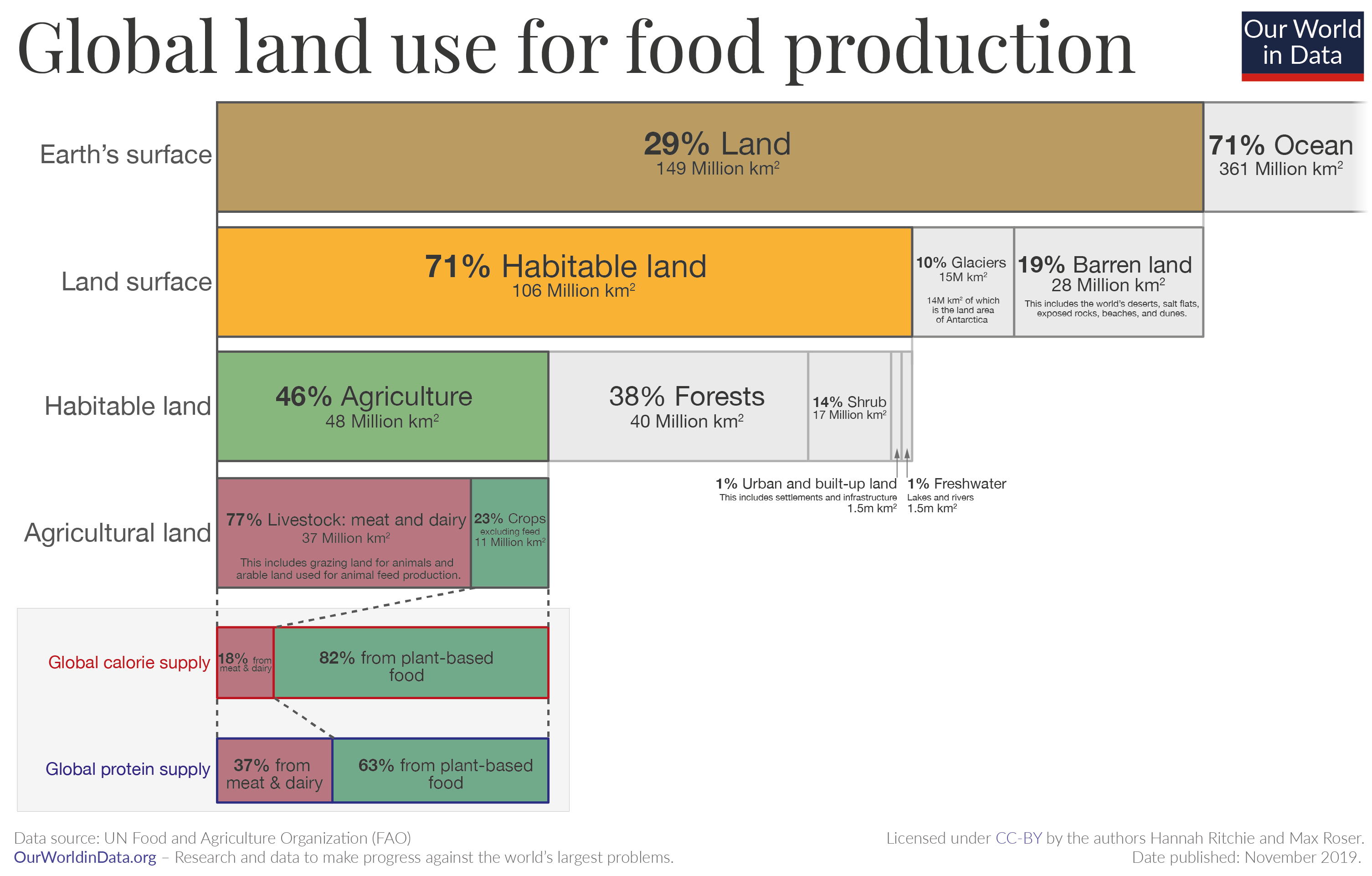
Es calcula que el 2020 la massa d’origen humà, edificis, carreteres, objectes és més gran que la massa biològica d’animals i plantes. (article)
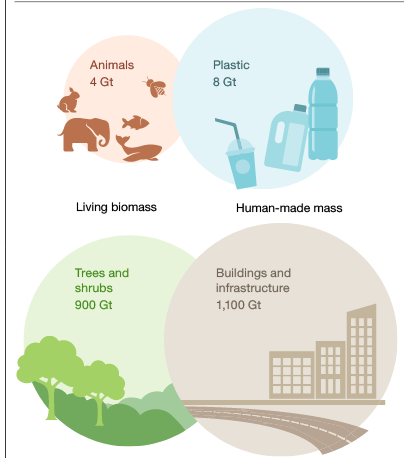
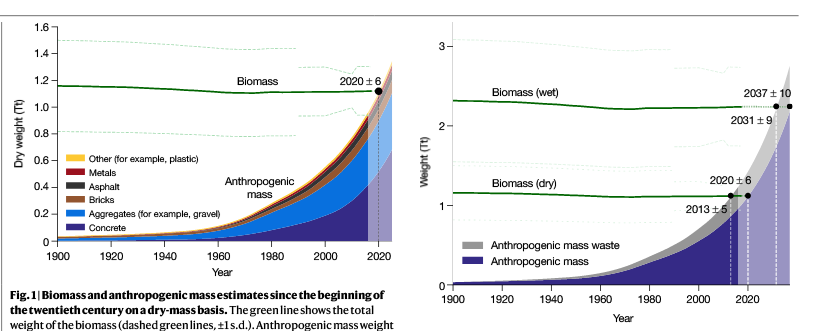
Hàbitats Corine: Dona una llista de totes les zones naturales d’europa. És incomplet ja que només recull les zones protegides i les dades també són incompletes, no sempre hi ha tota la vegetació i plantes. Consulta llista de països > hàbitats > pàgina amb mapa ecoregions i llista d’espècies
L’adaptació dels Habitats Corine a Catalunya té vuit apartats:
$sitecode=’B00010170′;
$lat=42.3008;
$lon=1.7566;
1 – Ambients litorals i salins
2 – Aigües continentals
3 – Vegetació arbustiva i herbàcia (Prats i pastures)
4 – Boscos
5 – Molleres i aiguamolls
6 – Roques, tarteres, glaceres, coves
7 – [no existeix]
8 – Terres agrícoles i àrees antròpiques
9 – Àrees talades o cremades
S’identifiquen fins a 600 hàbitats. Per a cadascun, la documentació en PDF identifica la fauna més comuna. De la web del Corinne es pot descarregar una base de dades on es llisten els biòtops d’Europa i les espècies animals i vegetals.
La guia Plantas y animales de Europa de Harry Garms, que és la que faig servir més per identificar animals i plantes divideix Europa en tres zones, Àrtic (isoterma 10º al juliol), temperada i mediterrània(Península Ibèrica, costa francesa, Itàlia, Balcans).
Relleu, Conques hidrogràfiques, pluviomnetria, vegetació
El visor del ICGC Cobertes del sòl identifica 41 tipus:
1. Àrees agrícoles: conreus, horta, vinyes, oliverars
2. Boscos
3. Àrees urbanitzades: casc urbà, zones verdes, industrials, esportives extracció minera o abocadors, xarxa viària i ferroviària
4. Masses d’aigua
N’ha identificat 134
i després:
La terra, geografia | Meteorologia | 5 tipus de clima, biomes | El clima de Catalunya
Els climes es corresponen aproximadament amb els biomes. Köppen els classifica segons la temperatura i precipitació mitjanes (seguit també a AB306):
A) tropical humit: > 18º. (Selva Tropical, Savana tropical). Els tròpics són les zones de la terra al voltant de l’equador, 23.5º amunt pel tròpic de càncer i 23.5 avall a l’hemisferi sud. Reben més exposició del sol i força pluges.
B) Sec (dry): àrid, Desert o Estepa [correspon a Estepa temperada]
C) Temperat (mild) mid-latitude: 0º<fred<18º, 10º<calor. Mediterrani amb pluges a primavera i tardor, Humit subtropical amb pluges monsons que serien vents estacionals deguts a la diferència d’escalfament entre mar i terra.
D) Fred (cold) mid-latitude: fred < 0º , 10º<calor. Continental humit amb estiu càlid, estiu fred, subàrtic
E) polar: calor < 10º, Tundra, capa de glaç i alta muntanya
Tenim 15 biomes:
El clima ha anat canviant al llarg de la història de la terra, per la combinació de canvis en la biosfera i activitat volcànica. Bàsicament la temperatura és el resultat del balanç entre la radiació solar que arriba, i la radiació que s’emet, que depèn de les propietats de l’atmosfera que fan un efecte hivernacle. La modificació del territori per l’agricultura, l’activitat humana industrial i les emissions de CO2 provoquen un escalfament global: evolució del clima. (Antropocè)
El clima a Catalunya (Geografia de Catalunya)

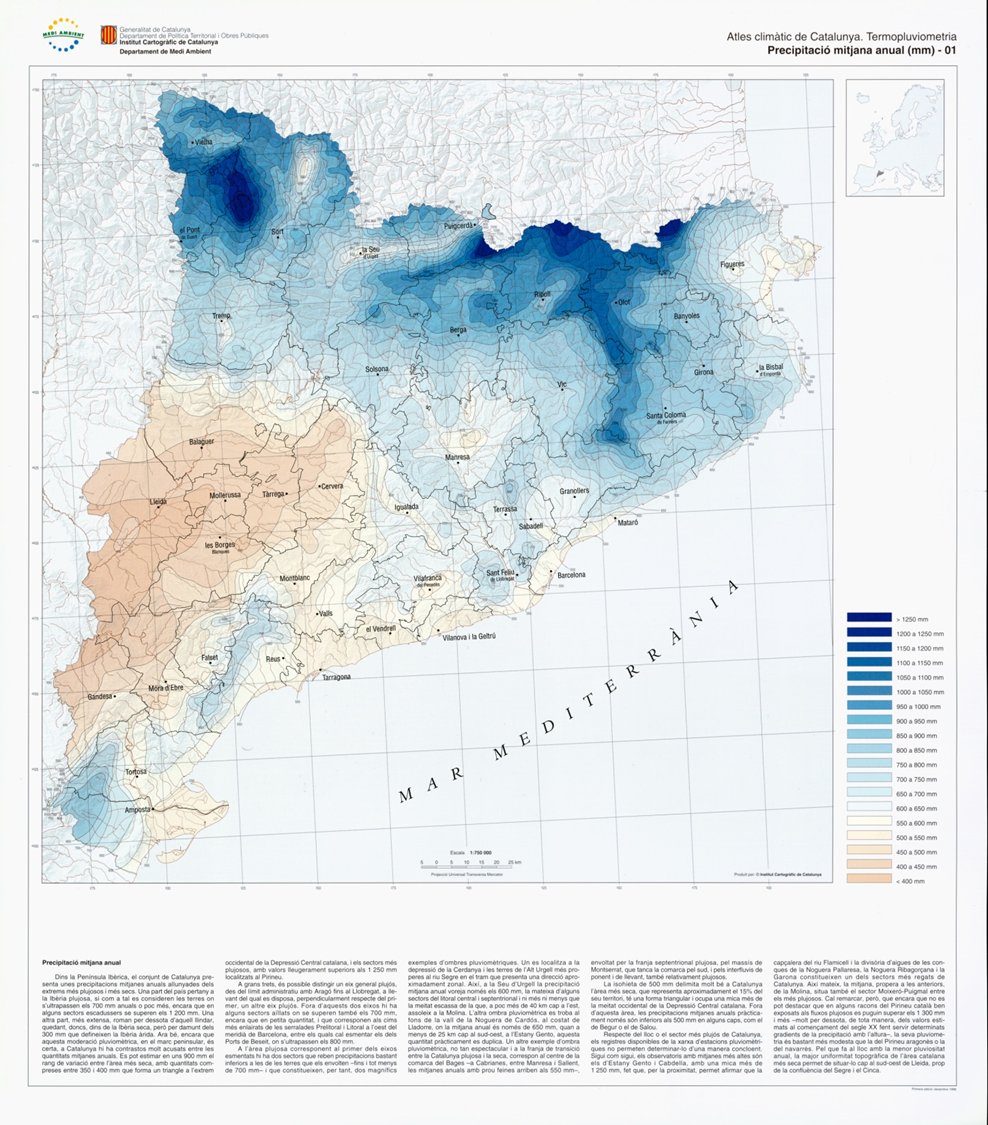
Un dels sentiments més agradables ha estat l’excitació creativa quan dissenyo alguna cosa. Tinc més o menys definit què vull aconseguir i faig esborranys, estudio materials, solucions, fins que trobo la que m’agrada i ho construeixo.
Camus deia al mite de Sisyphe que l’única pregunta filosòfica important era la del suïcidi, si valia la pena viure.
Una versió menys dramàtica seria què ens fa sortir del llit al matí i posar-nos en marxa.
En un post jo imaginava que haguéssim d’omplir un formulari sobre la “fe de vida” havent d’especificar què és allò que ens fa sentir vius:
El maig de 2019, al llarg d’un viatge pel Danubi en la furgo, algun matí em costava sortir del sac per posar-me en marxa, com si estigués perdut en un buit sense referents, la ruta planejada qüestionable. Val la pena l’esforç? Deixaria de viatjar en algun moment? Fa uns anys també em preguntava si algun dia deixaria de prendre notes sobre el que veig.
Arribem al món amb ganes d’explorar-lo. Ens en cansarem? En algun moment les destinacions inèdites ens semblaran que ja no valen la pena? Quan torno a una ciutat, què espero retrobar-hi? A Paris, ja necessito tornar a pujar a la torre Eiffel, o a NYC a l’Empire State Building. Budapest és molt agradable però per tornar-hi caldria una exposició especial, o una trobada de lindy, o que vulgués passar tres dies al Gellert de balneari, llegint.
I si deixo de viatjar i em quedo a casa, serà un enriquiment, o un seguir en vida mig anestesiat com en respiració assistida?
Alhora tenia present que cada instant i oportunitat de viure és preciós, com les efemeròpteres que volen un dia, poder donar una ullada a aquest món (Tisza)
Ikigai és un terme japonès que es podria traduir per “la raó de viure”, o “allò que ens fa sortir del llit cada dia. (juliol 2019).
Tot avui és com si tingués certa fatiga vital. La gent m’avorreix i em cansa, i alhora trobo a faltar una companyia. I si no hi és, en tinc prou amb el meu refugi? És potser un moment en que ja he recorregut la major part de sales del museu de la vida, n’he repassat algunes, i ja en tinc prou? Somio potser en possibles noves sales que no estan al meu abast?
Hipòtesi nebular concebuda per Swedenborg el 1734.
Tenia el problema que el sol no gira, no té moment angular com els planetes, i per això es va pensar si venia de dos cossos separats.
[esborrany]
1950 Teories sobre l’origen del planeta i el sistema solar, a partir de dades de meteorits, models de nucleosíntesi a les estrelles.
[ completar wikipedia]
The standard model for the formation of the Solar System (including the Earth) is the solar nebula hypothesis.[23] In this model, the Solar System formed from a large, rotating cloud of interstellar dust and gas called the solar nebula. It was composed of hydrogen and helium created shortly after the Big Bang 13.8 Ga (billion years ago) and heavier elements ejected by supernovae. About 4.5 Ga, the nebula began a contraction that may have been triggered by the shock wave from a nearby supernova.[24] A shock wave would have also made the nebula rotate. As the cloud began to accelerate, its angular momentum, gravity, and inertia flattened it into a protoplanetary disk perpendicular to its axis of rotation. Small perturbations due to collisions and the angular momentum of other large debris created the means by which kilometer-sized protoplanets began to form, orbiting the nebular center.[
[ una mica és com endevinar què hi ha en una capsa tancada picant i sacsejant-la des de fora]
Des de l’antiguetat es tenia evidència de certa activitat interna amb els volcans i terratrèmols
1665 A l’obra Mundus subterraneus Athanasius Kircher l’imaginava amb coves que podien contenir aigua o foc.
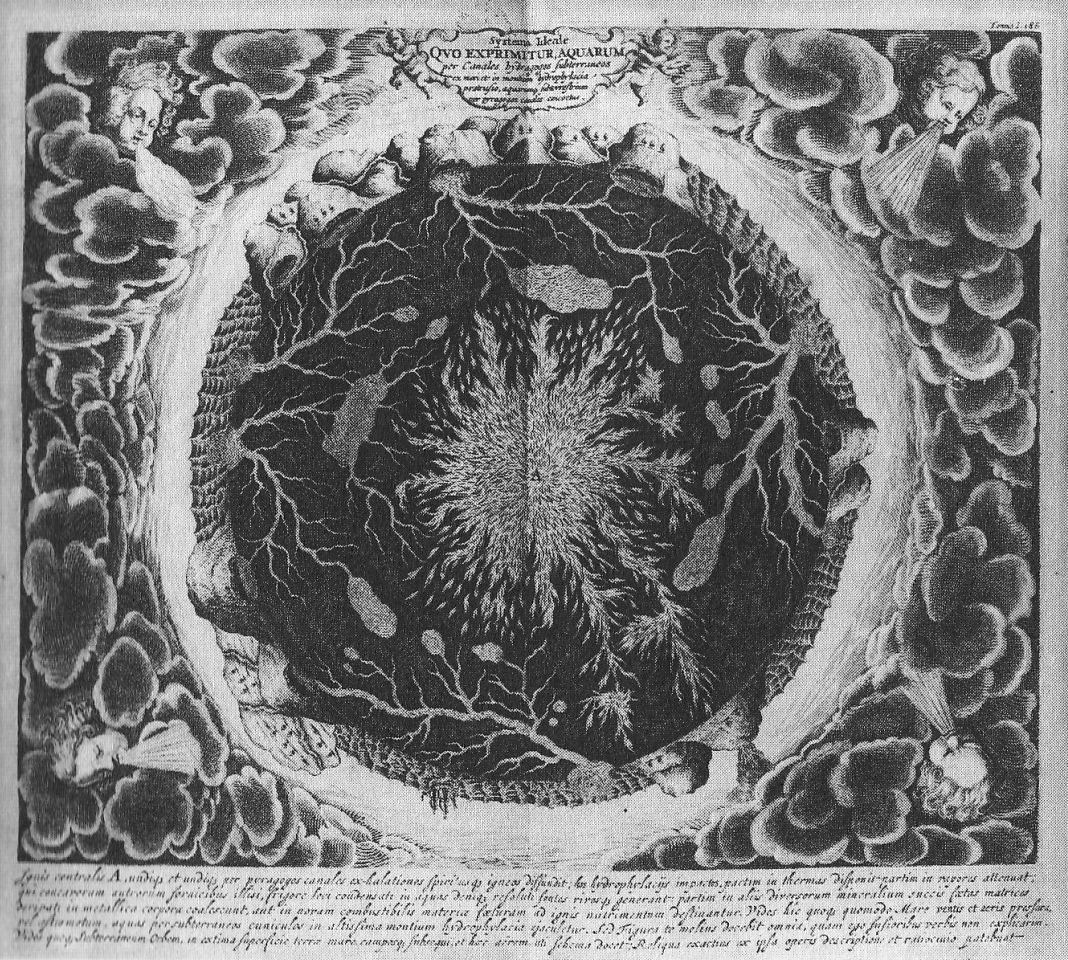
1798 Cavendish calcula la densitat mitjana com a 5.5 vegades la de l’aigua
1864 Jules Verne publica el Voyage au centre de la terre
1915 Hipòtesi de les plaques tectòniques de Wegener
1920 Harold Jeffreys observa que a cada terratrèmol hi ha una zona de la terra on no arriben les ones, d’on es pot deduir que hi ha un nucli líquid. [AD Ciencia: 1900 Richard Oldham observa dos tipus d’ones en els terratrèmols, les P, que travessen sòlids i líquids, i les S que només travessen sòlids. Les ones P arriben més tard del compte, cosa que implicaria un nucli molt dens.
1936 Inge Lehman proposa que hi ha un nucli intern sòlid i un extern líquid en detectar ones P febles.
La densitat mitjana de la terra a partir de Newton ha de ser de 5.5 mentre que la mitjana de les roques és de 2.7. Això vol dir que el nucli ha de contenir elements més pesants. Sabem també que hi ha magma fos per l’activitat volcànica.
D’aquí es surt un model que proposa:
1915 Alfred Wegener fou un meteròleg interessat en el clima de temps passats que observà la presència de roques sedimentàries formdes en clima càlid es trobaven ara en climes freds i a l’inrevés. Adonant-se de la coincidència de forma de les costes d’Amèrica del sud i Àfrica, proposà que fa 250M d’anys els continents havien estat units.
La similitud de fòssils a costes de continents que ara estan separats s’afegeix a l’argument de coincidència de forma.
D’altres fets que ho corroboren son les similituds entre les muntanyes de Caledònia, a Escòcia, Groenlàndia i els Apalatxes.
Geodinàmica interna
Les forces de pressió a les capes sedimentades les deformen, ja sia com a plecs (fold), o com a falles (fault).

La terra, geografia | Roques i minerals | Col·lecció
s. xviii
[Abans encara es considerava la terra literalment sortida del diluvi biblic]
1770 Werner creia que el planeta havia estat tot cobert d’aigua i que el granit havia cristalitzat a sota (neptunista).
1777 Desmarest, vulcanista, que les roques eren el resultat de la solidificació del magma (Basalt d’Auvergne i La Giant’s Causeway a Irlanda).
1785 James Hutton estudià les muntanyes d’Escòcia va identificar també els efectes del metamorfisme i la sedimentació. El cicle de els roques és que quan le sígnees queden exposades a l’aire lliure es fragmenten i es converteixen en sedimentàries. Tant les ígnees com sedimentàries poden ser objecte de calor i pressió i covnertir-se en metamòrfiques.
Roques ígnees: solidificació del magma: granit, basalt, obsidiana
Roques metamòrfiques: modificació d’ígnees i sedimentàries per calor o pressió: gneis, marbre, esquists
Roques sedimentàries: arenisca, lutita, calcària
La forma de la terra: (EB) Pitàgores i Hiparc creien que la terra era rodona per analogia amb la lluna i el sol. El segle 3 BC Eratòstenes observà que al solstici d’estiu a les dotze, a Syene (actualment Assuan), el sol queia perpendicular mentre que a Alexandria formava un angle de 1/50, i estimant pel temps a arribar-hi en camell en uns 5000 estadis la distància entre les dues ciutats, tenim 50×5000, 250.000 estadis que amb uns 185 m per estadi dóna uns 46.000 km, que aproxima prou bé els 40.000 reals.

1519-1522 Magallanes dóna la volta al món
1670 1800 Geodèsia, mesures d’arc de meridià que estableixen que la terra és un elipsoide
Víctimes causades per l’home en general : guerres, genocidis
ANTIGUITAT
Pèrsia i Grècia
549 BC–530 BC Conquestes de Cirus el gran. Pèrsia. 100m.
499 BC–449 BC Guerres Grècia-Pèrsia. 300m
336 BC–323 BC Campanyes Alexandre el Gran. Orient. 142m
ROMA
264 BC–146 BC Guerres Púniques. Roma-Cartago. 1.5M
113 BC–101 BC contra Cimbris i Teutons. 500m.
58 BC–50 BC Gàl·lies. 1M
60–61 AD Iceni, tribus celtes anglaterra. 150m
66–136 Contra els jueus. 1.5M
269 AD Contra els gots. 320m
277 Guerra de Probus contra els Germànics 400m
376–382 Contra els gots 40m
395–453 Invasions dels huns procedents de l’Àsia Central. 165m
Índia
262 BC–261 BC Guerra Kalinga. Imperi Maurya contra Kalinga. Índia. 175m.
XINA
230 BC–221 BC Guerres d’unificació Qin contra Han, Zhao, Yan, Wei, Chu i Qi. Xina. 700m
184–280 AD Guerra dels tres regnes al final de la dinastia Han. Xina. 36M
EDAT MITJANA
Islam
629–1050 Guerres Bizanci-Islam. 2M
711–1492 Reconquista. Espanya i portugal contra estats islàmics. 8.5M
Croades
1095–1291 Croades. Bizanci contra Seljúcides, cristians contra musulmans. 2M. Orient.
1208–1229 Croada dels albigesos. Estats papals contra els càtars. França. 500m.
XINA
598–614 Guerra Xina Sui-Corea Goguryeo. 300m.
755–763 Rebel·lió An Lushan. Dinastia Tang xinesa contra l’estat Yan. 30M
993–1019 Imperi Lieao contra Corea Goryeo. 90m.
1075–1077 Entre imperi Song i el regme Dai Viet. Xina-Vietnam. 600m.
MONGOLS, ÀSIA CENTRAL
1206–1368 Imperi Mongol contra diferents regions d’Euràsia. 30M
1370–1405. Conquestes de Timur. Euràsia. 15M
GRAN BRETANYA
1296–1357 Guerra de la independència d’Escòcia. 100m
1455–1487 Guerres de les roses, House of Lancaster, House of Tudor contra House of York. 90m
1337–1453 Guerra dels cent anys pel control de França, els Plantagenet anglesos (d’origen francès) que reclamaven el tron de França que havia quedat buit pels Capets, contra els Valois que l’acabaran retenint. 3M.
EDAT MODERNA
Europa
1494–1559 Guerres italianes, pel control d’Itàlia entre els Valois aliats amb l’imperi otomà) contra els Habsburgs del sacre Imperi germànic i espanya. 350m.
1524–1525 Guerra dels pagesos alemanys contra la lliga Suàbia. 100m.
1562–1598 Guerres de religió a França, catòlics contra protestants hugonots. 3M
1618–1648 Guerra dels 30 anys, inicialment un conflicte entre estats alemanys catòlics i protestants, amb intervenció posterior dels Habsburgs (Espanya i Àustria) i els Borbons. CentreEuropa. 8M.
1635–1659 Guerra franco-espanyola. 200m
1655–1660 Diluvi, Polònia contra Suècia i Rússia. 3M.
1672–1678 Guerra franco-holandesa. 342m
1688–1697 Guerra dels 9 anys, França contra la lliga dels Habsburg. 680m.
1700–1721 Gran guerra del nord. Rússia i altres contra l’imperi suec. NE d’Europa. 350m.
1756–1763 Guerra dels set anys, Gran Bretanya i Prússia contra França i Espanya es disputen l’hegemonia a Europa i a Amèrica. 1.2M
España
1519–1632 España conquerint l’imperi Azteca, Mèxic. 2.3M
1519–1595 Conquista Yucatán, contra els maies. 1.4M
1533–1572 Conquista imperi Inca, Perú. 8.4M
1568–1648 Guerra dels 80 anys per la independència d’Holanda + aliats contra l’imperi espanyol. 600m
1701–1714 Guerra de Successió espanyola. Borbons contra l’Aliança (i Catalunya). 1M.
Gran Bretanya
1585–1604 Guerra angloespanyola. 138m
1593–1603 Guerra dels 9 anys, rebel·lió d’Irlanda contra Anglaterra. 130m.
1639–1651 Guerra dels tres regnes, reialistes anglesos contra parlamentaris, escocesos i irlandesos. 876m.
Orient
1521–1566 Campanyes de Suleiman el magnífic. Orient. 200m
1683–1699 Gran guerra turca, l’imperi otomà contra la lliga santa. Europa de l’est. 380m.
Àsia
1592–1598 Invasió de Japó a Corea Joseon (i Xina Ming). 1M.1616–1683 Transició Ming a Qing, l’antiga dinastia contra els Shun, Xi. 25M
1771–1802 Rebel·lió Tây Sơn, Tay, i pirates xinesos amb suport anglès contra els Nguyễn, Trịnh, Lê, Qing xinesos i suport francès. Vietnam. 1.6M
Índia
1658–1707 Guerra de l’imperi Mogol contra l’imperi Maratha. Índia. 5M.
1741–1751 Imperi Maratha conta els Nawabd e Bengala. 400m.
Xina
1765–1769 Guerra Xina-Burma. 70m
EDAT CONTEMPORÂNIA
Amèrica
1775–1783 Revolució USA contra l’imperi britànic. 100m
1802–1803 França contra Haiti i UK. 135m
1808-1833 Guerres d’independència a Amèrica llatina contra Espanya. 600m
1861–1865 Guerra civil americana, Confederats contra Unió. 800m
1862–1867 Mexicans republicans contra Imperi Mexicà i França. 50m
1864–1870 Paraguai contra Triple Aliança Argentina, Brasil, Uruguai. 800m
1868–1878 Cuba (i USA) contra Espanya. 241m
1870s–1884 Conquesta del desert, Argentina contra el poble Mapuche a Patagònia. 35m
1895–1898 Guerra de la independència de Cuba, Cuba (i USA) contra Espanya. 362m
1896-1897 Guerra entra els Canudos i la República del Brasil. 30m
1899–1902 Guerra dels 1000 dies entre conservadors i liberals a Colòmbia. 120m
1910–1920 Revolució mexicana, guerra civil. 1M
Xina i Japó
1794–1804 Rebel·lió del Lotus blanc contra Qing. 100m
1850–1864 Els rebels Taiping contra Qing. 50M
1854–1856 Rebels del turban vermell contra Qing. 1M
1854–1873 Rebelio Miao contra Qing. 3M
1855-1868 a Guangdong, entre Hakka i Punti. 1M
1856–1873 Rebel·lió Panthay, els musulmans Hui contra Qing. 1M
1862–1877 Revolta Dunga, Hui i Kashgaria contra Qing. 17M
1894–1895 Primera guerra sino-japonesa, Japó contra Qing. 48m
1899–1901 Revolta dels bóxers xinesos contra les potències estrangeres. 100m
1904–1905 Guerra Russo-japonesa a Manxúria i Corea. 150m
1911 Revolució de 1911 contra els Qing que acaba amb 2000 anys de govern imperial. 220m
Àfrica i Orient
1798–1801 campanya de França contra otomans i anglesos a Egipte i Síria. 65m.
1810s–1840s Mfecane. Conflictes entre els zulu i altres ètnies. Sudàfrica. 1M
1830–1903 Conquesta francesa d’Algèria. 700m
1899-1902 Guerra sudafricana (2ª guerra boer) entre UK i la república sudafricana+ l’estat lliure d’Orange. 80m
1915-1917 Genocidi armeni per l’imperi otomà. 1M
1914-1922 Genocidi dels grecs d’Anatòlia per l’imperi otomà. 600m
1915-1919 Genocidi d’assiris per l’imperi otomà. 400m
Europa
1803-1815 Guerres napoleòniques. Europa i Rússia. 6M
1820-1876 Guerres Carlistes. Espanya. 200m
1821–1831 Guerra d’independència Grega contra l’imperi otomà. 170m
1853–1856 Guerra de Crimea Rússia contra imperi otomà ( amb suport de França i UK) 600m
1866 Guerra Imperi austríac contra Prússia i estats alemanys. 40m
1870–1871 Guerra entre França i Prússia, estats alemanys. 433m
1912–1913 Guerres balcàniques, Grècia, Sèrbia, Montenegro i Bulgària contra l’imperi otomà. 140m
Índia
1857–1858 Amotinament Sepoy contra la British India Company. 1M
Resta d’Àsia
1873–1914 Guerra entre Holanda i el sultanat Aceh a Indonèsia. 100m
1899–1912 Filipines contra els USA. 234m
SEGLE XX
Europa
1914–1918 WWI. França, Rússia, UK contra Alemanya, Àustria i imperi otomà. 30M
1917–1922 Guerra civil russa entre l’exèrcit roig bolxevic i l’exèrcit blanc. 9M
1936–1939 Guerra civil Espanyola, nacionalistes de Franco contra Republicans. 1M
1939-1945 WWII
1946–1949 Guerra civil grega, govern contra partit comunista. 158m.
1988–fins avui. Conflicte Nagorno-Karabakh, separatistes armenis contra Azerbaidjan 50m
1991–1995 Guerra de Bòsnia contra Sèrbia. 100m
1932-1933 Holodomor, 5M de morts per fam a Ucraïna sota la USSR
1939-1945 WWII 85M
1937–1945 Segona guerra Sino-japonesa ). 22M
1939–1940 Guerra d’hivern entre Finlàndia i la USSR 194m
1940–1941 Guerra greco-italiana. 27m,
1941–1944 Finlàndia i 3rReich contra USSR. 387m
1945 Guerra Rússia Japó a Manxúria i Mongòlia. 95m
1941-1945 Shoah, extermini dels jueus pels nazis. 6M
1941-1945 Maltractament dels presoners russos pels nazis. 3.3M
1939-1945 Crims nazis contra població civil Polonesa 3M
1935-1945 Genocid nazi sobre la població romaní. 300m
Orient
1918–fins avui Separatisme kurd a Iran (tribu Shekak contra dinastria Qajar). 50m
1918–2003 Conflicte Iraq – kurds. 300m
1921–fins avui. Conflicte Turquia-Kurds. 100m
1948–fins avui. Conflicte àrab-israelí. 116m
1962–1970 Guerra civil al nord del Yemen, Regne de Yemen i Aràbia saudí contra la República àrab del Yemen i la UAR. 200m.
1975–1990 Guerra civil al Líban. 150m
1978–fins avui Conflicte Afganistan, Rússia i després USA. 2M
1978–fins avui. Conflicte Turquia Kurds. 45m
1980–1988 Guerra Iran-Iraq. 500m
1990–1991 Guerra del Golf, Iraq contra USA i coalició. 40m
1991 Rebel·lió a Iraq. Sha’aban Intifada. 200m
Àfrica
1921–1926 Guerra del Rif entre Espanya i Marroc [avi Josep]. 30m
1923–1932 Itàlia contra Senussi a Líbia. 40m
1935–1936 Segona guerra Itàlia-Etiòpia. 278m
1947–1948 Insurgència Madagascar contra França. 80m
1954–1962 Guerra d’independència d’Algèria contra França. 1M
1955–1972 Guerra civil entre Sudan nord (islàmic) i rebels del Sud (més occidentals) que se senten discriminats. 500m
1960–1965 Crisi del Congo, DRC amb suport belga i americà contra rebels Simba i Kwilu. 100m
1961–1974. Guerra d’independència d’Angola contra Portugal i sudàfrica. 100m
1964–1974 Guerra d’independència de Moçambique, FRELIMO contra Portugal. 88m
1967–1970 Guerra de Biafra atacats per Nigèria. 3M
1974–1991 Guerra civil a Etiòpia, Derg, PEDR, i Cuba contra rebels anticomunistes. 1.5M
1975–2002 Guerra civil a Angola, MPLA vs. UNITA. 504m
1981–1986 Guerra Uganda (ULNF i Tanzania contra National Resistance Army) . 500m
1983–2005 Segona guerra civil al Sudan. 2M
1986–fins avui. Guerra civil a Somàlia. 500m
1987–fins avui. Lord’s Resistance Army vs. Congo i República Centreafricana. 500m
1991–2002. Guerra civil Algèria. 200m
1991–2002 Guerra civil a Sierra Leone. 300m
1993–2005 Guerra civil a Burundi, contr rebels Hutus i Tutsis. 300m
1994 Genocidi de Ruanda dels Hutus sobre els Tutsis. 800m
1996–1997 Primera Guerra del Congo. Zaire contra AFDL. 800m
1998–2003 Segona guerra del Congo. 4.5M
Xina
1927–1949 Guerra civil Xinesa, ROC contra PRC 10M
Amèrica
1932–1935 Guerra del Chaco entre Bolívia i Paraguai. 110m
1948–1958 La Violencia, Conservadors contra liberals a Colòmbia. 190m
1964–fins avui. Colòmbia contra les guerrilles d’esquerra i paramillitars de dreta, 220m
1979–1992 Guerra civil a El salvador, govern contra FMLN. 80m
1980–fins avui. Conflicte armat Perú, PCP-SL and MRTA. 70m
Àsia
1946–1954 Primera guerra d’indoxina, França contra Việt Minh, Lao Assara, i Khmer Issarak. 400m
1948–fins avui. Myanmar contra diverses ètnies insurgents. 210m
1950–1953 Guerra de Corea entre el Nord comunista(suport USSR) i el sud (suport USA). 4M
1955–1975 Guerra entre Vietnam del Nord contra Vietnam del Sud i USA. 4M
1969–2019 Conflicte Moro a Filipines, grups jihadistes contra Bagsamoro. 120m
1969–fins avui, Filipines contra el partit comunista. 43m
1975–2007 Insurgència dels Hmong a Laos contra Laos i Vietnam. 100m
1983–2009 Guerra civil a Sri Lanka vs. Tamil Tigers. 100m
1975-1979 Genocidi de la població a Cambodja per part dels Khmer. 2M
Índia
1946–1948 La partició de la Índia, conflicte entre hindús i musulmans, Índia i Pakistan 1M
1947–fins avui. Conflicte a Kashmir entre Índia i Pakistan. 100m
1948 Índia annexa Hyderabad. 240m
1971 Independència de Bangladesh amb suport de la Índia, contra Pakistan. 3M
SEGLE XXI
Orient
2001–fins avui. Lluita contra el terrorisme. 1M
2003–2011 Guerra de l’Iraq. 600m
2011–fins avui. Guerra Civil a Síria, Estat contra ISIL contra forces demcràtiques. 610m
2013–2017 Guerra a l’Iraq contra ISIL. 200m
Àfrica
2003–fins avui. Guerra a Darfur, Sudan, SRF vs. Sudan vs. UNAMID. 300m
2009–fins avui. Aliança de forces contra els senyors de la guerra de Boko Haram a Nigèria. 350m
2014–fins avui. Guerra civil al Yemen. Yemen’s Supreme Political Council vs. Hadi Government, coalició Saudí, moviment del sud amb UAE i Al-Qaeda. 377m.
2020–fins avui Guerra a Tigray, UFEFCF contra Etiòpia i Eritrea. 500m
Amèrica
2006–fins avui. Mèxic contra els càrtels de la droga. 62m.
Àsia
2017-fins avui. Genocidi Rohingya per Myanmar. 43m
Europa
2014–fins avui. Rússia contra Ucraïna. 100m
En vermell els conflictes actuals wikipedia (Myanmar i Afganistan es remunten al sXX)
2013 costa de Barcelona, caiac
juny 2019: dues picades

Comissionat de les UN, llista de les crisis de refugiats
Actualment 25.4 M
1845-1849 Gran fam a Irlanda. 4 anys. 1M
1914-1918. WWI 4 anys. 10M
1939-1945 WWII 6 anys. 60M
1947-1948 Partició de la Índia. 1 any. 15M
1947-fins ara. Conflicte Israel Palestina. 75 anys. 1M
1950-1953. Guerra de Corea. 3 anys. 3M
1954-1962 Guerra d’Algèria. 6 anys. 1M
1971 Independència de Bangladesh. 8mesos. 9M
1975-2000 3a Guerra d’Indoxina, després que s’instaurin governs comunistes. 25 anys. 3M
1977-1992 Guerra civil a Moçambique. 15 anys. 1.7M
1978-1989 Guerra USSR-Afganistan. 11 anys. 6.2M
1991-2001 Guerra a l’antiga Iugoslàvia. 10 anys. 2.4M
1991 Revoltes Iraq. 8mesos. 1.8M
1991-fins ara Guerra civil Somàlia. 31 anys. 1M
1994-1996 Genocidi de Ruanda. 2 anys. 2M
2003-2012 Guerra Iraq. 9 anys. 2.2M
2011-fins ara. Guerra civil a Síria. 11 anys. 6.7M
2011-2020 Guerra civil al Sudan. 9 anys. 1.5M
2011 Guerra civil a Líbia. 8 mesos. 1M
2014-fins ara. Fugitius de la revolució Bolivariana a VEnezuela sota Chavez i Maduro. 8 anys. 7M
2016-fins ara. Genoci Rohingya. 6 anys. 1.3M
2022-fins ara. Guerra Rússia Ucraïna. 8 mesos. 8M
783 million people live below the international poverty line of US$1.90 a day
World poverty clock: presenta una estimació de quanta gent cau o surt de la pobresa en temps real.
Hi ha uns 600M de persones, aprox un 10%
http://blog.caritas.barcelona/
25% gent en risc d’exclusió. L’ascensor social està avariat, 15% treballadors pobres, 175.000 persones > 65 anys se senten soles, 100.000 inmigrants en situació irregular
Rajada, família rajidae

20/06/2019, platja Bogatell
En la nedada després de córrer, i després d’esquivar meduses marrons, he vist una rajada d’uns 40 cm al fons a la sorra.
Hi ha 8 grans reialmes o ecozones, que es divideixen en unes 867 ecoregions segons el WWF. (Resolve). Aquestes es poden classificar en 15 biomes terrestres. [Geografia] | query ecoregions [ pendent de fer sortir mapa sencer] | ntroduides per Alfred Russell Wallace i Miklos Udvardy (Ciències de la vida sXIX)
Identifiquem 33 grans bioregions als 8 Reialmes: Paleartic, Neartic, Afrotropic, Indomalai, Neotropic, Australasia i Ocenia, Antàrtic
[La clau als Ecocodis és PA NA AT IM NT AA OC]
Australasia
Australasia comprises Australia, New Zealand, the island of New Guinea, and neighbouring islands in the Pacific Ocean. Most of Australasia lies on the southern portion of the Indo-Australian Plate, flanked by the Indian Ocean to the west and the Southern Ocean to the south.[73] The bulk of Australasia sits on the Indo-Australian Plate, together with India.
BIOMES (Resolve)
(AB 298) Excepte la Tundra, Taiga i deserts, tots els biomes tenen agricultura o ramaderia.
Ecocodis dels biomes a les ecoregions:
I una classificació detallada en 867 ecoregions dins de les quals hi ha diferents hàbitats, per exemple boscos i matollars al mediterrà.
Dins de cada ecoregió, per exemple el emditerrà, hi pot haver diferents hàbitats: muntanya, vora del riu, matollar.
Una interpretació arbitrària
Què m’evoca a mi el gravat? Un àngel demiürg, que projecta i construeix. El compàs que sosté la mà dreta suggereix un plànol o projecte. El sòlid geomètric i el quadrat màgic on files i columnes sumen 34, fan veure que la matemàtica i la geometria són presents en el projecte. L’escala, el martell, regla, el ribot, la serra, els claus, indiquen que ja ha fet alguna cosa. La balança, que s’han mesurat els materials amb cura. L’àngel està cansat, i recolza el cap a la mà esquerra. La mirada expressa cansament i potser certa frustració pel resultat, però alhora mira lluny i amunt, com imaginant un nou projecte, millor. Una barreja d’acceptació del resultat i alhora la determinació a fer-ho millor. La campana i el rellotge de sorra, que el temps per acomplir-ho és limitat.
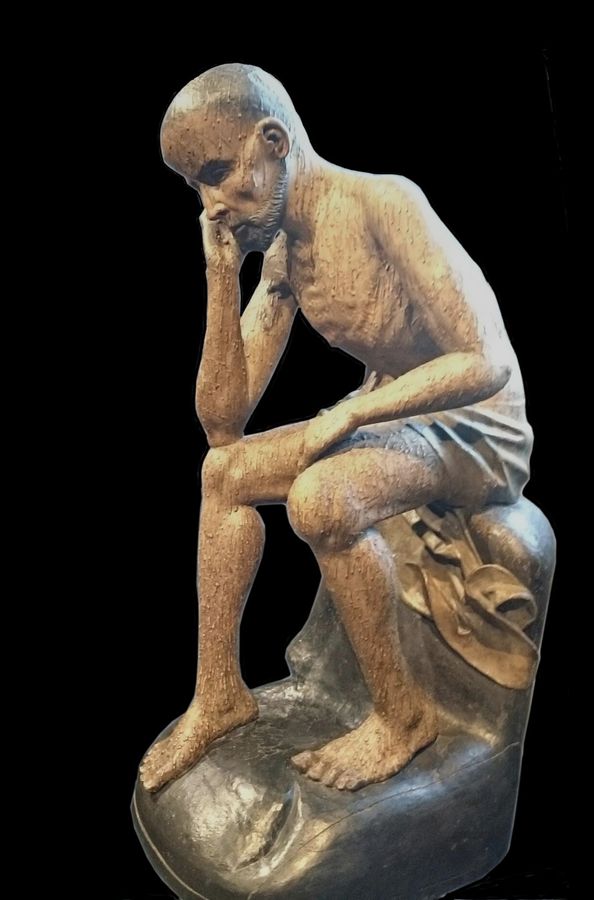
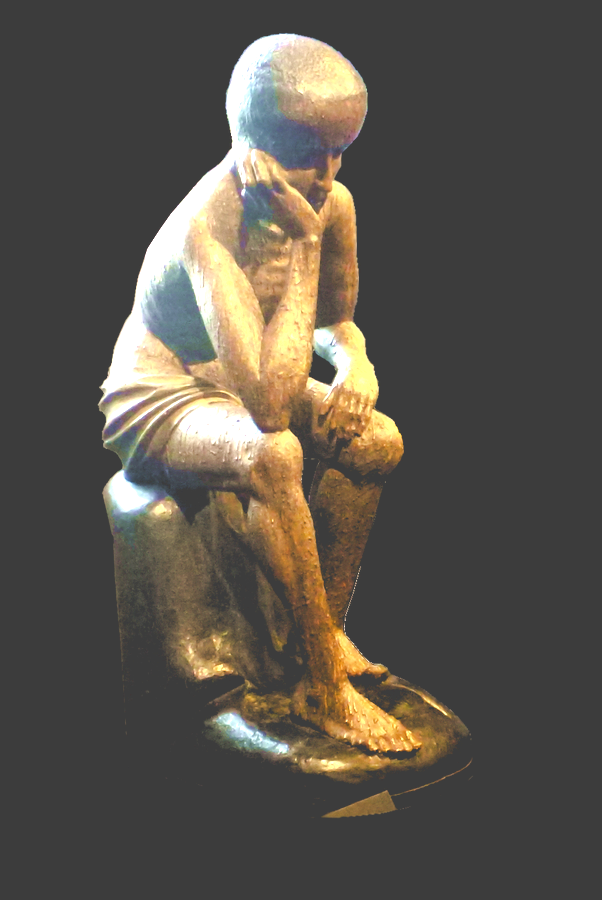
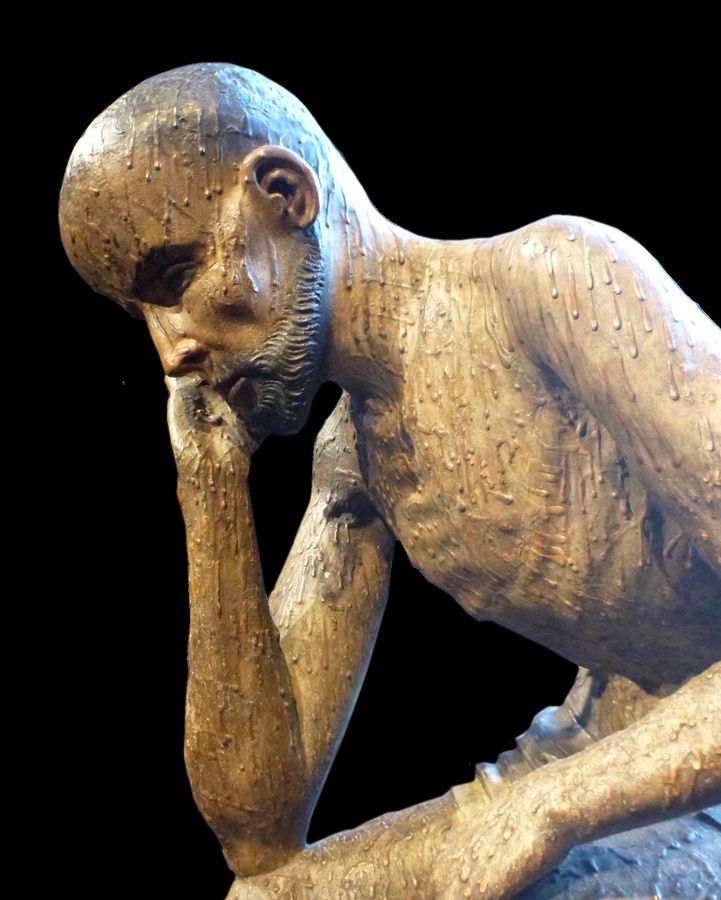
Al Museu Nacional de Varsòvia, a la col·lecció medieval, hi ha una talla de fusta que representa Crist assegut, amb el cap recolzat a la mà, pensarós. Un crani gran, i la pell com coberta de llàgrimes. No se’n coneix l’autor, la data, 1502. La immensa majoria de les escultures de Crist el mostren crucificat i, algunes, les pietats, mort en braços de la mare de Déu. No n’havia vist mai cap que el representés assegut, cavil·lant, sense cap signe de divinitat o poder, profundament humà, potser afligit pel que l’espera, o pel dubte.
2023
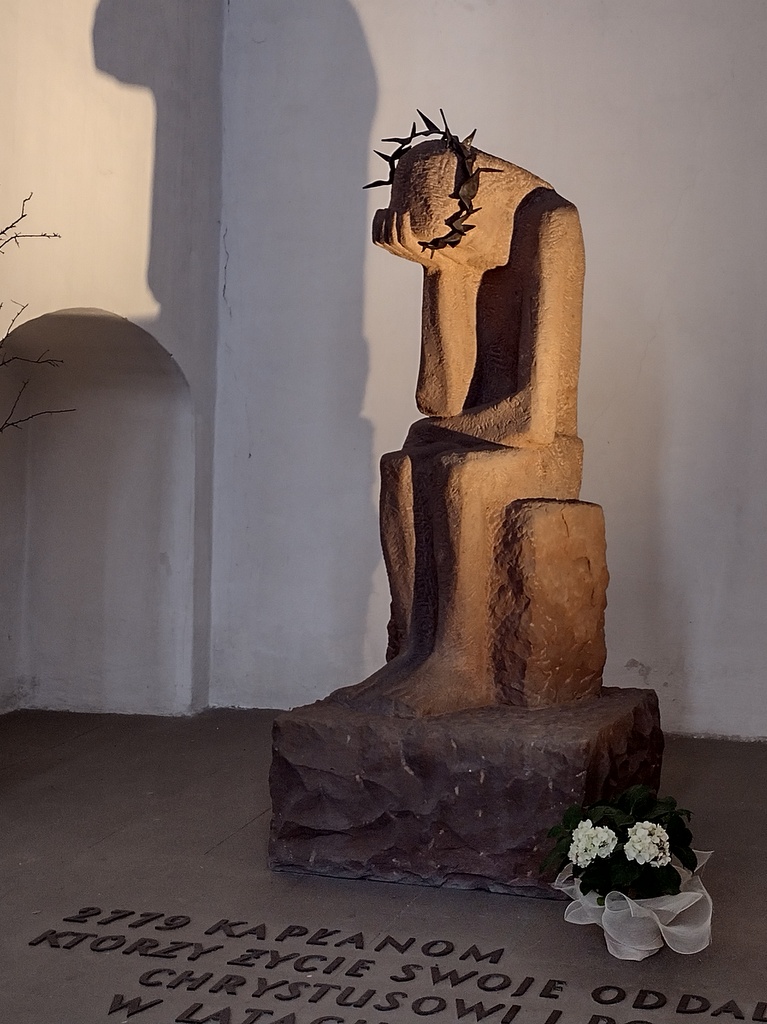
Escultura moderna a la catedral de Sta. Maria a Gdansk, vista el 6/7/2023. Potser és un tema particular de l’escultura religiosa polonesa?
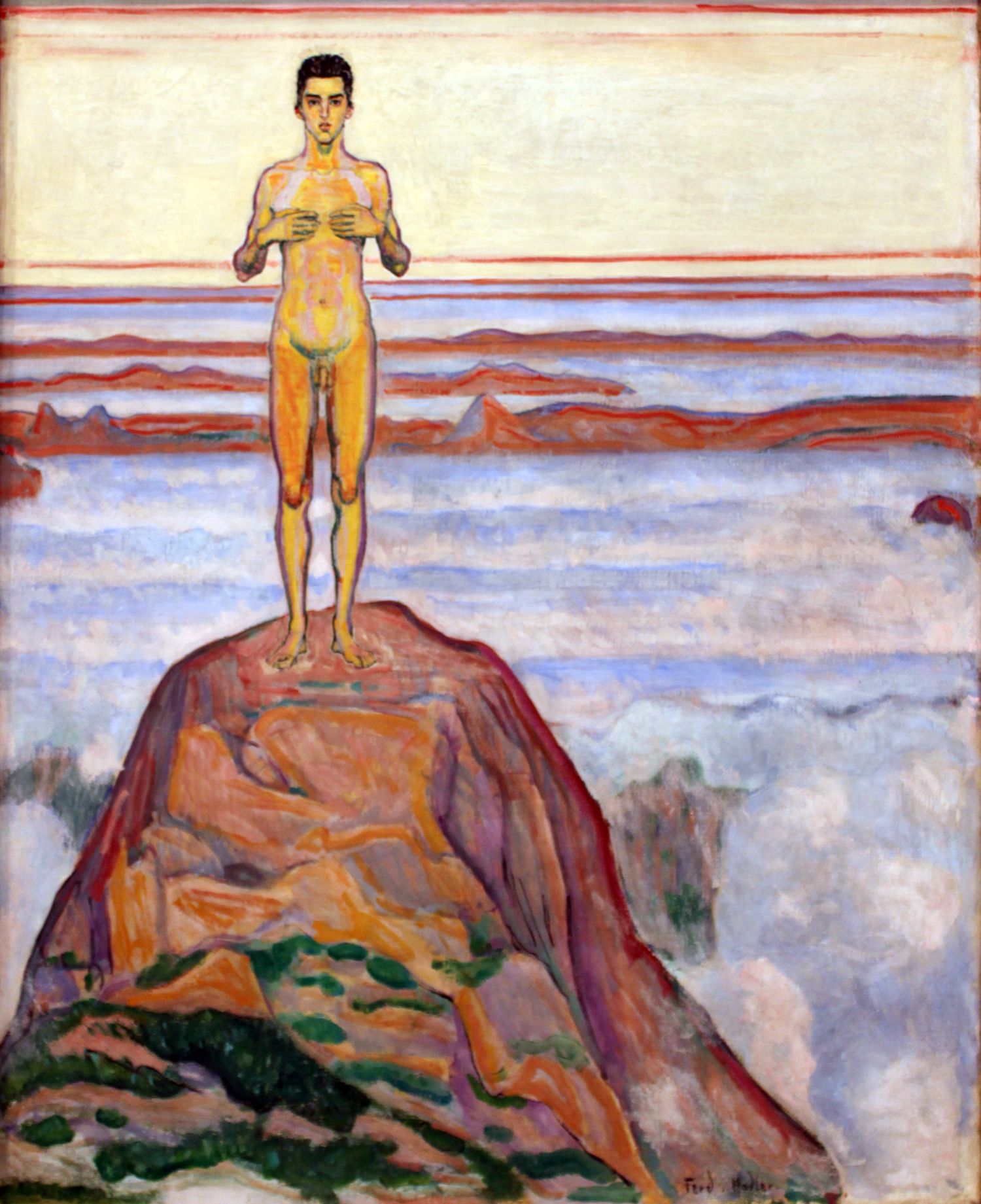
La família de Mark Rothko, jueva, emigrà als USA el 1913, procedent de Vitebsk [d’on també era Chagall].
El 1923 comença a estudiar art, després de deixar Yale.
Influït pels expressionistes i Paul Klee, es troba amb el cercle de Milton Avery on també hi ha Barnett Newmann. Explorà l’expressionisme i surrealisme.
El 1946 comença a treballar en les superfícies de colors, [Abstract expressionism]. Escrivia: I think of my pictures as dramas; the shapes in the pictures are the performers. Deixa de posar títols. En diu multiforms. “Rothko’s method was to apply a thin layer of binder mixed with pigment directly onto uncoated and untreated canvas and to paint significantly thinned oils directly onto this layer, creating a dense mixture of overlapping colors and shapes. His brushstrokes were fast and light, a method he would continue to use until his death”.
Viatges a Europa. Commogut per la espiritualitat de Fra Angelico.
Rebutja l’etiqueta de pintor abstracte i afirma que el seu interès és “… only in expressing basic human emotions—tragedy, ecstasy, doom, and so on. And the fact that a lot of people break down and cry when confronted with my pictures shows that I can communicate those basic human emotions … The people who weep before my pictures are having the same religious experience I had when I painted them. And if you, as you say, are moved only by their color relationship, then you miss the point.” [A Viena vaig ser testimoni d’espectadors commoguts].
Als 60 Comença a tenir fama i millora la seva situació econòmica, però no està satisfet amb el que creu que és més una moda i no un acostament espiritual.
Murals Seagram
Rothko Chapel
1970 Suïcidi
La Rothko Chapel va ser un encàrrec de 1964 per part de John i Dominique de Menil per crear un espai de meditació.
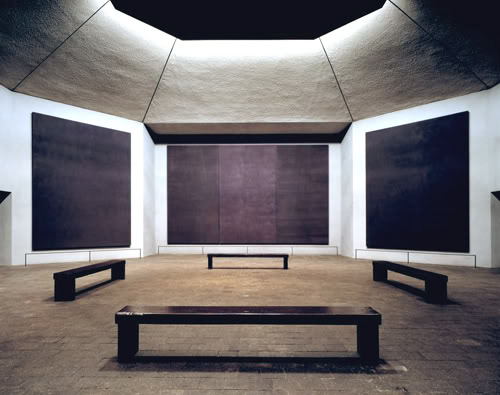
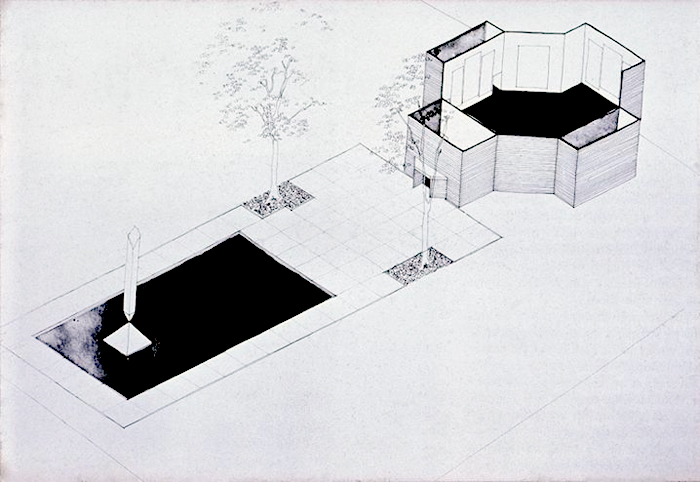
Morton Feldman va escriure una suite per a la capella
Un home contemplant una paret grisa (Black over Grey), després d’haver estat contemplant el món?
Vistes al KHM a Viena el maig de 2019, procedents d’una col·lecció privada. “Working with acrylic paint on canvases primed with white gesso, he separates the picture plane horizontally into two distinct fields with dark above and light below. His brushwork, particularly in the lower grey sections into which he folds ochre and blue, is unusually llose. Where the two fields meet, our minds invariably perceive a horizon line, which in turn encourages a reading of the works as desolate, abandoned landscapes. […] The critic Robert Rosenblum sought to establish a relationship with the work of German Romantic artist Caspar David Friedrich, specifically with the feelings of infinity and mortality evoked in paintings such as The Monk by the sea (1808-10), suggesting that ‘we ourselves are the monk before the sea’.
Els paisatges recorden també les fotografies del mar de Hiroshi Sugimoto. L’efecte del monjo contemplant un paisatge sublim és real. Els visitants quedaven quiets davant les pintures, com meditant.
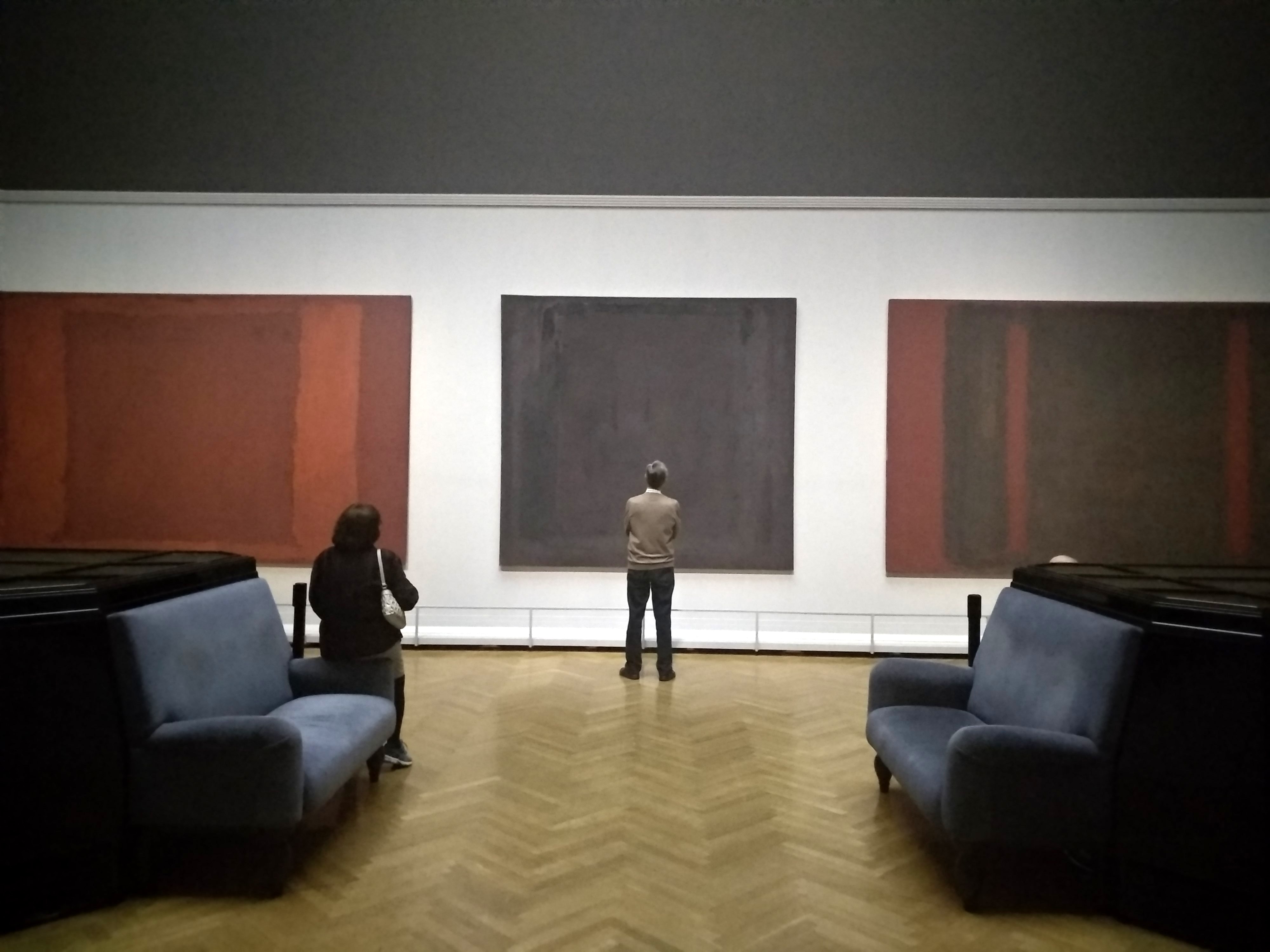
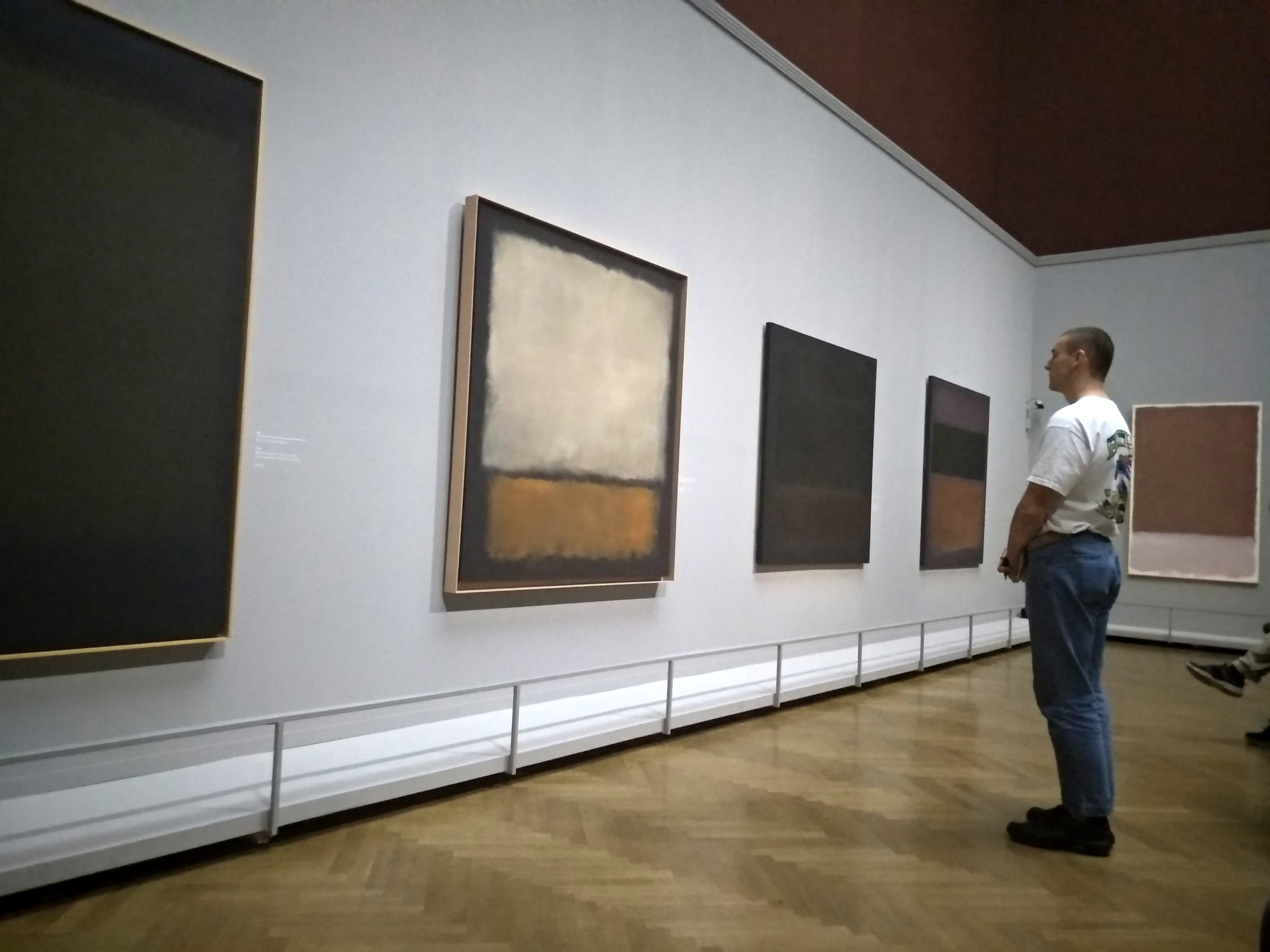
A la llibreria hi tinc una postal amb un figureta en un bloc de formigó, que evoca la contemplació d’un horitzó:
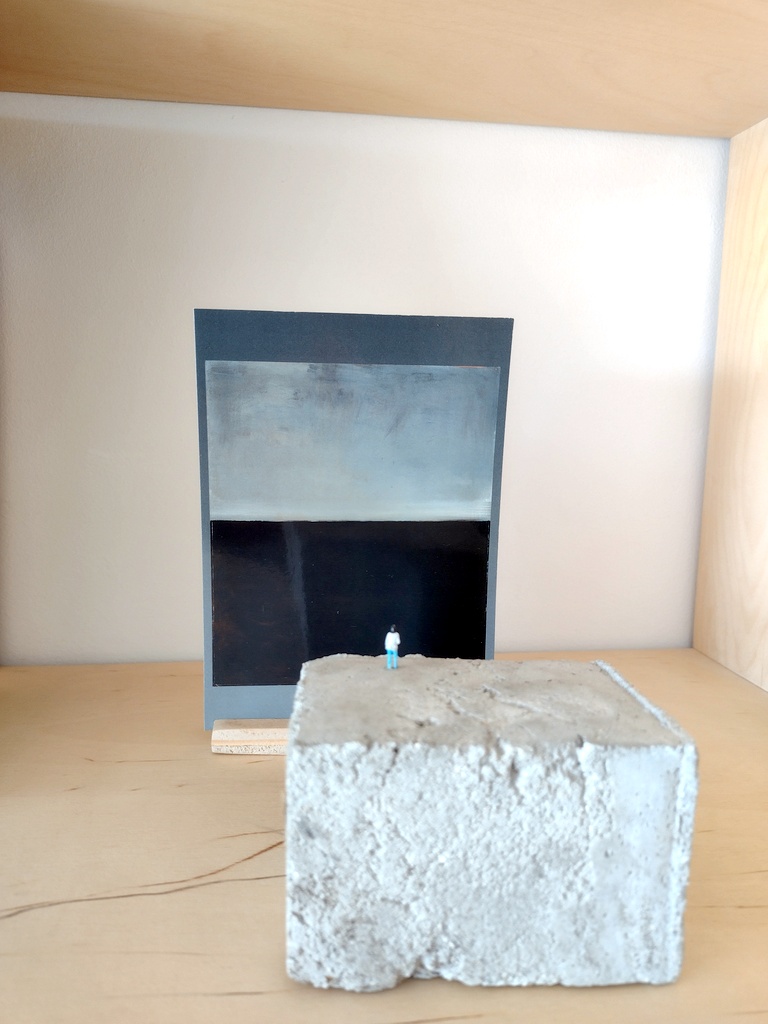
wikipedia, Ancient Jewish history (c. 1500 BCE – 63 BCE) , Roman rule in the land of Israel (63 BCE – 324 CE), Middle Ages 324 1517, 5 Early Modern period, s xix, sxx fins holocaust, l’estat d’israel
1500 BCE Tot i la narració fundacional d’Abram i l’èxode des d’Egipte, no hi ha evidència història que el poble d’Israel hagués hagut de deixar la seva terra. (Veure Judaisme). Sembla que hi havia una confederació de dotze tribus.
1000 BCE
regne d’Israel [al nord, com Galilea?] i Judea
Pregàries
Traditionally, Jews recite prayers three times daily, Shacharit, Mincha, and Ma’ariv with a fourth prayer, Mussaf added on Shabbat and holidays.
Vestimenta
Quipà: yarmulke en Yiddish) is a slightly rounded brimless skullcap worn by many Jews while praying, eating, reciting blessings, or studying Jewish religious texts, and at all times by some Jewish men.
Tsitsit i Tallit: cordons amb nusos que simbolitzen diferents coses al extrems d’un tallit, tela a franges que es porta sobre la camisa. In the Sephardi community, boys wear a tallit from bar mitzvah age. In some Ashkenazi communities, it is customary to wear one only after marriage. A tallit katan (small tallit) is a fringed garment worn under the clothing throughout the day. In some Orthodox circles, the fringes are allowed to hang freely outside the clothing.
Tefillin o filacteris, petites capses de cuir que contenen uns versos de la bíblia i que es lliguen al front. [un concepte bonic que es podria traslladar per dur poesies].
Celebracions
Shabbat, del vespre de divendres al vespre de dissabte, commemorates God’s day of rest after six days of creation. It plays a pivotal role in Jewish practice and is governed by a large corpus of religious law. At sundown on Friday, the woman of the house welcomes the Shabbat by lighting two or more candles and reciting a blessing. The evening meal begins with the Kiddush, a blessing recited aloud over a cup of wine, and the Mohtzi, a blessing recited over the bread. It is customary to have challah, two braided loaves of bread, on the table. During Shabbat, Jews are forbidden to engage in any activity that falls under 39 categories of melakhah, translated literally as “work”.
David Brooks en un article cita el que denomiona filòsof del temps, el Rabbi Abraham Joshua Heschel. In his great book “The Sabbath,” he points out that the first sacred thing in the Bible is not a thing, it is a time period, the seventh day. Judaism, he argues, is primarily a religion of time, not space. “The seventh day,” he writes, “is a palace in time which we build. It is made of soul, of joy and reticence. In its atmosphere, a discipline is a reminder of adjacency to eternity. Indeed, the splendor of the day is expressed in terms of abstentions.” The Sabbath, he continues, is not a rest from the other six days. It is the peak experience the other six days point toward. On this day the Orthodox do less and in slowness can glimpse the seeds of eternity. Sabbath, Heschel concludes, “is endowed with a felicity which enraptures the soul, which glides into our thoughts with a healing sympathy. It is a day on which hours do not oust one another. It is a day that can soothe all sadness away. No one, even the unlearned, crude man, can remain insensitive to its beauty.”
Hi ha tres festes de peregrinatge:
Són dies especials el Rosh Hashanah (cap d’any), el Yom Kippur, celebrat a la tardor, el dia més sagrat pels jueus, en que es prega pel perdó dels pecats, el Purim cap el febrer, que celebra l’allliberament dels perses lelgint el llibre d’Esther, una festa alegre on es comparteix menjar i beguda.
La Hanukkah, el festival de les llums, són 8 dies en que es commemora la victòria dels macabeus sobre Antíoc que al segleII volia hel·lenitzar ISrael. Cada dia s’encén una espelma (suposadament, després que Antíoc arrasés el temple, només quedava oli per mantenir encesa la flama un dia, però en va durar vuit, que és el que es tardava en preparar i consagrar més oli). Hanukkah is not mentioned in the Bible and was never considered a major holiday in Judaism, but it has become much more visible and widely celebrated in modern times, mainly because it falls around the same time as Christmas and has national Jewish overtones that have been emphasized since the establishment of the State of Israel. (8+1 branques).
La sinagoga és un edifici de trobada per pregar i estudiar. HI ha una arca que conté la Torah i un llum d’oli (llum eterna) que fa referència a la Menorah de 7 braços del temple de Jerusalem que desaparegué en ser saquejat pels romans. [La menorah de la Hanukka és per les cases]. Simboliltza la il·luminació universal. [ara no hi ha cap Temple, el tercer es considera però a nivell simbòlic. les famílies, en tenen dues? és pels edificis oficials?]
Kosker
Lleis Kashrut. Many of the laws apply to animal-based foods. For example, in order to be considered kosher, mammals must have split hooves and chew their cud. The pig is arguably the most well-known example of a non-kosher animal. Although it has split hooves, it does not chew its cud. For seafood to be kosher, the animal must have fins and scales. Certain types of seafood, such as shellfish, crustaceans, and eels, are therefore considered non-kosher.Els animals s’han de matar seguint un procediment determinat. Tampoc es pot menjar alhora carn i productes làctics.
El cicle de la vida
General, wikipedia
Judaism (originally from Hebrew יהודה, Yehudah, “Judah“;[1][2] via Latin and Greek) is the ethnic religion of the Jewish people. It is an ancient, monotheistic, Abrahamic religion with the Torah as its foundational text.[3] It encompasses the religion, philosophy, and culture of the Jewish people.[4] Judaism is considered by religious Jews to be the expression of the covenant that God established with the Children of Israel.[5] Judaism encompasses a wide body of texts, practices, theological positions, and forms of organization. The Torah is part of the larger text known as the Tanakh or the Hebrew Bible, and supplemental oral tradition represented by later texts such as the Midrash and the Talmud. With between 14.5 and 17.4 million adherents worldwide,[6] Judaism is the tenth largest religion in the world.
Today, the largest Jewish religious movements are Orthodox Judaism (Haredi Judaism and Modern Orthodox Judaism), Conservative Judaism, and Reform Judaism. Major sources of difference between these groups are their approaches to Jewish law, the authority of the Rabbinic tradition, and the significance of the State of Israel. Orthodox Judaism maintains that the Torah and Jewish law are divine in origin, eternal and unalterable, and that they should be strictly followed. Conservative and Reform Judaism are more liberal, with Conservative Judaism generally promoting a more traditionalist interpretation of Judaism’s requirements than Reform Judaism. A typical Reform position is that Jewish law should be viewed as a set of general guidelines rather than as a set of restrictions and obligations whose observance is required of all Jews
Característiques
Un Déu que intervé en la Història i fa un pacte amb el poble d’Israel, esperant reciprocitat. [com en el cristianisme, sembla una religió no tant de guia per estar millor com el budisme, sinó un contracte a complir. ] Unlike other ancient Near Eastern gods, the Hebrew God is portrayed as unitary and solitary; consequently, the Hebrew God’s principal relationships are not with other gods, but with the world, and more specifically, with the people he created. Judaism thus begins with ethical monotheism: the belief that God is one and is concerned with the actions of mankind.
[A banda del “contracte” amb el poble hi hauria la manera de viure de cada dia] Thus, although there is an esoteric tradition in Judaism (Kabbalah), Rabbinic scholar Max Kadushin has characterized normative Judaism as “normal mysticism”, because it involves everyday personal experiences of God through ways or modes that are common to all Jews. [Sembla més una religió de costums que no de creences teològiues] Whereas Jewish philosophers often debate whether God is immanent or transcendent, and whether people have free will or their lives are determined, Halakha is a system through which any Jew acts to bring God into the world. For some, observance of Jewish law is more important than belief in God per se.
[No hi ha una autoritat central que defineixi quines són les creences bàsiques. Per exemple, no sembla que sigui fonamental la creença en la immortalitat de l’ànima. Per tant sembla més una manera de viure que no una visió tancada sobre l’univers] Els principis de la fe jueva. [Però d’altra banda parteixen d’un text o conjunt de textos als quals tornen repetidament cercant diferents interpretacions], la Torah (Pentateuc) dins de la Tanakh (aprox antic testament) més la “Torah oral” de la Mishna i el Talmud.
Identitat i moviments
“Jueu” ve de Yehuda i de Judà. La identitat és complexa ja que no es correspon exactament ni a la ètnia ni a un conjunt de creences.
According to Rabbinic Judaism, a Jew is anyone who was either born of a Jewish mother or who converted to Judaism in accordance with Jewish Law. All mainstream forms of Judaism today are open to sincere converts, although conversion has traditionally been discouraged since the time of the Talmud. The conversion process is evaluated by an authority, and the convert is examined on his or her sincerity and knowledge. [A diferència dels que volen convertir i sotmetre tothom]. Rabbinical Judaism maintains that a Jew, whether by birth or conversion, is a Jew forever. Thus a Jew who claims to be an atheist or converts to another religion is still considered by traditional Judaism to be Jewish.
Judaisme rabínic
Rabbinic Judaism (or in some Christian traditions, Rabbinism) (Hebrew: “Yahadut Rabanit” – יהדות רבנית) has been the mainstream form of Judaism since the 6th century CE, after the codification of the Talmud. It is characterised by the belief that the Written Torah (Written Law) cannot be correctly interpreted without reference to the Oral Torah and the voluminous literature specifying what behavior is sanctioned by the Law.
Amb la il·lustració, els Ashkenazi (sobretot als països anglòfons) es van dividir en:
Els sefardís
Pregàries, vestimenta, celebracions, kosher, el cicle de la vida
Materials
asd
sdf
SXVIII Hasidic, Haskalah
Hasidic Judaism was founded by Yisroel ben Eliezer (1700–1760), also known as the Ba’al Shem Tov (or Besht). It originated in a time of persecution of the Jewish people when European Jews had turned inward to Talmud study; many felt that most expressions of Jewish life had become too “academic”, and that they no longer had any emphasis on spirituality or joy. Its adherents favored small and informal gatherings called Shtiebel, which, in contrast to a traditional synagogue, could be used both as a place of worship and for celebrations involving dancing, eating, and socializing. [menys teologia més vida de comunitat]
La il·Iustració va suavitzar les lleis que impedien l’accés dels jueus al món secular. A parallel Jewish movement, Haskalah or the “Jewish Enlightenment”, began, especially in Central Europe and Western Europe, in response to both the Enlightenment and these new freedoms. It placed an emphasis on integration with secular society and a pursuit of non-religious knowledge through reason. With the promise of political emancipation, many Jews saw no reason to continue to observe Jewish law and increasing numbers of Jews assimilated into Christian Europe. Modern religious movements of Judaism all formed in reaction to this trend. In Central Europe, followed by Great Britain and the United States, Reform (or Liberal) Judaism developed, relaxing legal obligations (especially those that limited Jewish relations with non-Jews), emulating Protestant decorum in prayer, and emphasizing the ethical values of Judaism’s Prophetic tradition.
Un moviment conservador s’oposà a aquesta tendència.
S XIX El moviment Haredi es va nod
A major historic event was the meltdown after the Universal Israelite Congress of 1868–1869 in Pest. In an attempt to unify all streams of Judaism under one constitution, the Orthodox offered the Shulchan Aruch as the ruling Code of law and observance. This was dismissed by the reformists, leading many Orthodox rabbis to resign from the Congress and form their own social and political groups.
S XX
Després de l’holocaust la major part de les comunitats Hassidiques van desaparèixer. El moviment Haredi es va nodrir sobretot de jeuus procedents de Lituània (1945) i Hongria (1956) i més tard de sefardís (1980)
S XXI
Actualment hi ha les dues tendències.
La població de jueus és a Israel, Estats Units, Canadà, UK, ARgentina i Sudàfrica. N’hi ha uns 14M, uns 6 a Israel, uns 6 als USA i la resta a Europa, Austràlia, Argentina i Sudàfrica.
rty
Origens: 1500 BCE – 586 BCE
[wikipedia, notes Bíblia interconfessional, Karen Armstrong]
La terra de Canaà, que ara correspon a Israel, estava envoltada de civilitzacions potents com Babilònia i Egipte.
La narració de la Torah (pentateuc), al primera part de la Tanakh o antic testament, explica la història d’un poble que s’establí a Canaà i es traslladà a Egipte on fou esclavitzat. Després de 400 anys, el profeta Moisès allilberà el poble i camí de tornada a Canàa rebè els deu manaments al Sinaí (i la Torah). Es van establir dotze tribus. [No hi ha cap evidència històrica que el poble canaaita hagués estat sotmès a Egipte. Serà a segle VIII quan els profetes comencen a elaborar el “relat” d’un Déu que ha fet una aliança amb el poble i es rellegeix en aquests termes els possibles origens d’Israel des de Babilòania (Abram al segle XVIII, i Egipte al XVI. Com diu Karen Armstrong: la idea de l’aliança només té sentit en un context politeista. En general el poble preferia mantenir la seva visió politeista, tenir a Yahveh per les guerres i als altres déus per a la fertilitat. Els profetes els voldran recordar l’existència d’aquest pacte. Elias no va ser generós, quan va guanyar va fer matar tots els sacerdots de Baal. Habitualment els déus coexistien. El Yahvisme va exigir des del començament la repressió i exclusió dels altres déus.
S VIII
733 Exili (diàspora) per invasió d’Assíria
Època dels reis: Saul, David. [Durant aquesta època es comencen a recollir les tradicions orals sobre Noé, Abram i l’Èxode. Els quatre textos es fusionarien a partir de la caiguda del regne del nord el 722. donant lloc al Pentateuc.
Profetes [viii: Amos i Osees al nord, prenen el relleu Isaïes i Miquees al sud i poc abans de la deportació Sofonies, Nahum, Habacuc, Jeremies.]
(KA) Isaïes, segurament un mebre de la classe rectora però va tenir idees populistes i democràtiques i era molt sensible a la situació dels pobres. [el culte recarregat al temple era inadequat davant la situació difícil dels pobres]. Va tenir una visió de Déu com a altre, un mysterium terribile et fascinans, segons Rudolf Otto. A Israel començava a sorgir una experiència molt diferent del que és trobar-se amb la realitat última: és una trobada amb una persona. Tot i l’alteritat terrible, Jahveh es pot dirigir a Isaïes, i aquest pot respondre.
Amós no era un aristòcrata com Isaïes, sinó un pastor que el 752 va anar a Betel a denunciar el culte que s’hi feia. Amós fou el primer profeta que, com Buda, conscient del sofriment humà, va remarcar la importància de la compassió. Dirà que a Jahveh li repugna el greix dels sacrificis, que vol misericòrdia. No només Déu entra en la històriaq, sinó que l’autenticitat de l’experiència religiosa és que estigui integrada eficaçment en la vida diària. Després de rebre la il·luminació caal tornar a la plaça del mercat i practicar la misericòrdia amb els consemblants. Ser el poble escollit no és un privilegi, implica una responsabilitat.
(KA) Els jueus van ser el primer poble de l’antiguetat que va establir un sistema d’asistència social que fou l’admiració dels pobles veïns. Un altre factor, no tan positiu, és la intolerància dels profetes envers els altres cultes. Aquesta hostilitat era quelcom nou. l’hinduisme i el budisme animaven a trascendir als déus. Al mateix temps, Jahveh era un Déu masculí i guerrer, i resultava difícil pels creients, que substituís el culte a la fertilitat que quedava més clar amb divinitats femenines com Awsera, Ishtar o Anat. A mesura que s’imposava la forma de vida urbana, les qualitats masculines de la força física esdevenien més importants i, en la transició al monoteisme, va acabar vencent als altres déus i a les divinitats femenines. Durant força temps els israelites tenien devoció per Asera que veien com a esposa de Jahveh. El rei Manasés va fer erigir una estàtua dedicada a Asera.
SVII El Deutoronomi
(KA) Jilquias sembla haver “descobert” un llibre de la llei, el nucli del deutoronomi, cap al segle VII, que mostra una intransigència nova. El llibre donarà suport a una reforma política i voldrà eliminar el culte cananeu.
Queda lluny la tolerància de Buda cap a altres divinitats que es poden superar. Es vol destruir a l’altre i això ve d’un odi arrelat en una ansietat i un temor ocults. En lloc de fer de Déu un símbol per observar els nostres defectes, el fan servir per confirmar l’odi humà egoista i fer-lo absolut. Dibuixen un Déu que es comporta com nosaltres; no és el Déu d’Amós i Isaïes que ens obliga a l’autocrítica sinó el que ens justifica. Passarà el mateix segles més tard amb les croades. Elabora 613 manaments, la mitzvot.
Salomó: 535 Construcció del primer Temple que contenia l’arca de l’aliança amb les taules de pedra i els deu manaments.
SVI Exili a Babilònia i tornada
586 BCE Destrucció del temple pels babilonis. El 537 tornant del captiveri (diàspora) a Babilònia es construeix de manera modesta. el que serà el segon Temple que al Segle I BCE Herodes refarà.
Jeremies. (KA) Jeremies torna a una visió més iconoclasta i exigent. La interpretació de l’exili a Babilònia és que Déu fa servir Babilònia per castigar Israel. Al rei Joaquim no li va agradar gaire. Era un home pacífic que vivia l’experiència de Déu com un esquinçament. Jeremies 31, 33 La religió no ha de ser un ritu exterior: “posaré la meva llei en el seu inerior i l’escriuré sobre els seus cors”.
Ezequiel (BIC) Ezequiel: Es compilen els llibres que expliquen la història d’Israel, Josué, Jutges, Samuel, Reis. Judà, V-0. S’acaba el Pentateuc. Uns altres autors escriuen la segon i tercera part d’Isaïes (40-55, 56-66), Zacaries. El segle V Esdres i Nehemies reconstrueixen Jerusalem. El segle IV Alexandre el gran inaugura l’hel·lenisme amb un imperi que en morir es desintegra. Judà queda amb els Ptolomeus. Cròniques (i Esdres i Nehemies), presenten els fets de l’època de David del punt de vista de Jerusalem. La visió de la carrossa i els Querubins.
2on Isaïes. En l’exili a Babilònia, Isreal coneix els mites de cosmogonia de Marduk i altres. Aquest 2on Isaïes reescriu la història per afirmar que hi ha un sol Déu a qui atribueix la creació del món i totes les gestes del passat.
P, Tradició sacerdotal, Nombres, Levític
Als fets descrits pel jahvista i el elohista [creació bàsica, èxode, alguns llibres històrics] la tradició sacerdotal hi va afegir la seva interpretació i a més els llibres de nombres i Levític. La tradició sacerdotal va introduir un principi fonamental, que els homes i dones poden arribar a veure només el resplandor de la presència divina, la glòria de Jahveh o kabod, no la seva realitat mateixa. La contribuació més famosa és el primer capítol del gènesi, que s’inspira en l’enuma elish. Déu va separant els elements. La creació de l’home és la culminació del procés i no pas un fet tardà i còmic. La detallada descripció del temple és pel simbolisme oriental que el temple és un cosmos a escala. Bezalel, l’arquitecte del santuari, hauria rebut la inspiració de l’esperit sant.
Job: (KA) Un dels supervivents de l’exili va recuperar una llegenda antiga i, per primera vegada en la història de la religió jueva, es va especular. La resposta tradicional al sofriment és que Déu castigava el poble d’israel per la seva infidelitat, però aquesta resposta ja no li resulta satisfactòria. Job es rebela, Déu li mostra les meravelles de la creació i li fa veure que el problema depassa l’home.
SIV-III Helenisme
(BIC) el judaisme s’estén a l’Egipte dels Ptolomeus. A l’època helenística es compilen també els Salms, Proverbis i altres llibres sapiencials. Tobit.
(KA) El 332 Alexandre Magne va derrotar Darius i els jueus van quedar envoltats de cultura hel·lenística, alguns s’hi van adherir amb entusiasme, al teatre, a la filosofia. Fins i tot van traduir part de les escriptures al grec, el que seria la base per la versió de la Septuaginta. Pels grecs les sinagogues eren quelcom diferent a les altres religions paganes, no hi havia ritus ni sacrificis. i si venia un rabbi famós, l’anaven a escoltar. Però la majoria dels jueus eren reservats i quan Antíoc va intentar introduir el culte a Zeus es van rebelar. Van començar a escriure la pròpia literatura sapiencial: l’autència saviesa seria el temor de Déu.
Aquesta serà una idea fonamental: la raó humana pot arribar a descobrir al Déu grec [serà al d’Aristòtil, no l’Orfeu mític] però al Déu de la Bíblia només se’l pot conèixer per la revelació.
Filó d’Alexandria intentarà una síntesi amb les emanacions mentre que Déu seguiria essent misteriós i impenetrable, sí que podem conèixer les seves emanacions. Déu havia projectat un logos com les formes platòniques.
El segle II Els Macabeus recuperen Jerusalem.
S I
63 BCE Els Romans conquereixen Palestina
Segle I BCEamb construeix el segon temple que serà destruït pels romans el 70 CE per reprimir una revolta.
Al temps de Jesús “Around the 1st century CE, there were several small Jewish sects: the Pharisees, Sadducees, Zealots, Essenes, and Christians. After the destruction of the Second Temple in 70 CE, these sects vanished.[127] Christianity survived, but by breaking with Judaism and becoming a separate religion; the Pharisees survived but in the form of Rabbinic Judaism (today, known simply as “Judaism”). The Sadducees rejected the divine inspiration of the Prophets and the Writings, relying only on the Torah as divinely inspired. Consequently, a number of other core tenets of the Pharisees’ belief system (which became the basis for modern Judaism), were also dismissed by the Sadducees. (The Samaritans practiced a similar religion, which is traditionally considered separate from Judaism.)
S. I
Around the 1st century CE, there were several small Jewish sects: the Pharisees, Sadducees, Zealots, Essenes, and Christians. After the destruction of the Second Temple in 70 CE, these sects vanished.[127] Christianity survived, but by breaking with Judaism and becoming a separate religion; the Pharisees survived but in the form of Rabbinic Judaism (today, known simply as “Judaism”). The Sadducees rejected the divine inspiration of the Prophets and the Writings, relying only on the Torah as divinely inspired. Consequently, a number of other core tenets of the Pharisees’ belief system (which became the basis for modern Judaism), were also dismissed by the Sadducees. (The Samaritans practiced a similar religion, which is traditionally considered separate from Judaism.)
(KA) Per la secta dels esenis de Qumran, l’antic temple era corrupte i calia fer-ne un de nou, espiritual.
Els fariseus. Rabbins. Els fariseus eren una altra secta, la més progresista, que creien que Israel estava destinat a ser una nació santa de sacerdots. La idea que n’hem recollit del nou testament, com a xerraires hipòcrites és una deformació del segle I. Ells volien viure una vida santa en els detalls de la vida diària, la casa, tan pura com el templa, la taula del menjador, com un altar. Els jueus haurien de poder acostar-se a Déu sense la necessitat de la mediació d’un sacerdot. El gran rabbi Hillel resumia la Torah dient: no facis als altres el que no voldries per a tu. Fugint de la destrucció del temple es van fundar diferents comunitats, amb rabbins com Yojanan, Aqiba, Ishmael, que van compilar la Misnà, una posta al dia de la llei mosaica. Una sèrie d’intèrprets es van posar a comentar-la i d’aquí, fins als segles IV i V, en va sortir el Talmud.
Els rabbins van tranformar el Déu que dirigia el món des de lluny i des de dalt en un Déu gairebé tangible i present en la vida quotidiana. Aquesta forma d’spiritualitat s’ha arribat a qualificar de “misticisme normal”. També deien que, al Sinaí, cada jueu havia tingut una experiència diferent de Déu com si aquest, s’adaptés a la capacitat de comprensió de cadascu.
Diàspora
Els jueus estaven ja dispersats a diferents províncies romanes, Assíria, Egipte, Creta. Quan Hadrià els va prohibir l’accés a Jerusalem, l’emigració es va intensificar.
Over a long time, Jews formed distinct ethnic groups in several different geographic areas—amongst others, the Ashkenazi Jews (of central and Eastern Europe), the Sephardi Jews (of Spain, Portugal, and North Africa), the Beta Israel of Ethiopia, and the Yemenite Jews from the southern tip of the Arabian Peninsula. Many of these groups have developed differences in their prayers, traditions and accepted canons; however, these distinctions are mainly the result of their being formed at some cultural distance from normative (rabbinic) Judaism, rather than based on any doctrinal dispute.
Antisemitisme a l’edat mitjana
Les comunitats jueves van ser objecte de persecució en els àrees de domini cristià mentre que van ser tractats amb més tolerància a les àrees islàmiques
uu
Església ortodoxa russa. Després de la revolució va ser combatuda pels bolxevics. Stalin la recuperà per augmentar el patriotisme però Krushev tornà a reprimir-la tancant moltes esglésies.
Molts fidels van emigrar a occident de manera que ara l’església ortodoxa russa
[Altres esglésies orientals]
Església catòlica
Pius XII encara defensava la literalitat del Gènesi.
1962 Concili vaticà II, Joan XXIII (no tant combatre el mal com promoure el bé, aggiornamento).
Església al costat dels pobres, teologia de l’alliberament.
Fonamentalisme. Oposició a l’avortament [que encobreix una repressió del sexe ja que també s’oposen als anticonceptius.] oposició als homosexuals.
[Greu problema d’abusos sexuals. Segueix sense normalitzar el celibat dels sacerdots ni el paper de la dona.
Després de segles i dècades de “monopoli” espiritual, ara una església bastant devaluada ha de competir amb l’atractiu del budisme que proposa eines per sentir-se bé sense haver d’assumir unes creences en un llibre o en el més enllà]
Protestants
El 1904 apareix en Pentacostalisme a USA.
Els predicadors evangèlics fonamentalistes
[Els prdicadors afroamericans, abyssinian Baptist church]
Situació de les diferents denominacions
[esborrany]
3EEC1 Catalunya, la corona d’Aragó, t1: 711 t2: 1479.
inicis, derivació del llatí
Com s’ha vist, entre els segles xi i xii comencen a aparèixer els primers textos en català, sobretot jurídics i religiosos. No serà fins a partir del segle xiii que alguns autors decidiran emprar el català per escriure literatura. Així doncs, de mica en mica, els autors faran servir les llengües vulgars per alguns usos que fins ara estaven reservats al llatí. La primera forma de literatura en llengua vulgar serà la poesia trobadoresca, aquesta serà recitada en occità i alguns dels autors catalans més rellevants són Guillem de Berguedà, Cerverí de Girona o Guillem de Cabestany. Als segles xiii i xiv hi trobem Ramon Llull amb una obra religiosa, filosòfica i moralitzant en llengua catalana; hom el considera el creador del català literari per excel·lència i és el primer autor d’escriure obres científiques en una llengua vulgar.[14] En aquesta època també hi trobarem les Cròniques de Jaume I, Bernat Desclot, Ramon Muntaner i Pere III, uns textos que tot i que en el moment que es van produir tenien com a objectiu narrar uns fets, actualment, hom considera que contenen elements propis de la literatura. Entre els segles xiv i xv, podem destacar-hi la prosa humanista de Bernat Metge amb l’obra Lo somni. Finalment, al segle xv, per diversos motius polítics i econòmics València es convertí en el centre cultural i el nucli de producció literària en la nostra llengua en el que es coneix com a segle d’or valencià, un segle d’esplendor literària en què es produïren novel·les cavalleresques com Tirant lo Blanc i Curial e Güelfa o la poesia d’Ausiàs March.
Decadència i Renaixença
4EEC1 Catalunya moderna t1: 1479 t2: 1798
decadència
La literatura moderna es divideix en tres etapes d’un segle cadascuna coincidint amb el Renaixement, barroc i l’Il·luminisme. Tot i la «decadència» existeixen contribucions importants d’escriptors com Cristòfor Despuig, Joan Timoneda i Pere Serafí al Renaixement; Francesc Fontanella, Vicenç Garcia i Josep Romaguera, durant el barroc; i Joan Ramis, Francesc Mulet i Antoni Puig i Blanch durant la Il·lustració. Al mateix temps, també hi ha una producció important de diverses formes de literatura popular en llengua catalana.
5EE01 Napoleó, restauració 1798-1873.
1833 Renaixença
5EE02 1a República, restauració, dictadura, 2a república 1873-1936.
1893 Modernisme i Noucentisme
1920 Avantguarda
5EE03 Guerra Civil i Franquisme 1936-1975.
franquisme
5EE04 Democràcia simulada 1975-2020
normalització?
[A Rússia seguirà l’església ortodoxa fins a la revolució i a Orient el domini otomà. L’església catòlica reaccionarà davant l’amenaça de la ciència que qüestiona el seu relat. S’enviaran missioners a Amèrica llatina, Àsia i Àfrica, en paral·lel amb el collonislisme. A Amèrica els emigrants desenvoluapran les seves versions de la reforma a partir del puritanisme].
Església i il·lustració
1633 Galileu és condemnat per qüestionar el geocentrisme.
Pietisme
Dins del protestantisme apareix com un corrent que, més enllà d’entendre i adherir-se a una doctrina, vol viure una experiència de fe, una conversió personal com un tornar a néixer amb una relació amb Crist. Cal arribar a viure una vida santa a partir de la lectura personal de la Bíblia i l’oració regular. Comença amb Philipp Jakob Spener i la seva obra “Pia Desideria” (1675).
D’una banda s’inclinen per l’ordre i la frugalitat. De l’altra, [s’allunyen dels sagraments, rituals màgics] i tendeixen a una fe privada que pot dur a un misticisme panteista. Els no creients no els veuen com enemics sinó com algú a qui ajudar, i en això influiran les missions.
L’4església oficial no els veurà amb bons ulls, tant si es tracta d’un fervor evangèlic exagerat, com d’un misticisme nebulós.
[El geòleg Lyell i WIlliam Thomson faran una estimació de l’edat de la terra en termes de milions d’anys, en comptes dels càlculs d’uns 4000 anys comptats a partir del gènesi. Avui als USA encara hi ha qui defensa el dret a ensenyar el creacionisme en comptes de l’evolució]
[A Europa seguirà una església a la defensiva i repressiva. A molts països hi ha un procés de laicització que incauta béns de l’església. A España la desamortización de Mendizábal]
Estats Units
Els purtitans (pilgrims) van colonitzar nova Anglaterra i volien fundar una societat pura. No pretenien convertir els nadius.
Great awakenings
1738 Evangelics. D’origen metodista i pietista, van tenir un gran creixement a Anglaterra (Metodistes) i Estats Units (Fonamentalistes, Pentecostals)amb el Great Awakening. Són uns 285M. Conversionism, or belief in the necessity of being “born again“, has been a constant theme of evangelicalism since its beginnings. To evangelicals, the central message of the gospel is justification by faith in Christ and repentance, or turning away, from sin. Conversion differentiates the Christian from the non-Christian, and the change in life it leads to is marked by both a rejection of sin and a corresponding personal holiness of life. A conversion experience can be emotional, including grief and sorrow for sin followed by great relief at receiving forgiveness. The stress on conversion differentiates evangelicalism from other forms of Protestantism by the associated belief that an assurance of salvation will accompany conversion.
1870 Testimonis de Jehova
El comte Giacomo Leopardi, nascut Giacomo Taldegardo Francesco di Sales Saverio Pietro Leopardi[1] (Recanati, 29 de juny del 1798[2]–Nàpols, 14 de juny del 1837)[3] va ser un poeta, filòsof,[4] escriptor i filòleg italià. És considerat el principal poeta del romanticisme italià i una de les figures més importants de la literatura mundial. L’extraordinària qualitat lírica de la seva poesia i la profunda reflexió sobre la condició humana en fan un personatge central del panorama literari cultural europeu i internacional del moment.[1] Entre les seves obres, hi trobem un diari en el qual sistematitzà el seu pensament i les idees rere la seva poètica: l’anomenat Zibaldone. El seu pensament filosòfic és conegut i autodenominat com a ultrafilosofia.[5]
Fou molt estimat pel filòsof molt més posterior Arthur Schopenhauer. L’impacte de Leopardi en l’educació italiana contemporània és tal que l’obra Zibaldone és coneguda pels italians.
Sempre caro mi fu quest’ermo colle,
E questa siepe, che da tanta parte
Dell’ultimo orizzonte il guardo esclude.
Ma sedendo e mirando, interminati
Spazi di là da quella, e sovrumani
Silenzi, e profondissima quiete
Io nel pensier mi fingo; ove per poco
Il cor non si spaura. E come il vento
Odo stormir tra queste piante, io quello
Infinito silenzio a questa voce
Vo comparando: e mi sovvien l’eterno,
E le morte stagioni, e la presente
E viva, e il suon di lei. Così tra questa
Immensità s’annega il pensier mio:
E il naufragar m’è dolce in questo mare.
Giacomo Leopardi, un dels grans poetes europeus, entre la primavera i la tardor del 1819, va escriure el seu poema més famós, ‘L’infinito’, poema que tots els italians ben educats saben de memòria. O sigui que fa dos-cents anys de la redacció d’aquest poema de només quinze versos. Prop de la casa paterna del poeta, allà on havia nascut i on vivia, hi ha un turó solitari on el poeta anava a meditar. Llavors era un lloc sense gaire vegetació i per això el poeta parla de turó erm, en el sentit d’incultivat. Ara, des fa uns cent anys, el lloc ha estat batejat com a Colle dell’Infinito, i està enjardinat i plantat d’arbres.
El poema és breu però ha generat una gran quantitat d’estudis i comentaris. Leopardi, assegut al turó, davant d’una bardissa que li tapa el primer terme, deixa perdre la vista horitzó enllà i s’imagina uns espais immensos i un silenci i una quietud fondíssims. I sent com els temps passats i els actuals (els de la seva època) li venen al pensament: “i l’etern em revé, i les èpoques mortes”. I en aquesta immensitat se li nega el pensament i li és dolç, diu, naufragar en aquest mar. I res més. Ja he dit que era un poema brevíssim.
D’on li ve tanta fama? Doncs de la sensació d’infinit que provoca en el lector i de la perfecció de la redacció del text. Quinze versos d’onze síl·labes, separats en dues meitats de set versos cadascuna per un vers on ens diu que davant de tanta immensitat, davant d’aquella imatge de l’infinit, el cor per poc no se li esglaia. Aquí hi ha, per a mi, la clau del poema. A l’original, “ove per poco il cor non si spaura…” Aquesta ‘u’ de ‘spaura’ és realment un pou de por, per dir-ho com Ferrater. Una ‘u’ del tot intraduïble, evidentment. Tot el poema és un joc descriptiu real i imaginari ple de riquesa fònica que s’endú el lector fins al fons d’aquest mar on negar-s’hi és d’una dolcesa extraordinària.
D’on ve la idea del poema? Els savis s’han trencat el cap per trobar fonts d’inspiració temàtica del poema, a més, esclar, de la situació real del lloc d’inspiració. Hi ha un pensament de Pascal que diu: “Le silence éternel de ces espaces infinis m’effraie” [El silenci etern d’aquests espais infinits m’esglaia]. El parentiu de Pascal amb ‘L’infinito’ no es pot negar, però Leopardi no podia conèixer aquest pensament perquè l’edició completa dels ‘Pensaments’ de Pascal és del 1844 i Leopardi va morir el 1837. En canvi sí que va llegir, segur, en una antologia de textos que es troba a la biblioteca del seu pare, i que va ser un llibre de capçalera del poeta, un fragment de Rousseau que diu: “[…] l’esprit perdu dans cette immensité, je ne pensois pas, je ne raisonnois pas, je ne philosofois pas: je me sentois avec une sorte de volupté accablé du poids de cet univers; je me livrois avec attendrissement à la confusion des grandes idées; j’amois à me perdre en imagination dans l’espace; mon coeur resserré même dans les bornes des êtres s’y trouvait trop à l’étroit, j’étouffois dans l’univers. J’aurais voulu m’élancer dans l’infini […]” [amb l’esperit perdut en aquesta immensitat, no pensava, no raonava, no filosofava: em sentia ple d’una mena de voluptat, esclafat pel pes d’aquest Univers; em lliurava amb tendresa a la confusió de les grans idees; m’agradava perdre’m amb la imaginació dins l’espai; el meu cor, tancat entre els límits dels éssers, s’hi sentia massa constret, m’ofegava dins de l’Univers. Hauria volgut llançar-me dins de l’infinit]. Jo crec que aquest text sí que va influir en el contingut del poema leopardià. Però Leopardi era un poeta i li va donar una forma incomparable. Va convertir en una obra d’art unes idees o unes sensacions que, a part de Rousseau, ves a saber d’on li venien.
Hi ha un poema de Verdaguer, ‘Vora la mar’, escrit el 1883, que comença amb una situació paral·lela a la del Leopardi de ‘L’infinito’: “Al cim d’un promontori que domina / les ones de la mar, / quan l’astre rei cap a ponent declina / me’n pujo a meditar. // Amb la claror d’aqueixa llàntia encesa / contemplo mon no-res; / contemplo el mar i el cel, i llur grandesa / m’aixafa com un pes”. Suposo que Verdaguer havia llegit ‘L’infinito’, perquè Leopardi era un poeta que no havia de ser estrany a un poeta català cultivat. La sensació d’aquest no-res verdaguerià que l’aixafa, que el nega, provocada per aquesta contemplació de la naturalesa en la seva infinitud, sempre m’ha semblat molt leopardiana.
Celebrem, doncs, els dos-cents anys del poema de Leopardi i la seva presència en les nostres lletres.
[A Orient arriba el domini islàmic. A Occident l’església creix en poder terrenal, floreixen les arts però també la corrupció que donarà lloc a la reforma]
Església ortodoxa a Orient
1453 Constantinopla és conquerida i tota l’església del pròxim orient quedarà sota domini turc fins el 1919?, tolerada però sense poder.
L’església ortodoxa russa queda fora del seu control cap el 1200. [i el 1917 amb la revolució bolxevic també caurà).
Aïllada d’occident, no prendrà part en el debat reforma – contrareforma.
Església llatina
1378 – 1416 Papes a Avinyó sota control francès, cisma d’occident, disputa política.
Esplendor cultural i corrupció al renaixement italià 1375 – 1520: The Renaissance was a period of great cultural change and achievement, marked in Italy by a classical orientation and an increase of wealth through mercantile trade. The City of Rome, the Papacy, and the Papal States were all affected by the Renaissance. On the one hand, it was a time of great artistic patronage and architectural magnificence, where the Church patroned such artists as Michelangelo, Brunelleschi, Bramante, Raphael, Fra Angelico, Donatello, and da Vinci. On the other hand, wealthy Italian families often secured episcopal offices, including the papacy, for their own members, some of whom were known for immorality, such as Alexander VI and Sixtus IV.
Reforma
Precedents de John Wycliff (1330–1384) i Jan Hus (1369?–1415) contra la corrupció, defensant la relació entre l’home i Déu amb la Bíblia sense sacerdots i bisbes. Perseguits.
1517 Luter (1483 – 1546) publica les Ninety-five Theses i el 1521 es prohibeixen a 7, there was no schism until the 1521 Edict of Worms. The edicts of the Diet condemned Luther and officially banned citizens of the Holy Roman Empire from defending or propagating his ideas.
Huldrych Zwingli (1484 1531) Reforma a Zurich.
John Calvin (1509 1564) Església reformada a Ginebra
Contrareforma
1534 Ignacio de Loyola funda la Compañía de Jesús. Retir i exercicis espirituals, organització mig militar, universitats [ els franciscans predicaran la pobrsa, els dominicans la repressió i els Jesuïtes serà el petit reducte de saber amb censura quan arribi la il·lustració].
1545 – 1563 Concili de Trento
The Council of Trent (1545–1563), initiated by Pope Paul III (1534–1549) addressed issues of certain ecclesiastical corruptions such as simony, absenteeism, nepotism, the holding of multiple church offices by one person, and other abuses, as well as the reassertion of traditional practices and the dogmatic articulation of the traditional doctrines of the Church, such as the episcopal structure, clerical celibacy, the seven Sacraments, transubstantiation (the belief that during mass the consecrated bread and wine truly become the body and blood of Christ), the veneration of relics, icons, and saints (especially the Blessed Virgin Mary), the necessity of both faith and good works for salvation, the existence of purgatory and the issuance (but not the sale) of indulgences, etc. In other words, all Protestant doctrinal objections and changes were uncompromisingly rejected.
In terms of politics, the Counter-Reformation included heresy trials, the exiling of Protestant populations from Catholic lands, the seizure of children from their Protestant parents for institutionalized Catholic upbringing, a series of wars, the Index Librorum Prohibitorum (the list of prohibited books), and the Spanish Inquisition.
Introducció Geografia | Història | Filosofia i religió | Literatura | Art | Altres Música Cuina. | El llegat | La meva experiència
Muntanyes
Al nordest les muntanyes de Tian Shan i el desert de Taklamakan . Al nord el desert de Gobi limitant amb Mongòlia. Al sudoest la meseta del Tibet que limita amb les muntanyes del Karakoram i Pamir a l’oest amb Pakistan, i l’Himalaia al sud amb la Índia. Al centre hi ha les grans planes travessades pels grans rius.
Rius
Al nord limitant amb Rússia, el riu Amur (Heilong Jiang).
El Yellow River (Huang He) neix al Tibet i desemboca al nord, al mar groc.
Separats per les muntanyes Qin, més al sud el més llarg, el Yangtze del Tibet a prop de Shanghai. (Clima de boscos caducifolis temperats). Al sud clima subtropical, amb el Zhujiang (Pearl River), amb les contribucions del Xi (Oest), Dong (Est), and Bei (Nord), acabant amb un gran delta a Hong Kong [paisatge de turons verticals].
El riu Mekong comença a Xina al nord de l’himalaia i creuarà tot el sudest asiàtic. El Brahmaputra neix al Tibet i serà un tributari del Ganges.
Regions
23 províncies (省 shěng) (incloent Taiwan),5 regions autònomes (自治区 zìzhìqū) amb minories ètniques i 4 grans municipis, Beijing (capital política), Shanghai (centre financer), Tianjin (port industrial), Chongqing (gran metròpoli interior). Shenzhen, Zhuhai, Xiamen i Hainan són regions especials per afavorir la inversió.
Regions avançades
Indústria
Centres de poder. Vall del Groc (nord): Chang’an, Luoyang i Kaifeng van dominar en èpoques antigues. Desplaçament cap al sud: Hangzhou i Nanjing van guanyar importància quan el nord era envaït (p. ex., per jurchens o mongols). Beijing va consolidar-se com a capital “definitiva” des dels Yuan (estratègia contra nòmades del nord).
2PAX0 Paleolític Xina i Japó -50000 -8000
2NAX1 Neolític Xina Grans rius -8000 -1700
2HAX0 Xina Shang, Chou -1700 -221.
Època imperial
2HAX1 Xina Qin Han -221 220. 2HAX2 Xina Tres Regnes i Sui 220 618.
3AX01 Xina Tang 618 960.
3AX02 Xina Song 960 1280.
3AX03 Xina Yuan 1280 1368. 3AX04 Xina Ming 1368 1644. 4AX01 Xina Qing 1644 1912
Xina i Taiwan
5AX01 Revolució Xinesa 1912-1945. 5AX02La Xina de Mao 1945-1976. 5AX03 Den Xiao Ping i Revolució econòmica 1976-2020
Introducció. Dinasties Zhou, Han Tang Song Yuan Ming Qin i moderna
> peripecis mico // Liu ci xin ciència ficció
Pintura, escultura, cal·ligrafia, ceràmica
l’art oriental que es fa ràpid i s’ha de fer bé a la primera, que é smés com la música, assajr moltes vegades [en canvi avui la música és sobretot una tasca de producció]
https://en.wikipedia.org/wiki/Chinese_architecture#Architectural_types
https://en.wikipedia.org/wiki/Chinese_garden
Música
Tan Dun Concert d’aigua
Cuina
també? l’art oriental que es fa ràpid i s’ha de fer bé a la primera, que é smés com la música, assajr moltes vegades [en canvi avui la música és sobretot una tasca de producció]
>> a cuina + receptes + canvi dinars, te verd i arròs cada dia
Del llibre de LUYU, maneres de prendre el te.
Dinastia TANG: te en pols, bullir l’aigua fins que les bombolles siguin com ulls de peix i el so com el vent en els pins. Afegir sal. Reservar aigua. Remenar. Afegir te en pols. Aturar el bull i servir.
Dinastia SONG: Te remenat. escalfr un bol. Afegir te en pols. Dissaoldre’l amb aigua calenta. Remenar amb una brotxa de bambú. afegir més aigua i remenar.[com el japonès].
Dinastia MING. Escalfar la tetera i descartar l’aigua. Afegir fulles. Rentar les fulles amb aigua bullent i descartar l’aigua. afegir aigua i tapar la tetera. Com que van veure que amb les teteres molt grans amb molt de te canviava el sabor, van anar fent teteres més petites fins arrigar al GUNFU, propi de Fujian. Escalfar la tetera i buidar l’aigua sobre tapa de manera que caigui aks 3 bols. Posar fulles de te i aigua. Tirar aigua bullent a sobre per mantenir-la calenta, 1 minut. Vessar el te fent cercles sobre els tres bols per que quedi igual [a proporció, més te i menys temps d’infusió]
cinema:
subgenere arts marcials Wu Xia
wong kar mai
A Solius hi havia un disc amb música xinesa que sonava estranya a les meves oïdes. A l’adolescència vaig “descobrir” la poesia en les cançons de Mahler del Cant a la terra.
com més cutre el lloc, més bo el menjar. + refinament hongkong
Els pandas, fòssils vivents del pleistocè>>enllaç a museu vida
imaginació viure a pekin o chengdu
em va canviar la manera de menjar, arròs els migdies
novles policiaques jutge dee
asd
>> imaginari: veure imatges generades per cgpt + llocs on hauria viscut a imaginari i preparar una galeria virtual de pintura, ceràmica, cerimònia de te, jardí, taoisme, erstaurant
Gandhi assassinat
Lluites sagnants entre hindus i musulmans
Ressorgiment intolerant hindu, continuen les castes
Terrorisme a Pakistan
Primer, influència de la East India Company, i al final, colònia de dret a partir de 1858 després d’una revolta ferotgement reprimida.
1885 Congrés nacional
1906 Lliga musulmana
1915 Ghandi torna a la Índia
1947 Partició amb musualmans a Pakistan i Bangladesh
1526 – 1805
Imperi mogol [mughal, no confondre amb el mongol]
Aquest imperi fou el resultat de l’expansió dels mongols al segle XVI sota la impulsió de Bàber (1483-1530), turcomongol islamitzat de cultura persa. Amb la dominació de la seva dinastia, s’instaurà una fórmula de govern basada en la tolerància religiosa i en una certa igualtat davant l’impost, així com un període de gran floriment cultural i artístic. Al seu apogeu, l’imperi mogol va representar un exemple destacable d’Estat centralitzat i tolerant; la seva extensió, el respecte que inspirava als seus veïns, la riquesa exhibida a la cort i en les construccions van fascinar bon nombre de visitants estrangers, que l’anomenaren l'”imperi del Gran Mogol”. Si aquesta esplendor i aquesta tolerància cultural no sobrevisqueren plenament al seu principal promotor, l’emperador Àkbar, facilitaren nogensmenys l’obertura de l’Índia a la resta del món i en particular a les empreses colonials dels europeus.
Bàber, turc nusulmà, en no poder-se expandir cap a l’oest, derrotà el sultà de Delhi i estableix la capital a Agra.
1542 – 1605 Akbar, que impulsà les arts.
1632: TAJ MAHAL l’emperador mogol Xa Jahan en honor a la seva difunta esposa, l’emperadriu Arjumand Banu Begum, més coneguda com a Mumtaz Mahal (l’escollida del palau), la qual va morir en donar a llum el seu catorzè fill.
A partir de 1707 perden influència.
600 – 1206
Diferents regnes al nord, al sud (Deccan)
Consolidació de l’hinduisme
1206 – 1526 Sultanat de Delhi
Nòmades d’Àsia agafen el control. Respecten els costums de la població no musulmana i contenen els atacs mongols.
6500 BCE: evidència d’agricultura i ramaderia a Mehrgarh i el que ara és Balochistan.
2500 – 1900 BCE: Civilització de vall de l’Indus [riu que va de L’Himalaia a Karachi, Pakistan], Monhenjo-daro i Harappa.
[la resta ?]
2000 – 500 BCE Cultura Veda al Punjab i plana del Ganges.. Composició dels Vedas associats amb l’hinduisme, així com el sistema de castes.
Buda (480 BCE – 400 BCE)
Jainisme
300 BCE – 187 BCE Imperi Maurya, ab Asoka controlant gairebé tot el continent llevat del sud
187 BCE – 200 CE
Indo escites
Imperi Kushan
altres
200 CE – 563 CE Imperi Gupta
The Gupta Empire was an ancient Indian empire existing from the mid-to-late 3rd century CE to 543 CE[3]. At its zenith, from approximately 319 to 543 CE, it covered much of the Indian subcontinent.[4] This period is called the Golden Age of India by some historians.[5][note 1] The ruling dynasty of the empire was founded by the king Sri Gupta; the most notable rulers of the dynasty were Chandragupta I, Samudragupta, and Chandragupta II alias Vikramaditya.[note 2] The 5th-century CE Sanskrit poet Kalidasa credits the Guptas with having conquered about twenty-one kingdoms, both in and outside India, including the kingdoms of Parasikas, the Hunas, the Kambojas, tribes located in the west and east Oxus valleys, the Kinnaras, Kiratas, and others.[8][non-primary source needed]
The high points of this period are the great cultural developments which took place primarily during the reigns of Samudragupta I, Chandragupta II and Kumaragupta I[9]. Many of the literary sources, such as Mahabharata and Ramayana, were canonised during this period.[10] The Gupta period produced scholars such as Kalidasa,[11] Aryabhata, Varahamihira, and Vatsyayana who made great advancements in many academic fields [12][13][14]. Science and political administration reached new heights during the Gupta era [15]. The period gave rise to achievements in architecture, sculpture, and painting that “set standards of form and taste [that] determined the whole subsequent course of art, not only in India but far beyond her borders”.[16] Strong trade ties also made the region an important cultural centre and established the region as a base that would influence nearby kingdoms and regions in Burma, Sri Lanka, and Southeast Asia.[17][unreliable source?] The Puranas, earlier long poems on a variety of subjects, are also thought to have been committed to written texts around this period.[18]
Christianity is an Abrahamic religion based on the life and teachings of Jesus of Nazareth, as described in the New Testament. Its adherents, known as Christians, believe that Jesus Christ is the Son of God and savior of all people, whose coming as the Messiah was prophesied in the Old Testament.[2]
Depending on the specific denomination of Christianity, practices may include baptism, Eucharist (Holy Communion or the Lord’s Supper), prayer (including the Lord’s Prayer), confession, confirmation, burial rites, marriage rites and the religious education of children. Most denominations have ordained clergy and hold regular group worship services.
Christianity developed during the 1st century CE as a Jewish Christian sect of Second Temple Judaism. It soon also attracted Gentile God-fearers, which lead to a departure from Jewish customs, and the establishment of Christianity as an independent religion. During the first centuries of its existence Christianity spread throughout the Roman Empire, and also to Ethiopia, Transcaucasia, and some parts of Asia.
Constantine the Great converted to Christianity and decriminalized it via the Edict of Milan (313). The First Council of Nicaea (325) established a uniform set of beliefs across the Roman Empire. By 380, the Roman Empire designated Christianity as the state religion.[3][4][5][6] The period of the first seven ecumenical councils is sometimes referred to as the Great Church, the united full communion of the Roman Catholic Church, Eastern Orthodox Church, and Oriental Orthodoxy, before their schisms.
Oriental Orthodoxy split after the Council of Chalcedon (451) over differences in Christology. The Eastern Orthodox Church and the Catholic Church separated in the East–West Schism (1054), especially over the authority of the Pope. Similarly, in 1521, Protestants split from the Catholic Church in the Protestant Reformation over Papal primacy, the nature of salvation, and other ecclesiological and theological disputes.[7]
Following the Age of Discovery (15th–17th century), Christianity was spread into the Americas, Oceania, sub-Saharan Africa, and the rest of the world via missionary work and colonization.[8][9][10]
There are 2.3 billion Christians in the world, or 31.4% of the global population.[11][12] Today, the four largest branches of Christianity are the Catholic Church (1.3 billion), Protestantism (920 million), the Eastern Orthodox Church (260 million)[13] and Oriental Orthodoxy (86 million).
Christianity and Christian ethics have played a prominent role in the development of Western civilization,[14][15][16][17][18] particularly around Europe during late antiquity and the Middle Ages. Despite a declining trend in membership in the West,[19] Christianity remains the dominant religion in the region, with more than 70% of the population identifying as Christian.[20]
451 Concili de Calcedònia, separació de l’ortodòxia oriental per discrepàncies Cristològiques, ( l’armenia, copta (i etíop) i siríaca ), amb uns 80M A Egipte i Etiopia, Síria i Armènia.
1054 Gran Cisma, separació de l’ortodòxia de l’est. Actualment 200-260M de membres a Rússia i Georgia. (Grècia i Antioquia quedaran sota domni Otomà del 1453 a 1915).
La resta, és l’església Catòlica (o llatina), va retrocedir a Occident amb la Reforma però es va extendre a Amèrica llatina. Actualment són uns 1300M.
1521 Reforma de Luter, Calvi, Anglicanisme, 920M de Protestants, que no accepten l’autoritat de Roma i discrepen pel que fa a certs sacraments.
dsf
476 – 799
L’emperador Romà tenia la seu a Constantinopla. A Orient es van mantenir les estructures de diòcesis i els canvis van ser més lents. A Occident el papa havia de mantenir l’equilibri amb l’emperador romà i els nous governants als territoris ocupats pels bàrbars.
Sant Benet (480 – 547). Vida monàstica primer a Subiaco i després a Montecassino, fundant més monestirs cadascun amb un abat i 12 monjos. La seva regla se seguirà a tots els monestirs d’occident. ( text ): “La vida del religiós o religiosa és dividida en períodes regulars de son, de pregària, de lectura de la Santa Escriptura, de descans i de treball físic. | El dia comença a mitjanit, amb el servei de les matines, seguit de l’ofici de prima, seguit a l’aurora pel cant de les laudes. Abans de l’arribada de les espelmes de cera al segle XIV, era fet en la foscor o amb un mínim d’enllumenat. Aquests oficis podien ser molt llargs, de vegades fins a trenc d’alba però consistien generalment a cantar tres salms, tres respons, una lliçó (lectura de la Bíblia), i un himne, afegint cada dia la celebració d’un sant local. | Els monjos es retiraven llavors per a dormir i es despertaven a les 6 hores, es rentaven i escoltaven missa. Llavors es reunien per tal de rebre les consignes i ordres per a la jornada i discutir els assumptes propis. També hi havia temps per les activitats personals com la lectura o el treball fins a les 9 del matí. Es feia «l’ofici de tercera» per continuar després amb altres treballs. Al migdia deien l’ofici de sexta i després menjaven. Després d’un breu període per a la migdiada, el monjo es podia retirar fins a l’ofici de nona, cap a les 3 de la tarda. Després venien els treballs al jardí i d’altres serveis fins a dues hores abans del crepuscle. Cap a les 6, les vespres, després les completes cap a les 7 i en acabar-se anaven a dormir per aixecar-se aviat per a les matines.
Occident 476 – 799
Els monestirs irlandesos, expansió de les illes al món germànic
Sant Patrick, Columba, Agustí
Va començar una expansió del cristianisme, a partir de Prominent Saints Patrick, Columba and Columbanus. Columba ] ( 521 – 597) was an Irish abbot and missionary evangelist credited with spreading Christianity in what is today Scotland at the start of the Hiberno-Scottish mission. He founded the important abbey on Iona, which became a dominant religious and political institution in the region for centuries. [que vaig veure a la illa de Iona, a Escòcia]. Un monestir antic és del de Glendalough que vaig visitar amb la Maria]
The Anglo-Saxon tribes that invaded southern Britain some time after the Roman abandonment, were initially pagan, but converted to Christianity by Augustine of Canterbury on the mission of Pope Gregory the Great.
Segons la tradició, Gaul, un company de Comlombanus va fundar el que acabaria sent l’abadia de St.Gallen el 612.
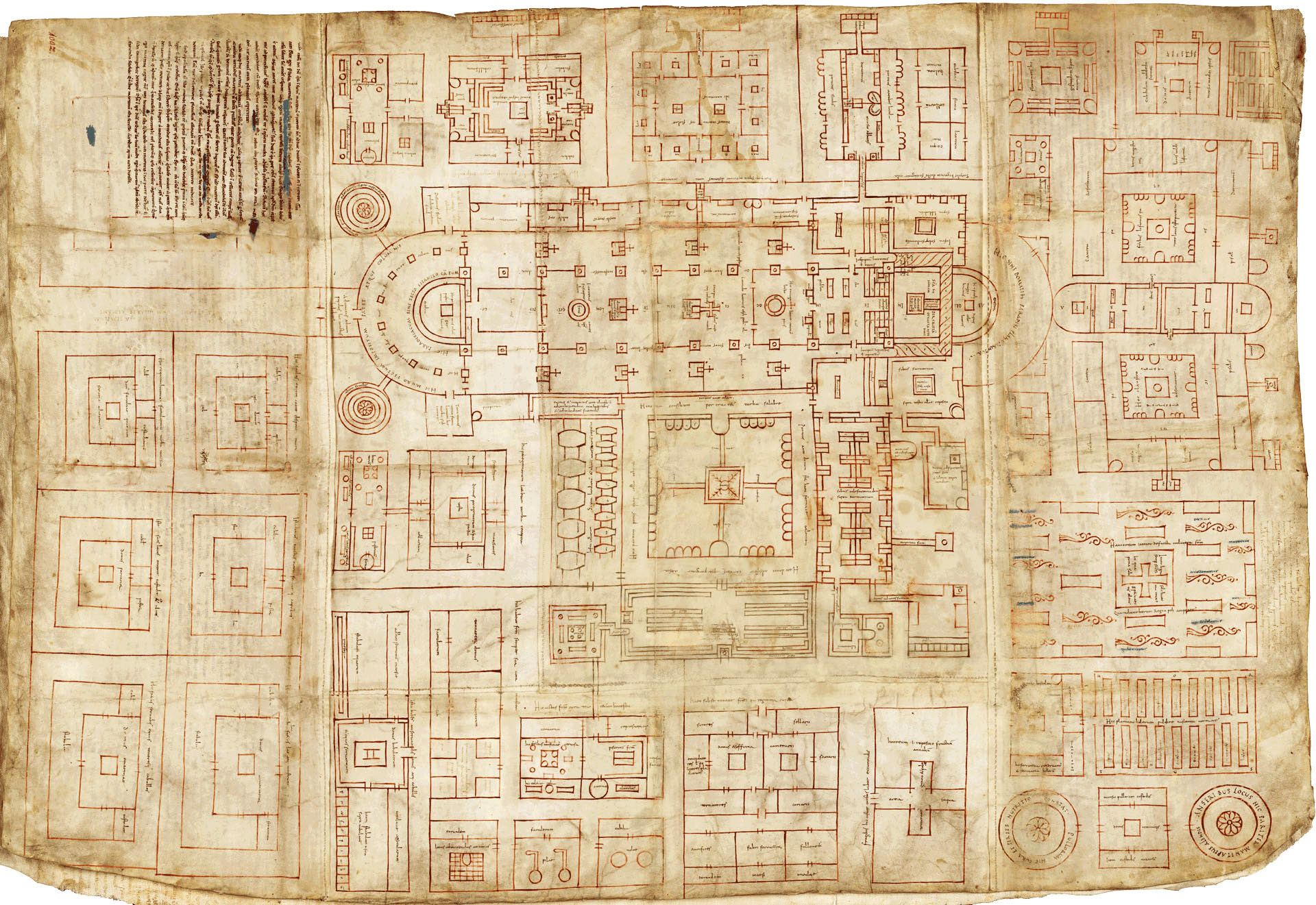
Cap el 800 Book of Kells, evangelis il·luminats.
Orient 476 – 799
724 Iconoclastes. Després de les derrotes davant l’islam, es va pretendre “purificar” la fe prohibint les representacions de Crist i es va destruir bona part de l’art fet fins aleshores.
800 – 1299
Amb Carlemany i Lluís el Pietós hi ha cert creixement cultural, es funden escoles i biblioteques.
Moviment monàstic seguint la regla de Sant benet. El Cistercenc a Citeaux. A third level of monastic reform was provided by the establishment of the Mendicant orders. Commonly known as friars, mendicants live under a monastic rule with traditional vows of poverty, chastity, and obedience, but they emphasise preaching, missionary activity, and education, in a secluded monastery. Beginning in the 12th century, the Franciscan order was instituted by the followers of Francis of Assisi, and thereafter the Dominican order was begun by St. Dominic.
Lluita entre gobernants (Henri IV) i el papa sobre qui tenia la potestat de nomenar els bisbes.
Moviument càtar i repressió. Inquisició.
Conversió d’escandinàvia, eslaus, Bulgària.
1054 El Cisma Orient – Occident
Though normally dated to 1054, the East-West Schism was actually the result of an extended period of estrangement between Latin and Greek Christendom over the nature of papal primacy and certain doctrinal matters like the Filioque, but intensified by cultural and linguistic differences.
Les croades
https://www.newyorker.com/magazine/2019/04/08/the-day-the-dinosaurs-died
The Hell Creek Formation spanned the Cretaceous and the Paleogene periods, and paleontologists had known for at least half a century that an extinction had occurred then, because dinosaurs were found below, but never above, the KT layer. This was true not only in Hell Creek but all over the world. For many years, scientists believed that the KT extinction was no great mystery: over millions of years, volcanism, climate change, and other events gradually killed off many forms of life. But, in the late nineteen-seventies, a young geologist named Walter Alvarez and his father, Luis Alvarez, a nuclear physicist, discovered that the KT layer was laced with unusually high amounts of the rare metal iridium, which, they hypothesized, was from the dusty remains of an asteroid impact. In an article in Science, published in 1980, they proposed that this impact was so large that it triggered the mass extinction, and that the KT layer was the debris from that event. Most paleontologists rejected the idea that a sudden, random encounter with space junk had drastically altered the evolution of life on Earth. But as the years passed the evidence mounted, until, in a 1991 paper, the smoking gun was announced: the discovery of an impact crater buried under thousands of feet of sediment in the Yucatán peninsula, of exactly the right age, and of the right size and geochemistry, to have caused a worldwide cataclysm. The crater and the asteroid were named Chicxulub, after a small Mayan town near the epicenter.
[Dels pocs seguidors inicials, expansió pels viatges dels apòstols, persecució, expansió i creació d’estructures de bisbes, oficialització per Constantí, definició del símbol o Credo, consolidació del Canon, escisió de l’ortodòxia Oriental, Monestirs]
Els apòstols prediquen el missatge de Jesús, segons els Actes. Els primers seguidors de Jesús eren jueus apocalíptics.
Una primera comunitat s’estableix a Antioquia [actualment Turquia, prop de Síria, a la mateixa latitud que Alep.
Pau de Tars Pau és descrit al Nou Testament com un jueu hel·lenitzat i ciutadà romà de Tars, a la regió de Cilícia (avui dia a Turquia), erudit del judaisme de la branca dels fariseus, i perseguidor dels cristians abans de la seva conversió pel camí de Damasc en la qual Pau va sentir la veu de Jesús, i es va convertir al cristianisme. Després de ser acceptat per la resta dels apòstols, va rebre l’encàrrec de predicar l’evangeli als “gentils” (és a dir, els no jueus) de l’imperi romà, portant el missatge del cristianisme a nombroses regions d’Àsia Menor i d’Europa incloent Roma i, segons la tradició, encara que no està escrit a la Bíblia, també a Hispània. Se li atribueix l’escriptura de catorze cartes o epístoles, conegudes com a Epístoles Paulines que constitueixen el fonament teològic i eclesiològic del Nou Testament i d’orientar definitivament la comunitat religiosa a superar la hipoteca d’un judaisme nacionalista i tancat que n’amenaçava la universalitat. Pau és venerat com a sant per tota la cristiandat. La seva festivitat se celebra el 29 de juny juntament amb la de Sant Pere, mentre que la festivitat de la seva conversió és el 25 de gener.
The development of doctrine, the position of orthodoxy, and the relationship between the various opinions is a matter of continuing academic debate. Since most Christians today subscribe to the doctrines established by the Nicene Creed, modern Christian theologians tend to regard the early debates as a unified orthodox position against a minority of heretics. Other scholars, drawing upon distinctions between Jewish Christians, Pauline Christianity, and other groups such as Marcionites and Montanists, argue that early Christianity was always fragmented, with contemporaneous competing beliefs.[13]
In the post-Apostolic church, bishops emerged as overseers of urban Christian populations, and a hierarchy of clergy gradually took on the form of episkopos (overseers, in-spectors; and the origin of the term bishop) and presbyters (elders; and the origin of the term priest), and then deacons (servants). But this emerged slowly and at different times for different locations. Clement, a 1st-century bishop of Rome, refers to the leaders of the Corinthian church in his epistle to Corinthians as bishops and presbyters interchangeably. The New Testament writers also use the terms overseer and elders interchangeably and as synonyms.[14]
Post-apostolic bishops of importance include Polycarp of Smyrna, Clement of Rome, and Ignatius of Antioch. These men reportedly knew and studied under the apostles personally and are therefore called Apostolic Fathers. Each Christian community also had presbyters, as was the case with Jewish communities, who were also ordained and assisted the bishop. As Christianity spread, especially in rural areas, the presbyters exercised more responsibilities and took distinctive shape as priests. Lastly, deacons also performed certain duties, such as tending to the poor and sick. In the 2nd century, an episcopal structure becomes more visible, and in that century this structure was supported by teaching on apostolic succession, where a bishop becomes the spiritual successor of the previous bishop in a line tracing back to the apostles themselves.
The diversity of early Christianity can be documented from the New Testament record itself. The Book of Acts admits conflicts between Hebrews and Hellenists, and Jewish Christians and Gentile Christians, and Aramaic speakers and Greek speakers. The letters of Paul, Peter, John, and Jude all testify to intra-Church conflicts over both leadership and theology. In a response to the Gnostic teaching, Irenaeus created the first document describing what is now called apostolic succession.[15]
As Christianity spread, it acquired certain members from well-educated circles of the Hellenistic world; they sometimes became bishops, but not always. They produced two sorts of works: theological and “apologetic“, the latter being works aimed at defending the faith by using reason to refute arguments against the veracity of Christianity. These authors are known as the Church Fathers, and study of them is called patristics. Notable early Fathers include Ignatius of Antioch, Polycarp, Justin Martyr, Irenaeus of Lyons, Tertullian, Clement of Alexandria, and Origen of Alexandria.
El 313 Constantí i Licinius emeten l’edicte de Milà que oficialitza la religió cristiana. La mare de Constantí, Helena, hauria viatjat a Jerusalem i fet construir una església al lloc del Sant Sepulcre. Constantí construeix Constantinopla i en farà la capital de l’imperi.
Entre les comunitats hi ha un debat sobre la naturalesa de Jesús. L’arrianisme afirmava que “Arri sostenia que el Fill va ser la primera criatura creada per Déu abans del principi dels temps. Segons l’arrianisme, aquest Fill, que després es va encarnar en Jesús, va ser un ésser creat amb atributs divins, però no era Déu en i per si mateix. ”
324 Concili de Nicea
Es condemna l’Arrianisme.
S’estableix el “símbol de Nicea”, modificat després a Constantinopla, que segueix essent pràcticament el mateix:
Crec en un sol Déu, Pare totpoderós, Creador del cel i de la terra, De totes les coses visibles i invisibles
I en un sol Senyor, Jesucrist, Fill Unigènit de Déu, Nascut del Pare abans de tots els segles Déu nat de Déu, Llum resplendor de la Llum, Déu veritable nascut del Déu veritable, engendrat, no pas creat, de la mateixa naturalesa del Pare: per ell tota cosa fou creada El qual per nosaltres els homes I per la nostra salvació davallà del cel.
I, per obra de l’Esperit Sant, s’encarnà de la Verge Maria, i es féu home. Crucificat després per nosaltres sota el poder de Ponç Pilat patí i fou sepultat, i ressuscità el tercer dia, com deien ja les Escriptures, i se’n pujà al cel, on seu a la dreta del Pare i tornarà gloriós, a judicar els vius i els morts i el seu regnat no tindrà fi. Crec en l’Esperit Sant Que és Senyor i infon la vida Que procedeix del Pare i del Fill. I juntament amb el Pare i el Fill és adorat i glorificat; que parlà per boca del profetes.
I en una sola Església, santa, catòlica i apostòlica. Professo que hi ha un sol baptisme per perdonar el pecat i espero la resurrecció dels morts, i la vida de la glòria. Amén
Organització
Seguint l’estructura de l’impoeri es creen diòcesis regides per bisbes. Les principals són Roma (el bisbe de la qual té la primacia), Constantinopla, Jerusalem, Antioquia i Alexandria.
Debats i concilis
Mare de Jesús però no mare de Déu, Nestorianisme, Concili de Efès (451)
Concili de Calcedònia, contra el miafisitisme. Cisma de l’església oriental ortodoxa, ( l’armenia, copta (i etíop) i siríaca ).
Vida monàstica
Dins de l’església copta, van aparèixer una sèrie d’ermitans que feien vida ascètica al desert.
Sant Antoni (251 – 356), ( té el vessant de patró dels animals, i se’l representa amb un porquet, i el vessant del sant resistint les temptacions. Les històries de les seves temptacions pel dimoni seran representades per Hyeronimus Bosch i altres. Flaubert li dedicà una novel·la).
Sant Jeroni (331 – 420) Ermità i traductor de la Bíblia. Molt representat a la història de l’art.
Sant Basili de Cesarea (335 – 379). El 355 va tornar a Cesarea i va fer un temps d’advocat però aviat ho va deixar per dedicar-se a la vida religiosa tal com també va fer la seva germana Macrina. El 357 va viatjar per Síria, Palestina i Egipte per aprendre de la vida monàstica i a la tornada es va retirar a una muntanya a la vora del riu Iris prop de Neocesarea on va viure en reclusió per 13 anys fundant el monestir d’Ibori. Allí la família tenia una finca on Basili va reunir un grup de devots als que es va unir aviat Gregori Nazanzié. En aquests anys es va dedicar a la lectura i el seu escriptor favorit fou Orígens. Va predicar també per tot el Pont. | Va viure a la Capadòcia, va construir cases pels pobres. Va moderar les pràctiques extermes d’ascetisme definint une línies moderades al Asketikon, The most striking qualities of the Basilian Rule are its prudence and its wisdom. It leaves to the superiors the care of settling the many details of local, individual, and daily life; it does not determine the material exercise of the observance or the administrative regulations of the monastery. Poverty, obedience, renunciation, and self-abnegation are the virtues which St. Basil makes the foundation of the monastic life. Link. La seva regla s’extengué primer a la Capadòcia i després a tots els monestirs de l’església oriental.
Tanakh, la Bíblia hebrea té 24 llibres, 5 al Pentateuc, 8 de profetes (Nevim), i 11 didàctics (Ketuvim).
La Torah, Pentateuc (hebreu), escrit durant l’exili a Babilònia sVI BCE a partir de tradicions orals més antigues, la jahvista, la elohista, la Deutoronòmica i la Sacerdotal.
Nevi’m, Profetes: Josué, Jutges, Samuel, Reis | Isaïes, Jeremies, Ezequiel | els profetes menors. [escrits durant el captiveri a Babilònia)
Ketuvim: Salms, proverbis, Job. | llibres per a certes ocasions Càntic dels càntics (Pessah la pasqua jueva que commemora la sortida d’Egipte) , Rut (Shavuot, la pentecosta), Lamentacions (tishva) , Eclesiastès (es llegeix a la festa del Sukkot), Ester. | Daniel, Esra i Nehemies, Cròniques. [possiblement a l’epoca del segon temple 500-70, 450-200 Eclesiastès o Kohelet]
Els llibres de Tobit, Judit, Macabeus, Saviesa, Sirach i Baruc són inclosos pels catòlics i ortodoxos però exclosos per jueus i protestants.
Original en hebreu (encara que el document més antic a vegades és en grec koiné, l’estil evidencia que és una traducció d’una llengua semítica), les fonts més antigues, són la traducció grega de la Septuaginta (-200), la traducció a l’assiri de la Pehitta, la Torah samaritana. Entre els segles VII i X es consolidà el text masorètic en hebreu que es correspon bastant bé amb els fragments que s’han trobat als rotlles del mar mort. Algun text, com el profeta Daniel, estava escrit en arameu.
Des d’Alexandre, la llengua comuna a Orient era el grec koiné
La Torah oral: Mishnah, Gemara, Talmud
A més de la Torah escrita, que Déu hauria entregat a Moisès, hi ha la Torah oral que s’hauria anat transmetent oralment des dels temps de Moisès. “Represents those laws, statutes, and legal interpretations that were not recorded in the Five Books of Moses, the “Written Torah” (Hebrew: תורה שבכתב, Torah she-bi-khtav, lit. “Torah that is in writing”), but nonetheless are regarded by Orthodox Jews as prescriptive and co-given. This holistic Jewish code of conduct encompasses a wide swathe of rituals, worship practices, God–man and interpersonal relationships, from dietary laws to Sabbath and festival observance to marital relations, agricultural practices, and civil claims and damages. ”
The major repositories of the Oral Torah are the Mishnah, compiled between 200–220 CE by Rabbi Yehudah haNasi, and the Gemara, a series of running commentaries and debates concerning the Mishnah, which together form the Talmud, the preeminent text of Rabbinic Judaism.
Canon del nou testament
Els 27 llibres del Nou testament (els quatre evangelis, Actes dels apòstols i Epístoles) ja es feien servir per Origenes.
Escrits en grec koiné entre el 100 i 300 CE.
El 382 El Papa Damasus encarregà a Sant Jeroni la traducció de la Bíblia al llatí i es fixen els llibres del Nou Testament. Es coneixerà com la Vulgata.
El 1545 el Concili de Trento fixa la traducció de sant Jeroni, la Vulgata, com a text oficial.
Traduccions
The first complete Catalan Bible translation was produced by the Catholic Church, between 1287 and 1290. It was entrusted to Jaume de Montjuich by Alfonso II of Aragon. Remains of this version can be found in Paris (Bibliothèque Nationale). El 1478 Bonifaci Ferrer. Ferrer’s translation, known as the Valencian Bible, was printed in 1478 before any Bible was printed in English or Spanish.
1522 Bíblia de Luter
1611 King James Bible, projecte encarregat pel rei a 47 estudiosos que la fixà per a l’Església d’Anglaterra.
New Yorker sobre les traduccions i com reflecteixen el pensament i la peosia de cada època.
Manuscrits de la mar morta: trobats el 1947 a les coves de Qumran. Probablement amagats pels Essenis en temps de la revolta contra els romans. Ara es conserven al Shrine of the Book. L’estudi dels manuscrits bíblics de Qumran ha demostrat que, a l’època anterior a l’aparició del cristianisme, la tradició textual bíblica era molt més plural i variada que no que s’esperava.
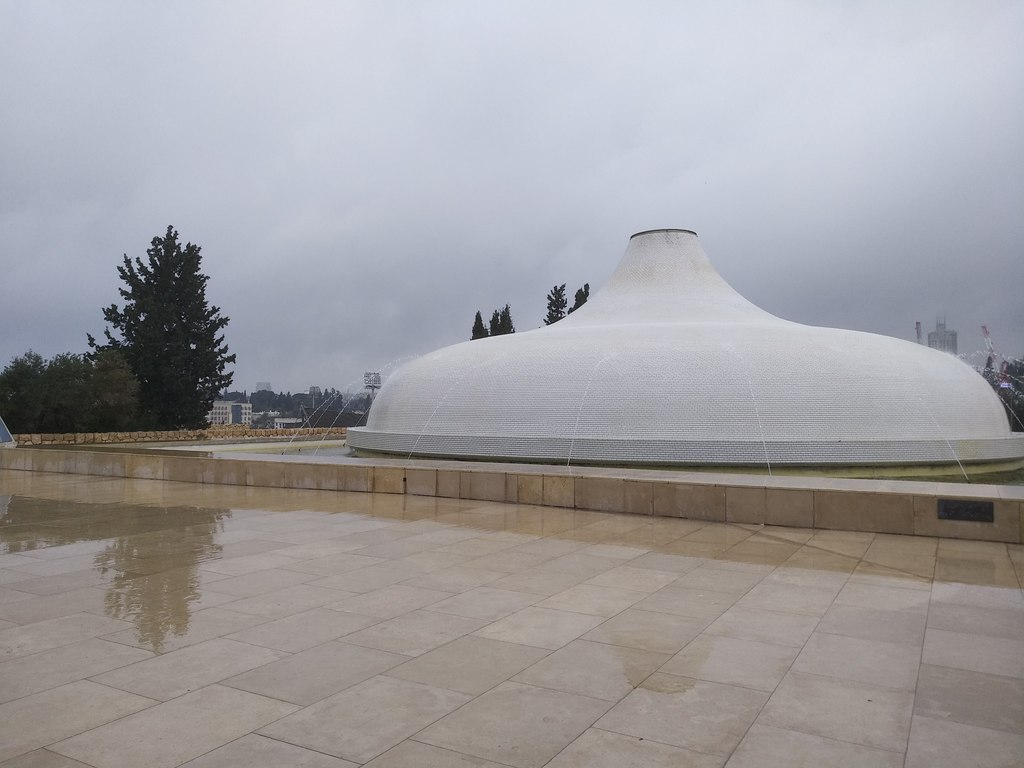
Nag Hammadi: el 1945 es van trobar a la ciutat egípcia de Nag Hammadi un conjunt de textos gnòstics, en copte, parts del corpus hermeticum, una traduccó de Plató i els anomenats evangelis gnòstics, Tomàs, Felip, així com diversos apocalipsis.
Altres: Els Actes de Joan, amb l’himne de la dansa
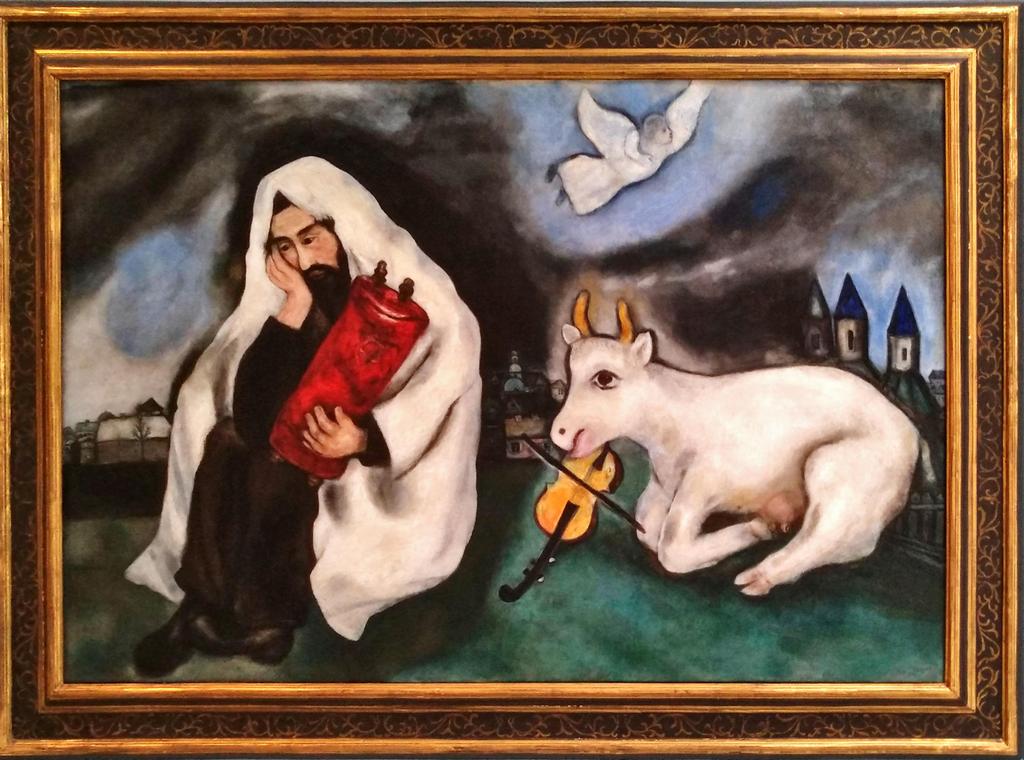
Israel Museum.
In 1933, the Nazi party came to power in Germany on a platform that, among other things, openly espoused hatred against Jews and called for their repression and removal from Germany. Germany, however, was far from being the only country to have such a change. Eastern Europe, where there was a historically large population of Jewish people, anti-Semitism was a recurring problem that intensified every few decades before dying down again.
The 1930s saw another such cycle in that area of the world and Chagall, as an Eastern European Jew himself, with many friends and family in those countries, felt this rise of anti-Semitism strongly. In 1934, while in Warsaw, Poland, Chagall witnessed one of his friends assaulted in the street for his religious beliefs. In 1937, the Nazis confiscated 59 of Chagall’s paintings then on the territory of Germany and showed them as part of an exhibition entitled Degenerate Art (Entartete Kunst).
The painter’s response was to attempt to reconcile the two conflicting religions, Judaism and Christianity, through art. In Chagall’s painting Solitude (1933), he depicts the profound sadness and pain felt by the Jewish people in the brewing storm.
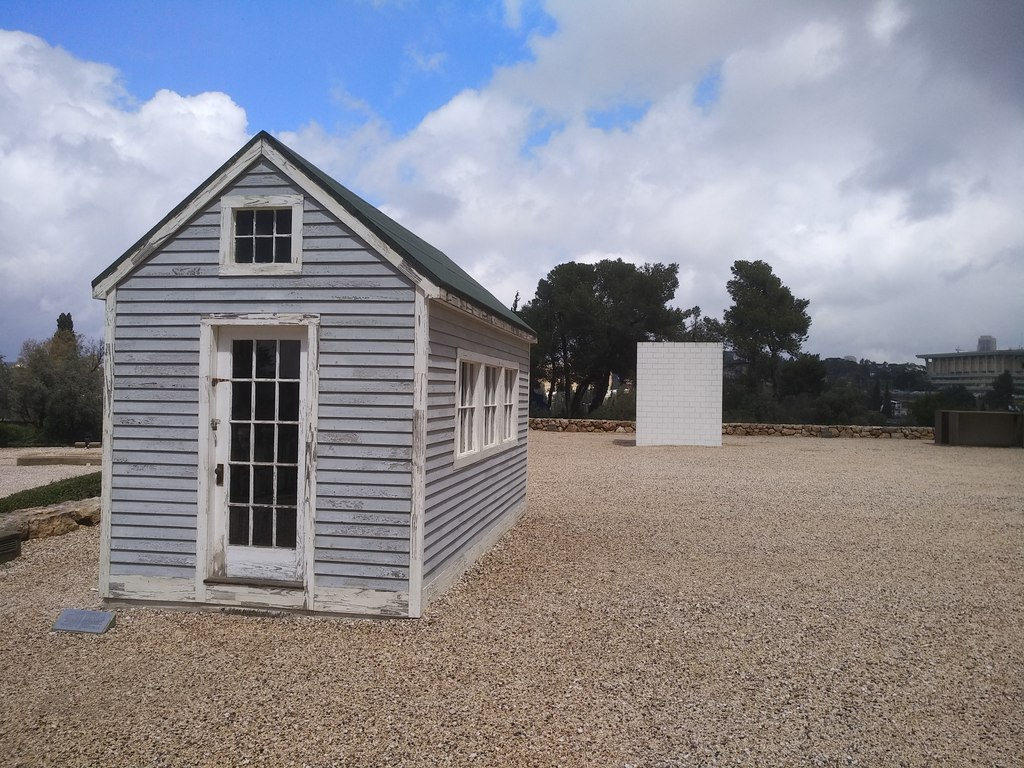
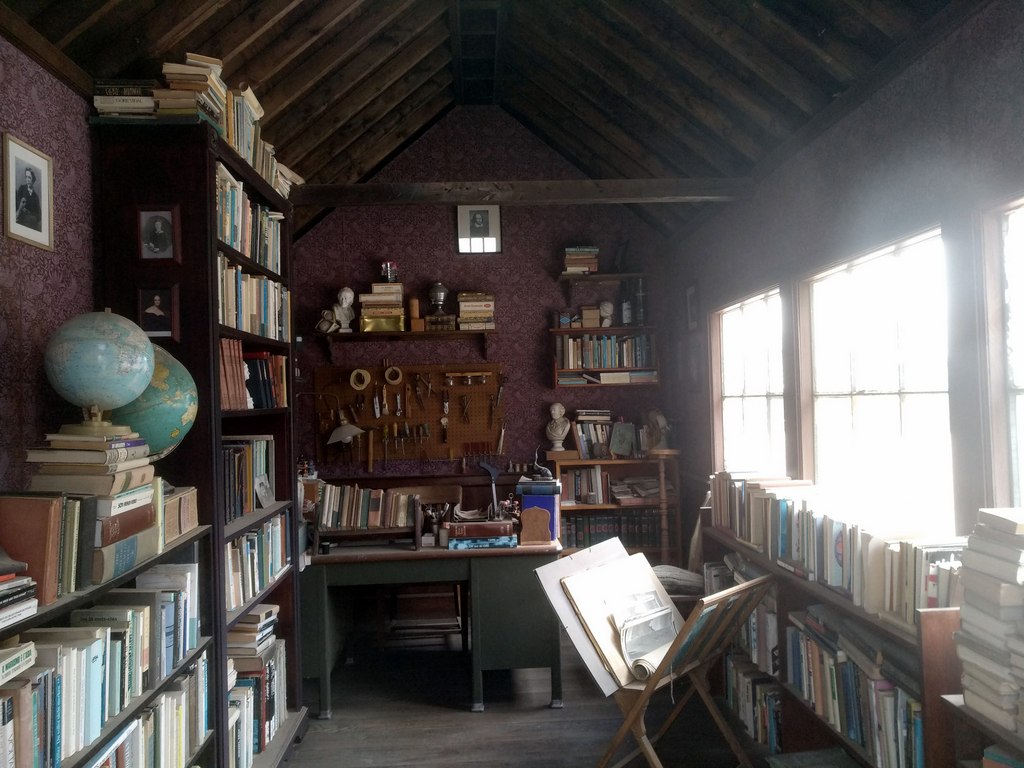
[em va fer venir unes ganes irresistibles de tenir un globus terraqui]

Israel Museum. Jerusalem
Komorov s’envola després d’una discussió amb la dona, al cel hi troba altra gent volant, alguns sols, altres que es fan petits fins a ser confosos amb ocells.
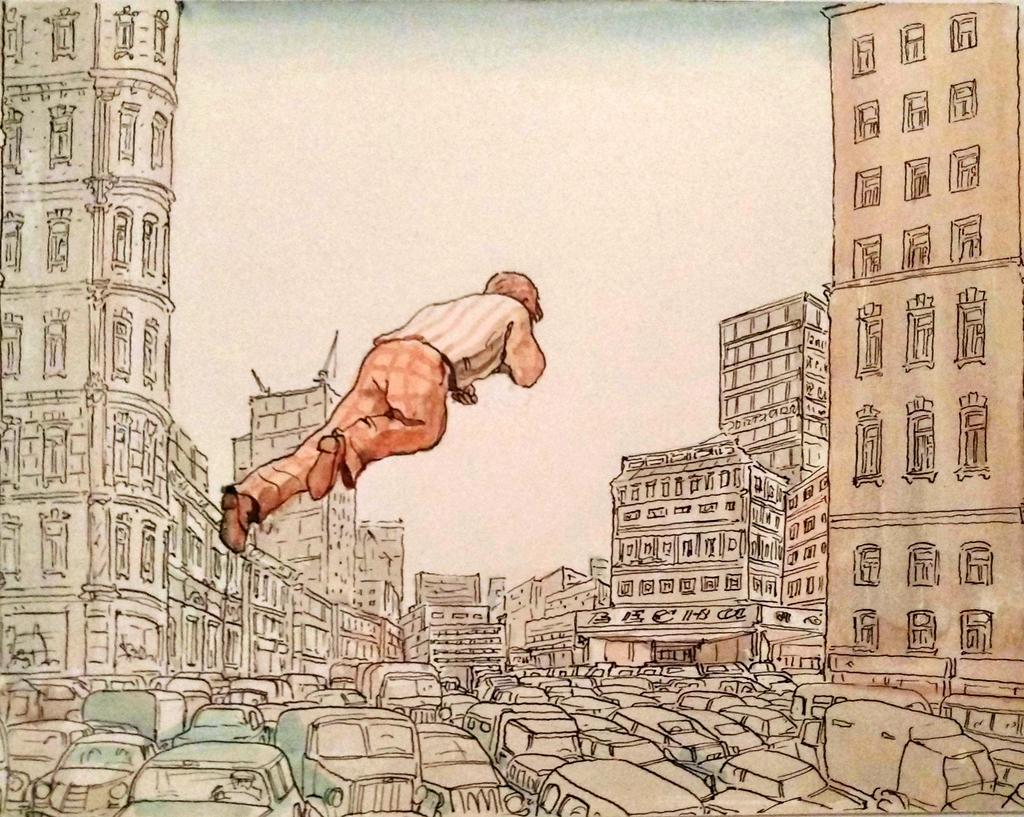
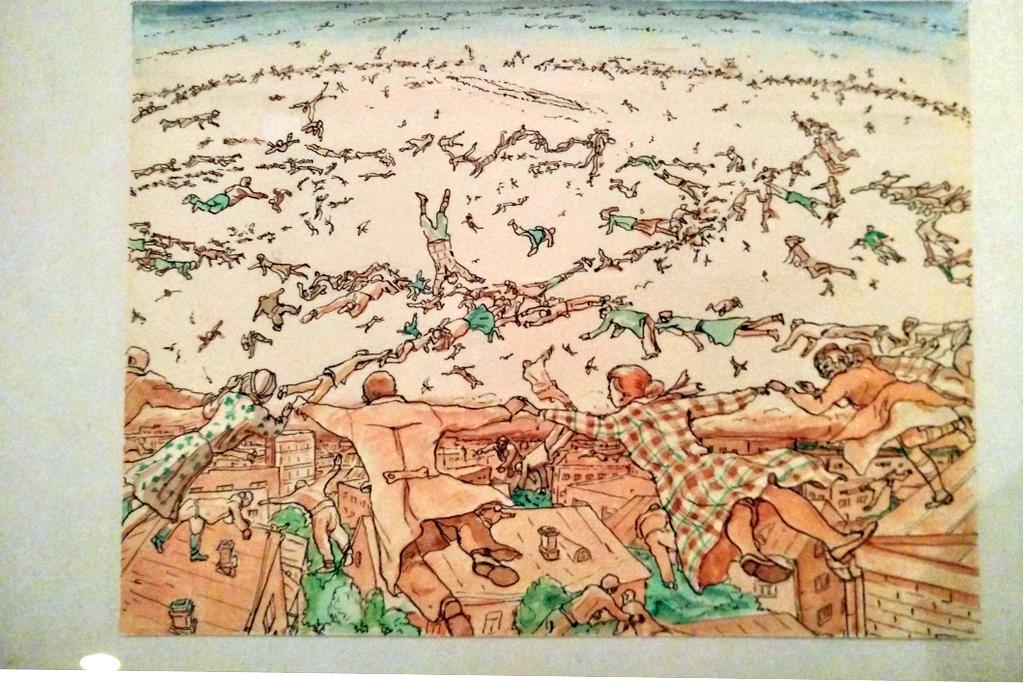

A mi m’il·lustra el somni de sortir volant. Forma part de la sèrie 10 caràcters.
The ten albums tell ten fables: they suggest ten positions from which Homo Sovieticus can react to his world, ten psychological attitudes, ten perspectives on emptiness, ten parodies of the aesthetic traditions through which Kabakov evolved his vocabulary, ten aspects of Kabakov’s personality.
In the album The Joker Gorokhov, the ‘humorous’ attitude toward life comes under criticism as a way of perceiving one’s surroundings that is too light, non-conflictual.
In the album, Generous Barmin, what is analyzed is the capability and desire of each person to ‘define’ another person, to impart to him various qualities, as a rule, that have nothing in common with the actual person.
In the album Agonizing Surikov, the character suffers because life, the meaning of life, is concealed from him by a film. He sees only parts, shreds, fragments through this curtain.
The album Anna Petrovna Has a Dream tells about a soul that no longer has a material, physical shell. This soul travels amidst our world, not touching anything, and ultimately it flies off, abandoning this world.
The Flying Komarov is a utopia of bliss, a state of eternal hovering, suspension between heaven and earth, between a dream and reality.
In Mathematical Gorsky we have the fear of winding up in a compulsory series with ‘others,’ a desire no matter what to ‘leave the series,’ to abandon it.
The album The Decorator Malygin is about the impossibility, the lack of desire, to wind up in the ‘center,’ to step out into the ‘middle,’ about the desire to hide in the corner, to be ‘on the edge,’ ‘on the side.’
The Released Gavrilov tells about the desire to run, disappear, dissolve, lose oneself in nature, where nature is the image of happy idleness, happy non-being.
The last album of Ten Characters – The Looking- Out-the-Window Arkhipov – tells about a dying consciousness where the images of consciousness blur like temporary designs on glass, and a vision of another world emerge before one’s consciousness.
Artista conceptual de Moscú dels 80. Vaig veure també “vida a l’armari”.
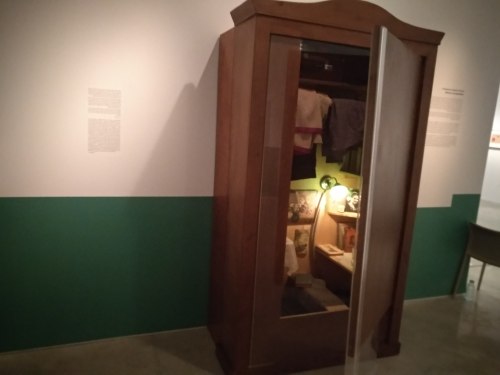
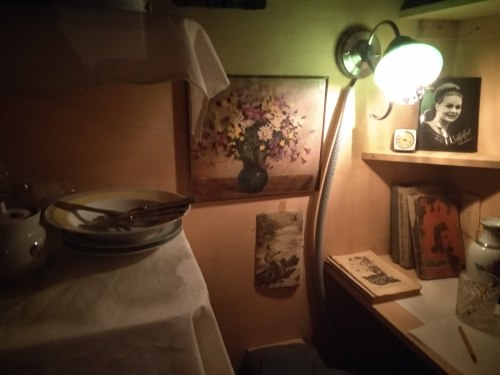
https://ilya-emilia-kabakov.com/
Aquest és un exemple de les instal·lacions que ha fet la resta de la seva carrera. Cadascuna un món imaginari que convida a entrar-hi.
Els misteris d’Eleusis estan relacionats amb un mite de la dea Demèter, narrat per Homer en un dels seus himnes, datat aproximadament en l’any 650 aC. Aquest himne diu que la filla de Demèter, Persèfone (de vegades anomenada amb l’epítet Kore, deessa Demèter, narrat per Homer en un dels seus himnes datat aproximadament en l’any 650 aC. Aquest himne diu que la filla de Demèter, Persèfone (de vegades anomenada amb l’epítet Kore, «donzella») estava collint flors amb unes amigues quan va ser raptada i transportada a l’Hades, el món subterrani dels morts. Desesperada, Demèter va buscar per tot arreu la seva filla, però no la va trobar i llavors va provocar una gran sequera que va causar la pèrdua de les collites dels humans i la seva fam. La deessa esperava així commoure Zeus i fer que intercedís pel retorn de la seva filla, cosa que finalment va passar.
Demèter dóna llavors de blat a Triptòlem mentre Persèfone el beneeix amb la mà. Relleu del segle V, exhibit al Museu Arqueològic Nacional d’Atenes
Segons el mite, durant la seva cerca, Demèter va viatjar a llargues distàncies i va tenir algunes aventures menors. En una ocasió, va ensenyar els secrets de l’agricultura a Triptòlem, rei d’Eleusis.[4] Amb el retorn de Pesèfone, Demèter estava tan contenta que va fer tornar l’originària verdor i prosperitat a la terra, cosa que els humans recordaven com la primera primavera.
Era una norma de les moires que qui consumia menjar o beguda en l’inframon estava condemnat a passar l’eternitat en aquell lloc. Hades va temptar Persèfone a menjar una mica de magrana i per això, quan Zeus, pressionat pels gemecs de fam dels humans i per altres deïtats que havien deixat de ser honorats amb sacrificis pels humans, va enviar Hermes en nom seu amb l’ordre d’alliberar-la, ella es va veure obligada a tornar a l’inframon on s’havia d’estar uns sis mesos cada any. Quan Demèter estava sense la seva filla, s’entristia i descuidava la terra, però quan tornava Persèfone, la terra tornava a ser un lloc fèrtil. Aquesta és una explicació del pas de les estacions, el seu efecte sobre l’agricultura[5] i una justificació dels estius secs del clima a Grècia
Misteris: caminada d’Eleusis a Atenes (25km)
El primer acte dels misteris majors (el dia 14 del boedromion) consistia en el transport dels objectes sagrats des de la ciutat d’Eleusis fins a l’Eleusinion, un temple dedicat a Demèter situat als peus de l’acròpoli d’Atenes.
Els misteris majors, que començaven al boedromion (el tercer mes del calendari àtic, a finals d’estiu) duraven deu dies. Al segon dia, que es deia Agyrmos (la reunió), els sacerdots anomenats hierofants declaraven l’inici dels ritus (prorrhesis) i realitzaven els sacrificis (hiereía deúro). El dia 16 del boedromion els iniciats es purificaven banyant-se a Faleros, el port d’Atenes (i eren anomenats halade mystai).
L’endemà començava l’Epidàuria, una festa en honor a Asclepi. Aquesta festa, inclosa dins dels misteris majors, celebrava l’arribada de l’heroi (Asclepi) a Atenes amb la seva filla Higieia, i consistia en una processó que acabava arribant a l’Eleusinion. Mentre es feia la processó, sembla que els iniciats s’estaven a casa sense participar o en una sala lateral al temple, cosa que era un gran sacrifici, i també es perdien la festa que durava tota la nit (pannykhís).[17]
La processó començava al Kerameikos (el cementiri d’Atenes) i anaven caminant fins a Eleusis per una ruta anomenada via sagrada (Ἱερὰ Ὁδός, Hierá Hodós) mentre sacsaven uns branquillons anomenats bacchoi. En arribar a un determinat punt, exclamaven obscenitats en commemoració de Iambe (o Baubo), una dona d’edat que, explicant acudits obscens havia aconseguit fer somriure Demèter quan estava desconsolada per la pèrdua de la seva filla. El seguici cridava: “Íakch’, O Íakche!” referint-se a Iacus, potser un epítet del déu Dionís o un déu amb identitat pròpia, fill de Persèfone o Demèter.[18] L’estàtua de Iacus també era transportada en la processó, i es custodiava al temple de Demèter a Atenes.[19]
En arribar a Eleusis, hi havia una nit de vigília (pannychis),[20][21] potser en record del període de recerca de Demèter. En un moment indeterminat, els iniciats s’empassaven un beuratge anomenat kykeon fet de civada i poliol, que ha donat lloc a especulacions sobre els possibles components químics i els efectes psicotròpics del beuratge.
Els dies
20 i 21 del mes, els iniciats entraven en una gran sala anomenada Telesterion; al centre estava l’Anaktoron (el palau), dins el qual només els hierofants podien accedir i on es desaven els objectes sagrats. Abans d’entrar, els iniciats havien de recitar: “He fet dejuni, he begut el kykeon, he pres del que hi havia a la cista i després de fer-ho servir ho he ficat al kalathos”.[22] És una suposició molt acceptada que els ritus de l’interior del Telesterion incloïen tres elements:
dromena («coses fetes»), una dramatització del mite de Demèter/Persèfone;
deiknumena («coses mostrades»), exposició d’objectes sagrats en la qual el hierofant tenia un paper protagonista;
legomena («coses dites»), comentaris que seguien a la deiknumena.[23]
Hi havia un càstig per divulgar el conjunt d’aquests tres elements, als quals es feia referència conjuntament amb el nom d’apporheta (‘irrepetibles’). Atenàgores d’Atenes, Ciceró i altres escriptors de l’antiguitat diuen que, acusat d’això (entre altres delictes), Diàgores de Melos fou condemnat a mort;[24][25] i també el dramaturg Èsquil, però finalment fou absolt.[26] La prohibició de divulgar la part central dels misteris era, per tant, absoluta.
Pel que fa al clímax dels misteris, hi ha dues teories modernes. Una proposta diu que eren els sacerdots els qui revelaven les visions de la nit sagrada, encenent un foc que representaria la possibilitat de la vida després de la mort i mostrant diversos objectes sagrats. L’altra creu que aquesta explicació és insuficient per a justificar la força amb què estaven arrelats aquests rituals i la seva perdurabilitat al llarg dels temps; per tant, proposa que les experiències devien ser interiors, a les quals es devia accedir amb algun ingredient psicoactiu del beuratge (teories enteogèniques).
En acabar aquesta part dels misteris, venia una nit de banquet, alegria i danses (el Pannychis).[27] Les danses es feien al Ράριον πεδίον (‘camp del Rarion’), que la tradició deia que era el lloc on havia crescut la primera llavor plantada pels humans. Se sacrificava un bou a finals de la nit o a primera hora de l’endemà. El darrer dia, els iniciats honoraven els difunts fent libacions a les tombes i fent servir unes gerres especials.
El dia 23 del boedromion, els misteris es donaven per finalitzats i tothom tornava a casa seva.
El 392 Teodosi va acabar amb els santuaris com a part de la persecució dels pagans.
La majoria dels autors fan d’Orfeu, fill d’Èagre i de la Musa Cal·líope, originari de la regió de Tràcia [NE Grècia, S Bulgària, W Turquia, vall del riu Marica]. Sovint, però, apareix com a progenitor el déu Apol·lo, fet que explicaria els extraordinaris dots musicals (tant vocals com instrumentals) d’Orfeu i explicaria també que sigui la cítara el seu instrument per excel·lència (Apol·lo va sempre associat a la música de corda).
Els testimonis escrits més antics fan d’Orfeu un membre de l’expedició de Jàson a bord la nau Argo a la recerca del velló d’or: Ferecides, recollit per un escoli a Apol·loni de Rodes, la Pítica IV de Píndar, la tragèdia d’Eurípides Hypsipyle i Herodor d’Heraclea.
The most famous story in which Orpheus figures is that of his wife Eurydice (sometimes referred to as Euridice and also known as Argiope). While walking among her people, the Cicones, in tall grass at her wedding, Eurydice was set upon by a satyr. In her efforts to escape the satyr, Eurydice fell into a nest of vipers and suffered a fatal bite on her heel. Her body was discovered by Orpheus who, overcome with grief, played such sad and mournful songs that all the nymphs and gods wept. On their advice, Orpheus travelled to the underworld. His music softened the hearts of Hades and Persephone, who agreed to allow Eurydice to return with him to earth on one condition: he should walk in front of her and not look back until they both had reached the upper world. He set off with Eurydice following, and, in his anxiety, as soon as he reached the upper world, he turned to look at her, forgetting that both needed to be in the upper world, and she vanished for the second time, but now forever.[Banquet de Plató, Virgili, Metamorfosis X XI]
Mort
Feeling spurned by Orpheus for taking only male lovers, the Ciconian women, followers of Dionysus] first threw sticks and stones at him as he played, but his music was so beautiful even the rocks and branches refused to hit him. Enraged, the women tore him to pieces during the frenzy of their Bacchic orgies.
L’orfisme fou un moviment religiós mistèric de l’antiga Grècia, l’origen del qual es remunta al segle vii o VIII aC. La seva fundació es va atribuir al mític poeta i músic Orfeu (fill de la musa Cal·líope), que en els seus himnes (Himnes òrfics) narra el nucli mític de la creença. L’orfisme consistia a no donar plaers al cos per purificar l’ànima (ascetisme): eren vegetarians, no els importaven les coses materials. Feien això perquè creien en la reencarnació de l’ànima.[1]
L’orfisme defensà el que es coneix com a metempsicosi. Aquest concepte consisteix en la creença de la transmigració de l’ànima a altres cossos després de la mort. Aquesta migració de l’ànima es podia produir entre animals i humans. Aquesta secta va influir notablement en la filosofia, especialment en Pitàgores i els pitagòrics, també anomenats orficopitagòrics.
Inspirà Claudio Monteverdi’s L’Orfeo (1607), Luigi Rossi’s L’Orfeo (1647), Christoph Willibald Gluck’s Orfeo ed Euridice (1762), Joseph Haydn’s last opera L’anima del filosofo, ossia Orfeo ed Euridice (1791), Franz Liszt’s symphonic poem Orpheus (1854), Igor Stravinsky’s ballet Orpheus (1948) .
Els sonets a Orfeu de Rilke (1922)

Horaci, ODES I.12
¿Quin home, quin heroi et proposes de celebrar amb la lira o amb l’aguda flauta, Clio? ¿Quin déu? ¿De qui és el nom que l’eco burlesc repetirà dins les ombroses rodalies de l’Helicó o al cim del Pindos o al glaçat Hemos, des d’on els boscos seguiren d’esma el cantor Orfeu, el qual, amb l’art après de la seva mare, feia aturar el corrent ràpid dels rius i els vents veloços, i era dolçament hàbil a conduir amb les seves cordes harmonioses els roures, que el sentien?
Vist al Bilbao el 2014: Un dels alicients de venir a Bilbao i al Gugen era l’exposició de Rajnar Kjartansson, The Visitors de la qual n’havia llegit la ressenya al New Yorker. Ha superat les meves expectatives, 9 pantalles, vuit músics separats en les habitacions d’una mansió, connectats pe auriculars. Un pianista fumant un puro, un calb al banjo i baix en la butaca d’un escriptori, un guitarrista, una noia delicada a l’acordió, una noia fina al cello, un noi a la guitarra assegut al llit al costat d’una noia ajaguda, un barbut a la banyera cantant amb guitarra, una bateria magnífic a la cuina. Comencen poc a poc amb silencis, i neix la música comuna. Emociona. La lenta cançó va creixent, afluixa, repren, alguns canvien de cambra, un dels de la terrassa carrega un canonet. Tot plegat dura gairebé una hora. Mai havia vist res semblant. En ser el primer, no hi havia gairebé ningú i era ben bé com ser un fantasma movent-me lliurement per les habitacions de la mansió.
Una cabana que seria la botiga d’un antiquari, plena de llibres, globus terraquis i altres objectes. Mark Dion


De fora semblava una capsa blanca sense més però en baixar sota el turó, un corredor travessa el mur i de sobte em vaig trobar en un espai blanc, buit, amb un banc de marbre lleugerament inclinat per mirar una obertura al sostre que definia un quadrat de cel.
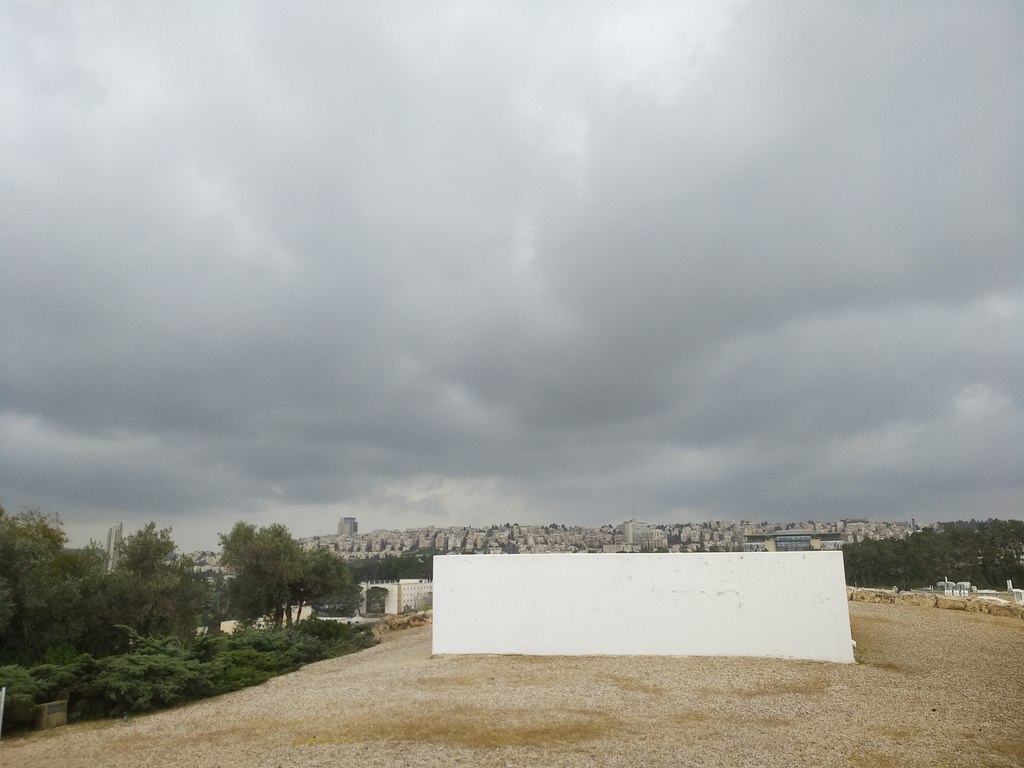
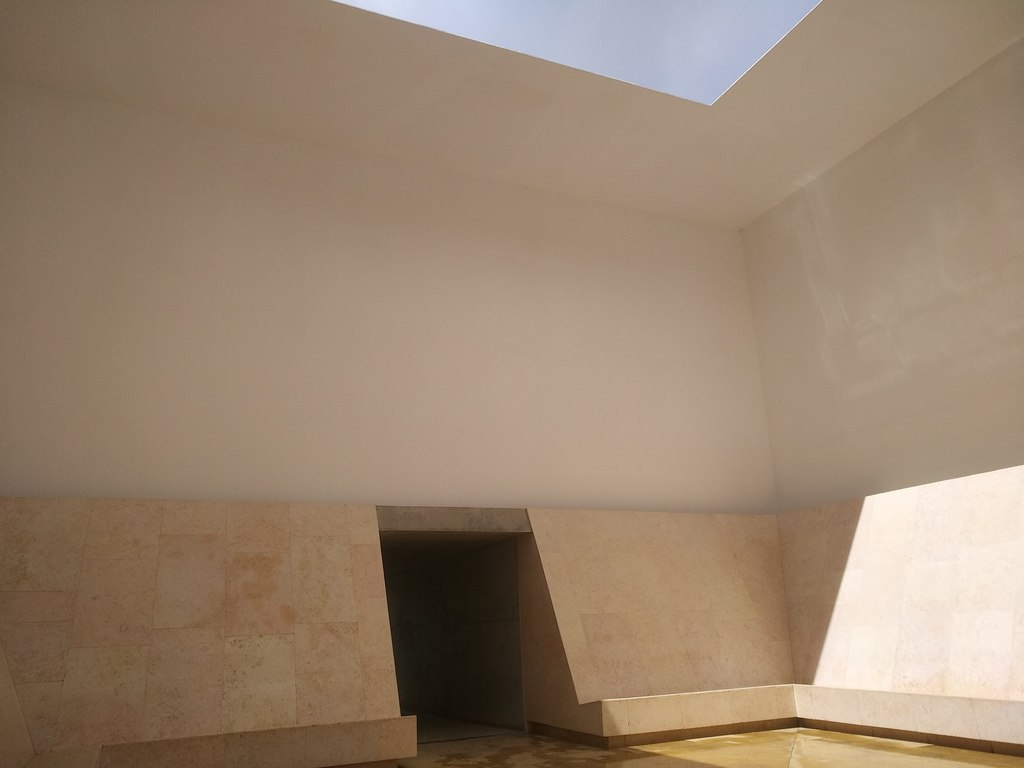
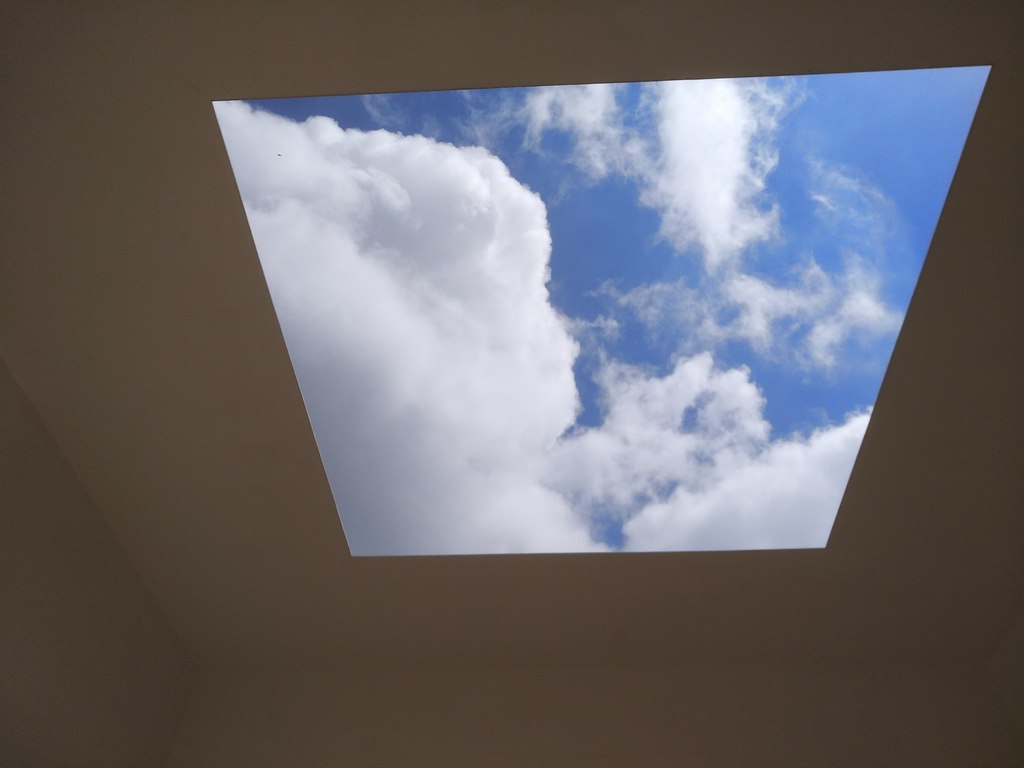
No hi havia ningú més i vaig seure escoltant la música de Carles Viarnes i mirant com canviava el quadrat de cel.
James Turrell a la wikipedia. Llista d’obres. Obres per ubicació. Nascut el 1943 en una família quaker fou empresonat un any per fer campanya contra la guerra de Vietnam. Treballa amb la llum i té una sèrie dedicada a la contemplació del cel, Skyspaces. Durant dècades ha estat treballant en un cràter prop de Flagstaff Arizona, en una gran instal·lació per contemplar el cel i els planetes. Treballa també amb projeccions de formes de llum, o espais on els límits que difosos.
Fundada per sant Pere a Antioquia
Segons la tradició, l’Església siríaca és hereva d’una de les comunitats cristianes més antigues, establerta a Antioquia per l’apòstol Sant Pere, que és considerat el primer bisbe del Patriarcat d’Antioquia. Segons els Fets dels Apòstols (11,26), fou a Antioquia on els deixebles de Crist foren anomenats cristians per primer cop.[3]Eudias i Ignasi[4] succeïren Sant Pere com a bisbes, morint ambdós durant les persecucions romanes. Des d’aleshores, gairebé tots els patriarques siríacs accedeixen al títol amb el primer nom d’Ignasi.[5] Fins que rebutjà les conclusions de Concili de Calcedònia, el 451, l’Església Siríaca havia format part de la pentarquia d’esglésies cristianes, participant decisivament en els consicilis de Nicea, Constantinoble i Efes. Les autoritats bizantines imposaren les decisions de Calcedònia, i els monofisites dissidents es van refugiar a zones desèrtiques sirianes i àrabs, així com a territoris del veí Imperi Sassànida.
A mitjans del segle VI apareix la figura del bisbe monofisita Jacob Baradai (després bisbe d’Edesa), qui, enviat a Síria en secret per l’emperadriu Teodora (que afavoria la seva causa), va reorganitzar i donar impuls a una església que ja es pot considerar l’Església Ortodoxa Siríaca. Va ser Baradai qui nomenà Sergi com a primer patriarca ortodox siríac el 544, fent així definitiu el cisma amb el patriarca grec ortodox. Des d’aleshores també s’ha conegut l’església com a jacobita.
Fundada pr l’apòstol Tomàs. Des d’Antioquia (a l’actual Turquia), van difondre els cristianisme a Mesopotàmia i Pèrsia. 310 concili a Selèucia (80km al nord de Babilònia). El 424 l’Església de Pèrsia se separa de la d’Antioquia. El 431 431, el Concili d’Efes condemna Nestori, el patriarca de Constantinoble, i les seves posicions cristològiques (segons la qual Maria era mare de Jesús però no mare de Déu).
Al Milione de Marco Polo la majoria de comunitats cristianes que troba són nestorians.
Depenia administrativament de l’església copta fins que el 1959 se’n va independitzar.
Al concili de Calcedònia es separà amb la copta seguitn el miofisitisme.
El 333 va ser declarada religió d’estat. Actualment té 45-50 milions de fidels (dels 76 de l’esgésia ortodoxa oriental).
Oriental Orthodox Christianity became the established church of the Ethiopian Axumite Kingdom under king Ezana in the 4th century when priesthood and the sacraments were brought for the first time through a Syrian Greek named Frumentius, known by the local population in Ethiopia as “Abba Selama, Kesaté Birhan” (“Father of Peace, Revealer of Light”). As a youth, Frumentius had been shipwrecked with his brother Aedesius on the Eritrean coast. The brothers managed to be brought to the royal court, where they rose to positions of influence and baptized Emperor Ezana.
Ezana sent Frumentius to Alexandria to ask the Patriarch, St. Athanasius, to appoint a bishop for Ethiopia. Athanasius appointed Frumentius, who returned to Ethiopia as Bishop with the name of “Abune Selama”. From then on, until 1959, the Pope of Alexandria, as Patriarch of All Africa, always named an Egyptian (a Copt) to be Abuna or Archbishop of the Ethiopian Church.
Es creu que fou fundada per sant Marc.
S’escindí en el concili de Calcedònia sobre la naturalesa de Crist.
Fa servir la llengua copta que prové de l’antic egipci i s’escriu amb caràcters grecs.
https://en.wikipedia.org/wiki/Coptic_Orthodox_Church_of_Alexandria
Many Egyptian Christians went to the desert during the 3rd century, and remained there to pray and work and dedicate their lives to seclusion and worship of God. This was the beginning of the monastic movement, which was organized by Anthony the Great, Saint Paul of Thebes, the world’s first anchorite, Saint Macarius the Great and Saint Pachomius the Cenobite in the 4th century.
Christian monasticism was born in Egypt and was instrumental in the formation of the Coptic Orthodox Church character of submission, simplicity and humility, thanks to the teachings and writings of the Great Fathers of Egypt’s Deserts. By the end of the 5th century, there were hundreds of monasteries, and thousands of cells and caves scattered throughout the Egyptian desert. A great number of these monasteries are still flourishing and have new vocations to this day.
All Christian monasticism stems, either directly or indirectly, from the Egyptian example: Saint Basil the Great Archbishop of Caesarea of Cappadocia, founder and organizer of the monastic movement in Asia Minor, visited Egypt around AD 357 and his rule is followed by the Eastern Orthodox Churches; Saint Jerome who translated the Bible into Latin, came to Egypt, while en route to Jerusalem, around AD 400 and left details of his experiences in his letters; Benedict founded the Benedictine Order in the 6th century on the model of Saint Pachomius, but in a stricter form. Countless pilgrims have visited the “Desert Fathers” to emulate their spiritual, disciplined lives.
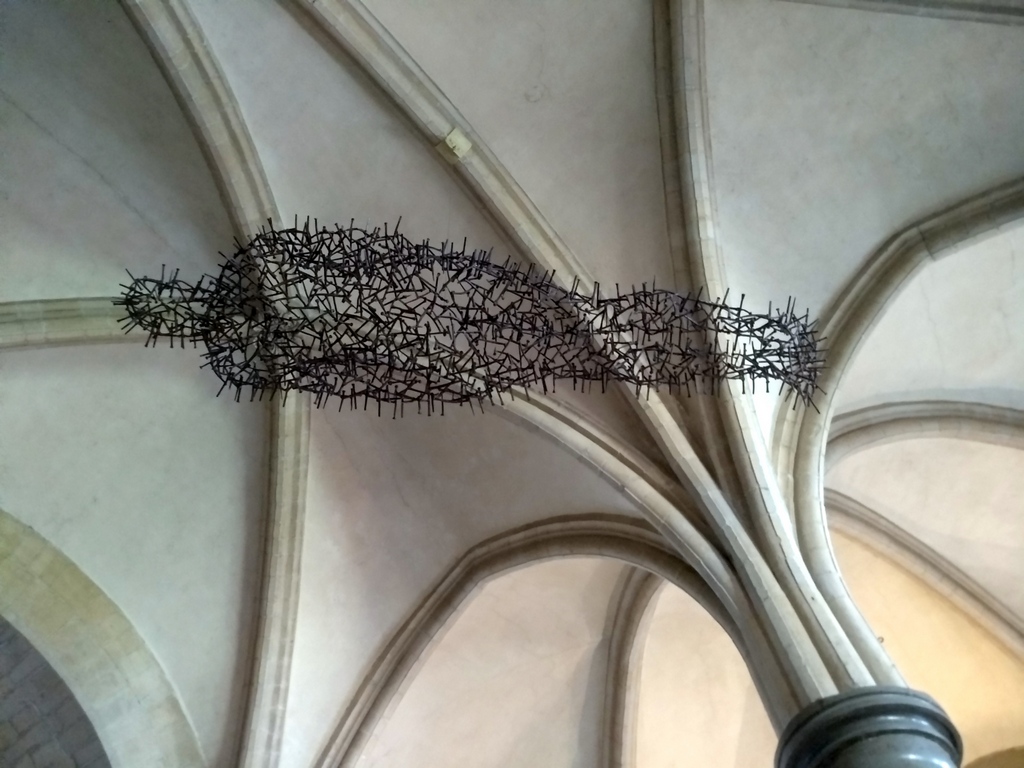
The body is less a thing than a place. Al location where things happen. Thought, feeling, memory and anticipation filter through it sometimes sticking but mostly passing on, like us in his Great Cathedral with its centuries of building, adaptation, extension and all the thoughts, feelings and prayers that people have had and transmitted here.
Mind and body, church and state are polarities evoked by the life and death of Thomas Becket.
We are all temporary inhabitants of a body, it is our house, instrument and Medium. Through it all come impressions of a wider world and all other bodies in space, palpable, perceivable and imaginable.
[Vist a Canterbury el setembre de 2018. Jo fa temps que concebia la identitat humana com una mena de filferro espantaocells on queden enganxats trossos de plàstic, papers que vénen flotant per l’aire, alguns dels quals s’hi adhereixen d’altres se’n van, i això conforma una forma, una identitat. No provenim d’uns plànols curosament dissenyats i preparats per a un destí sinó que som com una escultura o un androide fet de peces reciclades que a més es van renovant. Tenim la consistència d’un vaixell de Teseu. ]
Els apòstols Bartomeu i Tadeu hi van anar a predicar.
Entre 301 i 314, el rei Tiridates III en va fer religió d’estat.
El segle V es traduí la bíblia a l’armeni.
Al concili de Calcedònia es va plantejar el monofisisme (que Crist tenia una úncia natura) i al concili
El 554 al concili de Dvin se separa de l’església catòlica romana i l’ortodoxa grega
Mateu 5, 1-11
1 En veure les multituds, pujà a la muntanya. S’assegué, i se li acostaren els deixebles. 2 I, prenent la paraula, els ensenyava així:
3 «Feliços els pobres en l’esperit, perquè d’ells és el Regne del cel.
41773 Feliços els humils, per què posseiran la terra.
5 Feliços els qui ploren, perquè seran consolats.
6 Feliços els qui tenen fam i set de ser justos, perquè seran saciats.
7 Feliços els compassius, perquè seran compadits.
8 Feliços els nets de cor, perquè veuran Déu.
9 Feliços els pacificadors, perquè seran anomenats fills de Déu.
10 Feliços els perseguits per causa de la justícia, perquè d’ells és el Regne del cel.
11 Feliços vosaltres quan us insultaran i us perseguiran i diran falsament tota mena de mal contra vosaltres, per causa meva; 12 alegreu-vos i celebreu-ho, perquè la vostra recompensa es gran en el cel; que així és com van perseguir els profetes que us han precedit.
Nuvolet com el palmell de la mà, la pluja
1R 18,41-46
41 Després Elies digué a Acab: «Menja i beu, que sento el so de grans pluges». 42 Acab va pujar per menjar i beure. Elies va pujar al cim del Carmel, s’inclinà a terra i posà la cara entre els genolls. 43 Digué al seu criat: «Puja, per favor, i guaita del cantó del mar». Va pujar, va guaitar i digué: «No hi ha res». Elies insistí: «Torna-hi, fins a set vegades». 44 A la setena vegada, el criat digué «Hi ha un nuvolet com el palmell de la mà d’un home que puja del mar». Aleshores Elies digué: «Vés i digues a Acab: «Enganxa els cavalls i baixa, que no t’aturi la pluja». 45 A poc a poc, el cel s’anà enfosquint de núvols, el vent creixia, i esclatà una gran pluja. Acab va pujar al carro i se’n va anar cap a Jezrael. 46 La mà de Jahvè s’apoderà d’Elies, s’arromangà la cintura, i va córrer davant d’Acab fins que arribà a Jezrael.
Jahvè, en el vent suau
1R 19,9-14
9 Allí va entrar en una cova i va passar-hi la nit. La paraula de Déu se li adreçà així: «Què fas aquí, Elies?» 10 Ell respongué: «Estic ple de zel per Jahvè, Déu dels exèrcits, perquè els israelites han abandonat la vostra aliança, han arrasat els vostres altars i han matat els vostres profetes. M’he quedat jo tot sol, i encara busquen de matar-me a mi». 11 Ell digué: «Surt i estigues dret dalt la muntanya davant de Jahvè». Aleshores Jahvè va passar. Davant de Jahvè venia un vent intens i impetuós que esberlava les muntanyes i esmicolava les roques; però Jahvè no venia en el vent. Després del vent, vingué un terratrèmol; però Jahvè no venia en el terratrèmol. 12 Després del terratrèmol, vingué un foc; però Jahvè no venia en el foc. I després del foc, vingué un vent suau, tranquil. 13 Elies, en sentir-lo, s’embolcallà la cara amb el mantell, va sortir i s’estigué a l’entrada de la cova. Aleshores li arribà una veu que li digué: «Què fas aquí, Elies?» 14 Ell respongué: «Estic ple de zel per Jahvè, Déu dels exèrcits, perquè els israelites han abandonat la vostra aliança, han arrasat els vostres altars i han matat a espasa els vostres profetes. M’he quedat jo tot sol, i encara busquen de matar-me a mi»376.
Imatges que efímeres que es desfan, com l’aigua que s’escola entre els dits, o se’n va pel desaigüe. Filma com prova a fer un retrat amb aigua sobre formigó al sol. Recordo que jo havia practicat de fer cercles zen al terra de la terrassa.
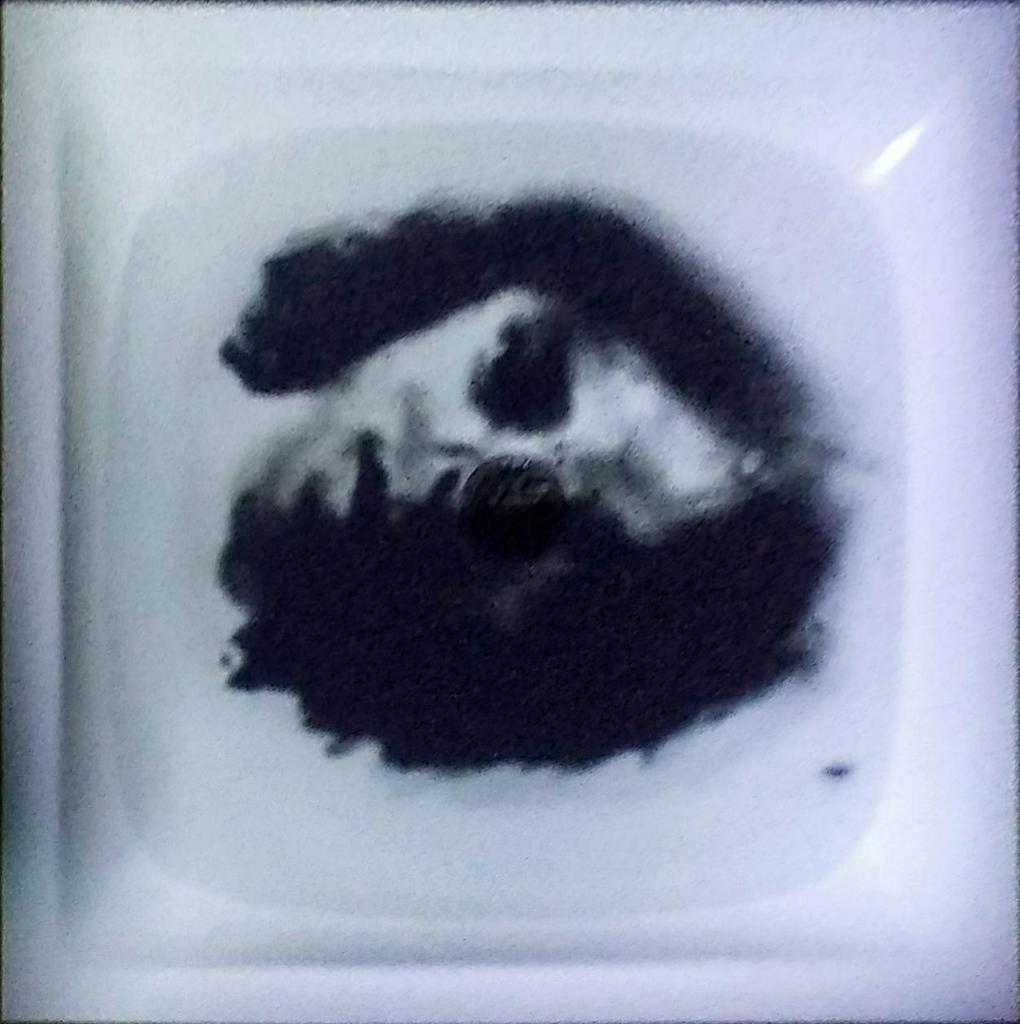
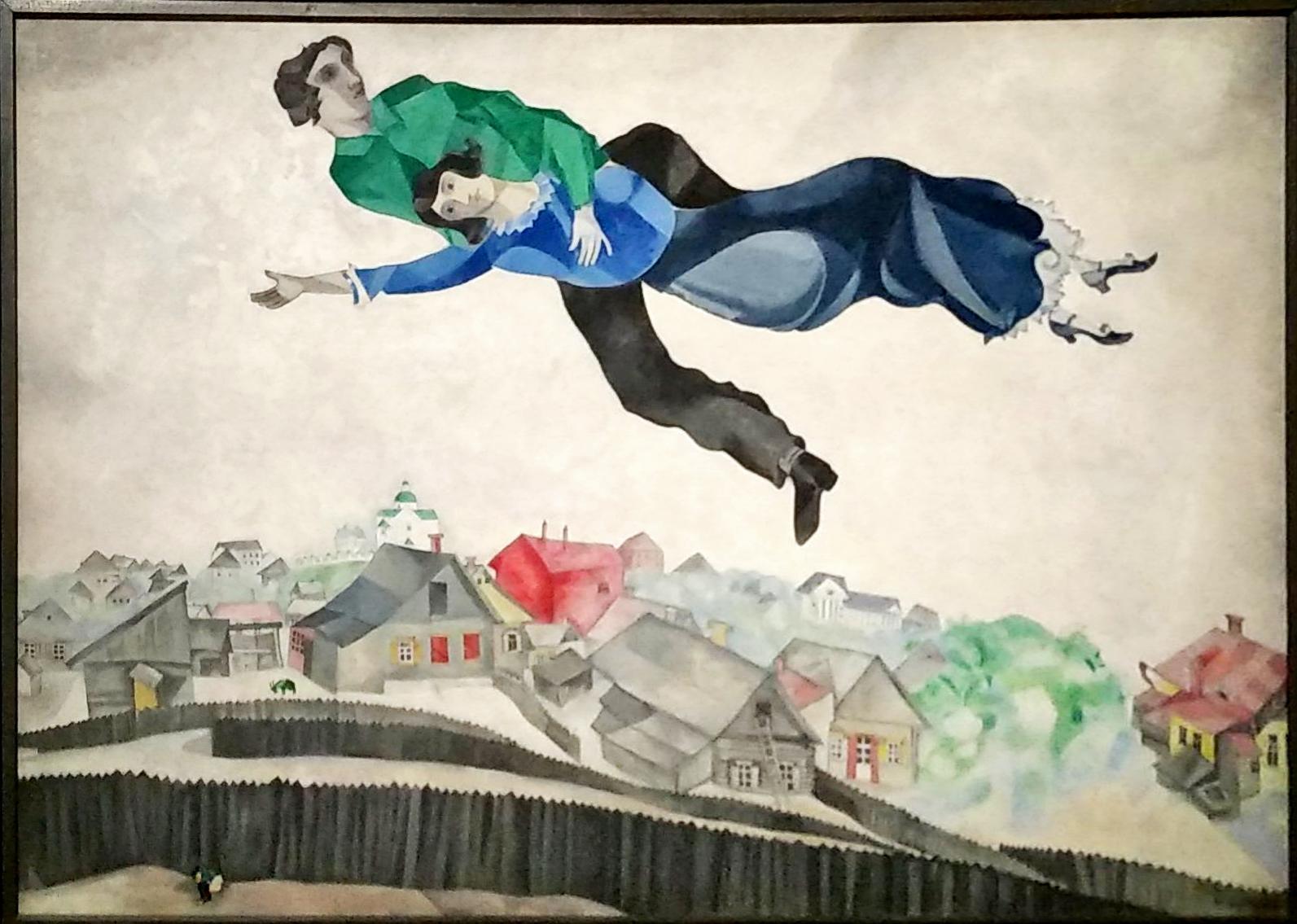
Vista a l’exposició sobre els artistes de Vitebsk, on Chagall fundà una escola de que que fou director fins 1922 que deixà Rússia, perdent aquesta obra que havia fet el 1917 i tornà a fer el 1924.
L’enamorament per Bella, la seva dona, inspira aquesta obra.
I segurament també La promenade:
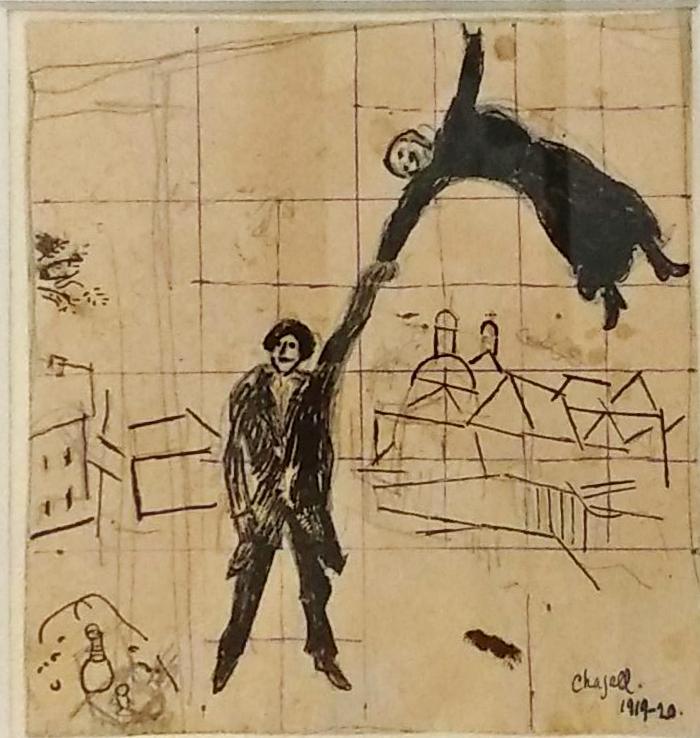
(A vegades he somiat que volava per damuint d’una ciutat, tant de bo fes sentir així a la meva parella)
27/01/1756, Salzburg, Austria – 5/12/1791, Vienna, Austria (35 anys) | Llista d’obres
1763 – 1772 Viatges amb el pare | 1773 – 1777 Cort de Salzburg | 1778 – 1779 Tour per Europa | 1779 – 1787 Viena | 1788 – 1791 Darrers anys
(0) Infantesa 1756 – 1762
Neix a Salzburg, un arxiprestat del Sacre imperi romà. El pare, Leopold, és compositor i mestre de música. Nen prodigi, toca el clavecí i el violí i esbossa les primeres composicions als 5 anys.
(1) Viatges 1763 – 1773
El pare s’endu de gira els dos germans, Nannerl i Wolfang, per lluir-los com a nens prodigi en concerts que havien de finançar els nobles del lloc. Comencen a Munich amb el príncep elector Maximilian III of Bavaria, les corts imperials de Viena i Praga, Mannheim, Paris, Londres ( coneix Johann Christian Bach), Dover, la Haia, Amsterdam, Utrecht, Mechelen, Paris, Zurich, Donaueschingen i Munich. S’estaran a Viena el 1767 i 1768 abans de començar un tour per Itàlia de 1769 a 1771.
Primeres simfonies amb 8 any, arranjaments de concerts per piano i orquestra, potser a mitges amb el seu pare.
SIMFONIES
Altres simfonies, dubtoses o no catalogades
Salzburg
ALTRES
CONCERTS per a PIANO i ORQUESTRA
1767: 4 concerts per a piano i orquestra. Els estudis han determinat que es tracta d’orquestracions d’obres d’altres autors [ jo els he escoltat amb devoció]
A Bologna coneix Giovanni Battista Martini. Roma, a la capella Sixtina, escolta el Miserere de Gregorio Allegri, del qual el vaticà tenia prohibit divlgar la partitura i la transcriurà de memòria. A Milà, amb 14 anys escriu l’òpera Mitridate, re di Ponto . Leopold intenta que l’arxiduc Ferdinand el contracti però l’emperadriu no vol Maria Teresa no vol mantenir gent no productiva.
SONATES PER VIOLÍ
MÚSICA RELIGIOSA
QUARTETS DE CORDA
String Quintet No. 1 in B♭ major, K. 174 (1773)
MISSES
ÒPERES
(2) MÚSIC A LA CORT DE SALZBURG 1773 – 1777
Amb 17 anys ocupa el càrrec de músic de la Cort a Salzburg, governada per l’arquebisbe Colloredo . Aquest volia “modernitzar” la Cort amb música italiana. S’hi estarà fins el 1777, 21 anys.
SIMFONIES
Altres simfonies, dubtoses o no catalogades
CONCERTS PER VIOLÍ
1 Violin Concerto No. 1 in B-flat major, K. 207, 1773
2 Violin Concerto No. 2 in D major, K. 211, 1775
3 Violin Concerto No. 3 in G major, “Strassburg”, K. 216, 1775
4 Violin Concerto No. 4 in D major, K. 218, 1775
5 Violin Concerto No. 5 in A major, “Turkish”, K. 219, 1775
(i dos més d’atribució dubtosa) [ — ]
ALTRES
CONCERTS PER PIANO i ORQUESTRA
Concerts per a vents
MISSES
SONATES DE PIANO
(3) 1777 – 1778 Tour per Europa, Manheim, Paris
Sonates per violí
SONATES PER PIANO
(4) VIENA 1779-1788
Sinfonia Concertante for Violin, Viola and Orchestra in E♭ major, K. 364 (1779)
ALTRES
CONCERTS per a PIANO
Concerts per a vents
Concerts per a trompa
Arguably the most widely played concertos for horn, the four Horn Concertos are a major part of most professional horn players’ repertoire. They were written for Mozart’s lifelong friend Joseph Leutgeb. The concertos (especially the fourth) were written as virtuoso vehicles that allow the soloist to show a variety of abilities on the valveless horns of Mozart’s day.
The Horn Concertos are characterized by an elegant and humorous dialogue between the soloist and the orchestra. Many of the autographs contain jokes aimed at the dedicatee.
QUARTETS
QUINTETS
TRIOS PIANO
SONATES VIOLÍ
MÚSICA PER A FESTES: Mozart left a huge production of dances for orchestra in different genres, including more than 100 minuets, two quadrilles, over 30 contra dances, over 50 allemandes (Teitsch, Ländler, or German Dances), a gavotte (French folk dance) and ballet and pantomime music. In his production of minuets, Mozart generally followed Haydn’s example, preferring the slow character of the dance. Allemandes written between 1787 and 1791 were mainly for public balls in Vienna.
MISSES i VESPRES
ÒPERES
MÚSICA MASÒNICA
SONATES PIANO
(5) Darrers anys 1788 – 1791
1788
Simfonies
Concerts per a piano i orquestra
QUARTETS
QUINTETS
TRIOS PIANO
RÈQUIEM
ÒPERES
SONATES PIANO
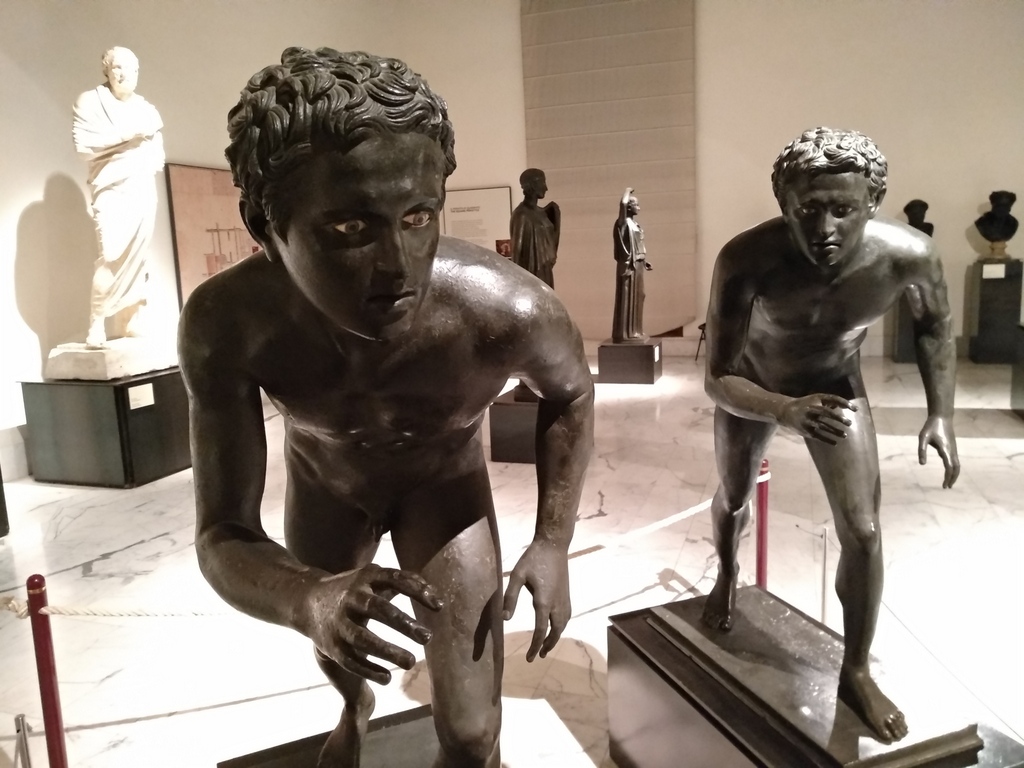
![]()
Napoli. Museo Archeologico Nazionale
The work portrays two nude young athletes on an irregular base in a similar and specular posture, completely similar in the facial features.
The statue shows the athlete with the left leg bent forward and the sole of the foot resting on the ground, while the right leg is set back with the heel raised; the trunk is leant forward; the right arm is bent, while the left one is lowered; the head is slightly turned towards the shoulders; the hair, with short tufts ruffled on the forehead, is arranged in two opposite pincers-shaped locks, the eyes are made of different materials (eyeballs of bone or ivory, irises and pupils of grey and black stone) and then inserted.
They are probably copies of Greek statues of the late fourth century or the early third century BC, celebrating a victorious athlete in one of the major Pan-hellenic games; they can be referred to the Augustan Age according to the context and a stylistic analysis.
A la mateixa sala s’hi exposen també les ballarines que estaven situades al peristil.
The house began as a modest timber-framed farmhouse constructed for John Fetherston between 1556 and 1560. The last member of the Fetherston family died in 1876. In 1904 the house was purchased by Birmingham industrialist Alfred Ash. It was inherited by Graham Baron Ash (Baron in this case being a name not a title) in 1925, who spent the following two decades creating a house of Tudor character.
The famous Yew Garden containing over 100 trees was laid out in the mid-17th century by John Fetherston, the lawyer. The clipped yews are supposed to represent “The Sermon on the Mount”. Twelve great yews are known as the “Apostles” and the four big specimens in the middle are ‘The Evangelists’. A tight spiral path lined with box hedges climbs a hummock named “The Mount”. The single yew that crowns the summit is known as “The Master”. The smaller yew trees are called “The Multitude” and were planted in the 19th century to replace an orchard.
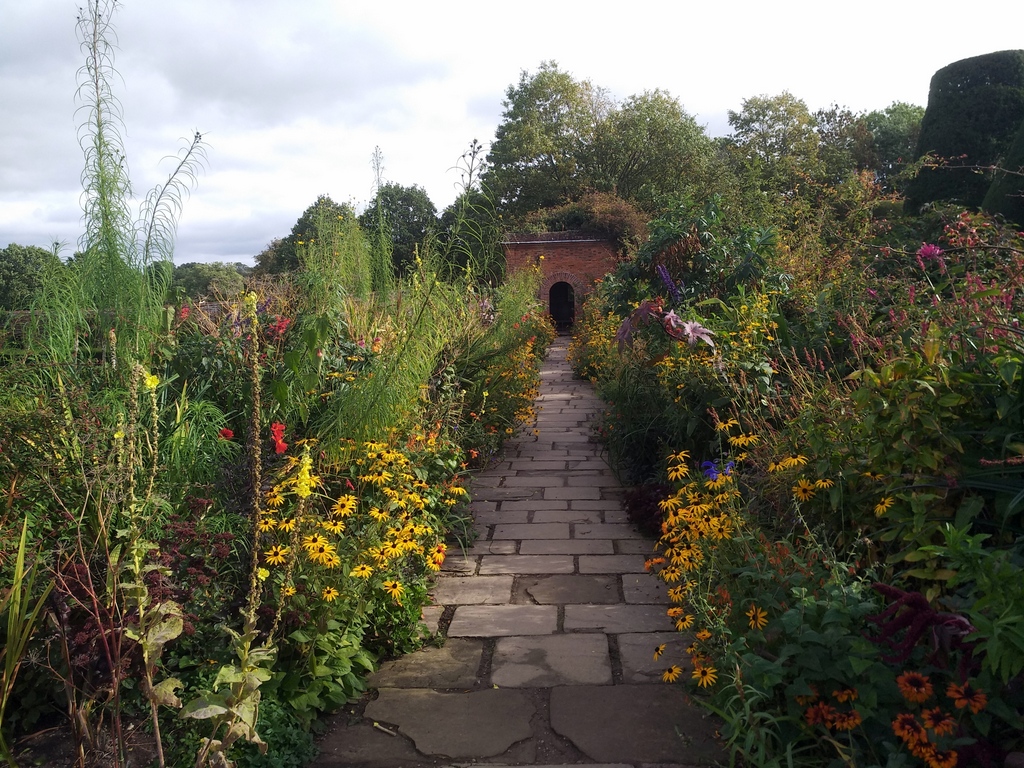
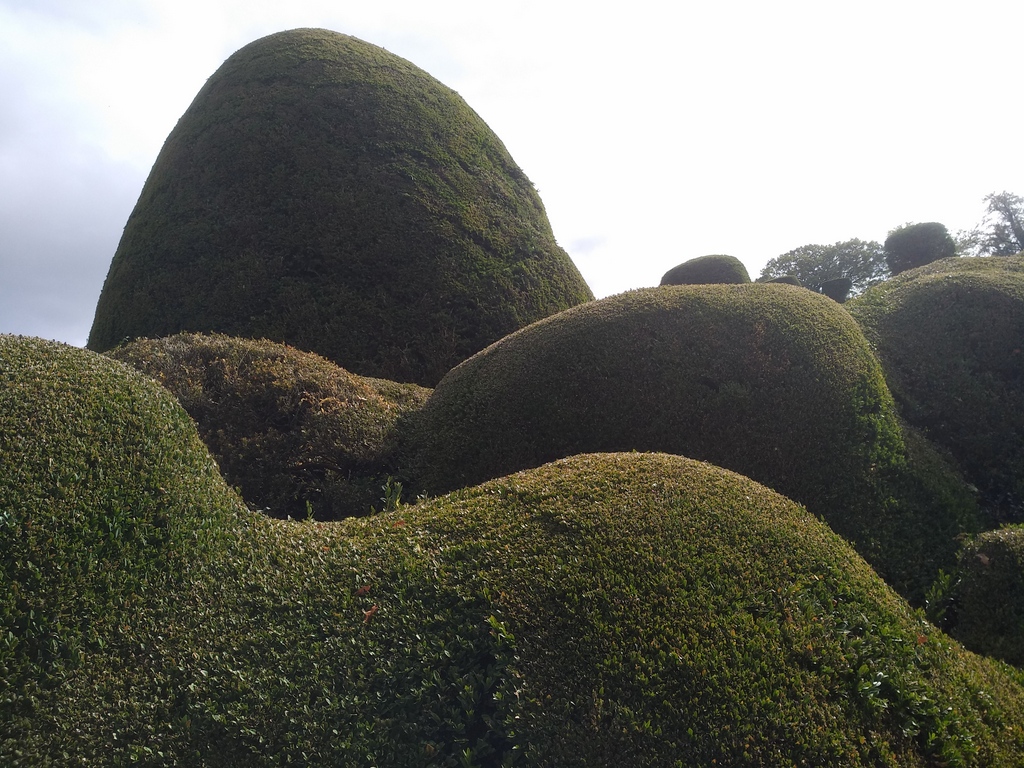
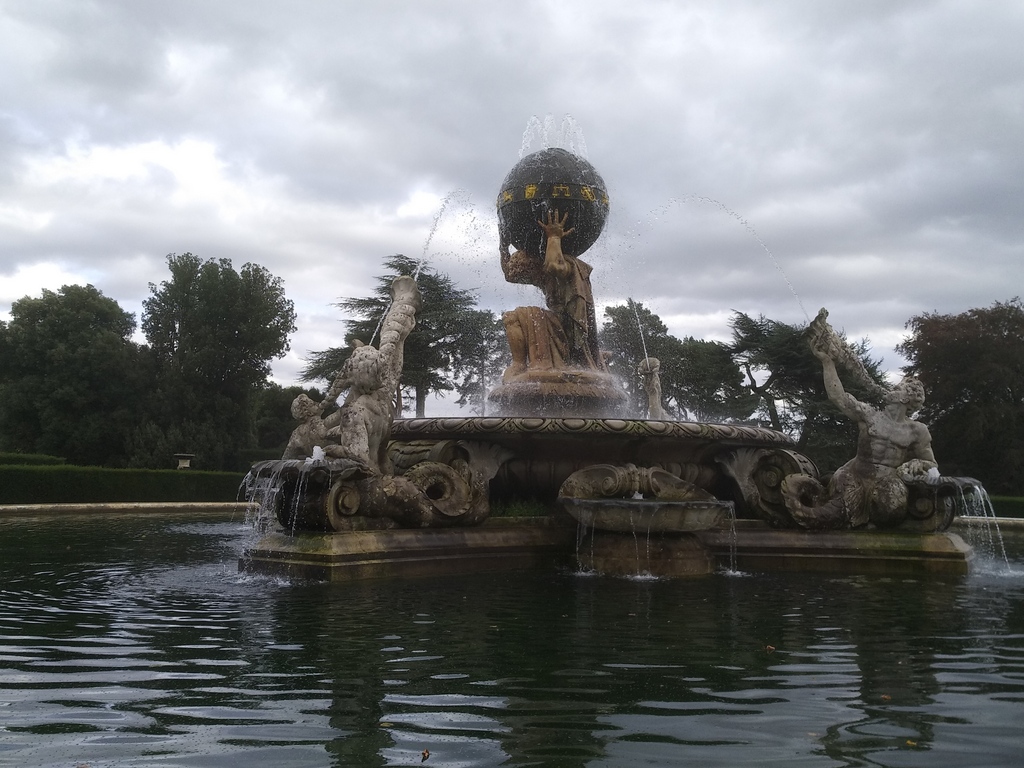
Castle Howard is a stately home in North Yorkshire, England, 15 miles (24 km) north of York. It is a private residence, and has been the home of the Carlisle branch of the Howard family for more than 300 years.
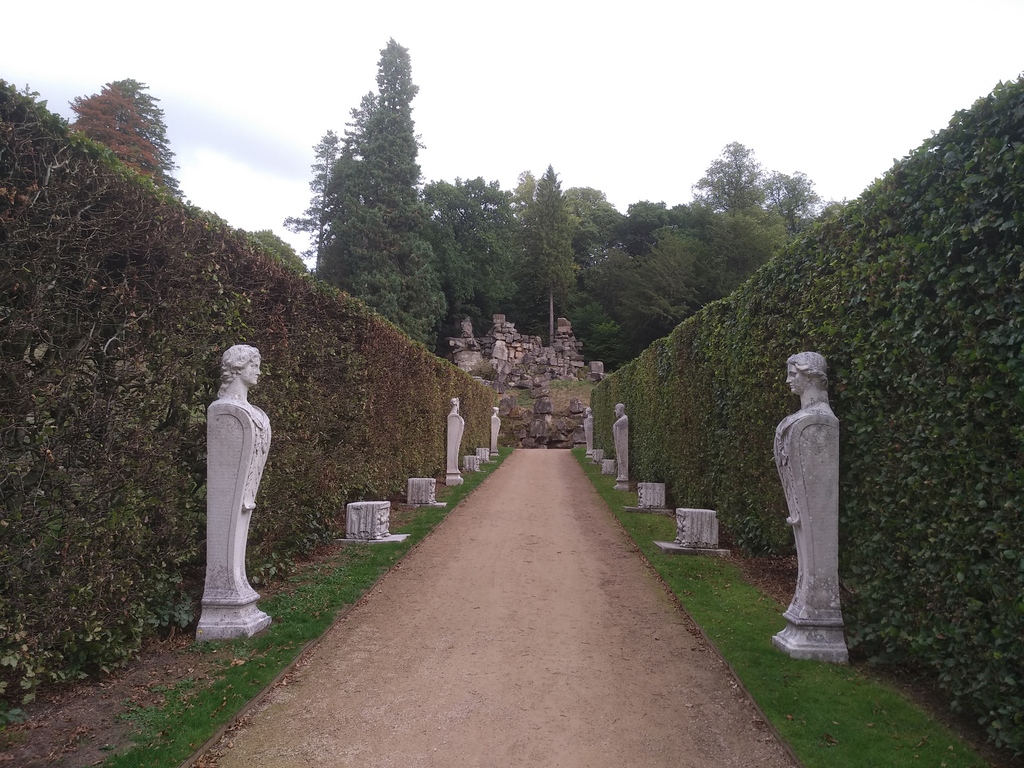

Chatsworth House is a stately home in Derbyshire, England, in the Derbyshire Dales 3.5 miles (5.6 km) northeast of Bakewell and 9 miles (14 km) west of Chesterfield (SK260700). The seat of the Duke of Devonshire, it has been home to the Cavendish family since 1549.
Standing on the east bank of the River Derwent, Chatsworth looks across to the low hills that divide the Derwent and Wye valleys. The house, set in expansive parkland and backed by wooded, rocky hills rising to heather moorland, contains an important collection of paintings, furniture, Old Master drawings, neoclassical sculptures, books and other artefacts.
http://meumon.synology.me/cuina/scones/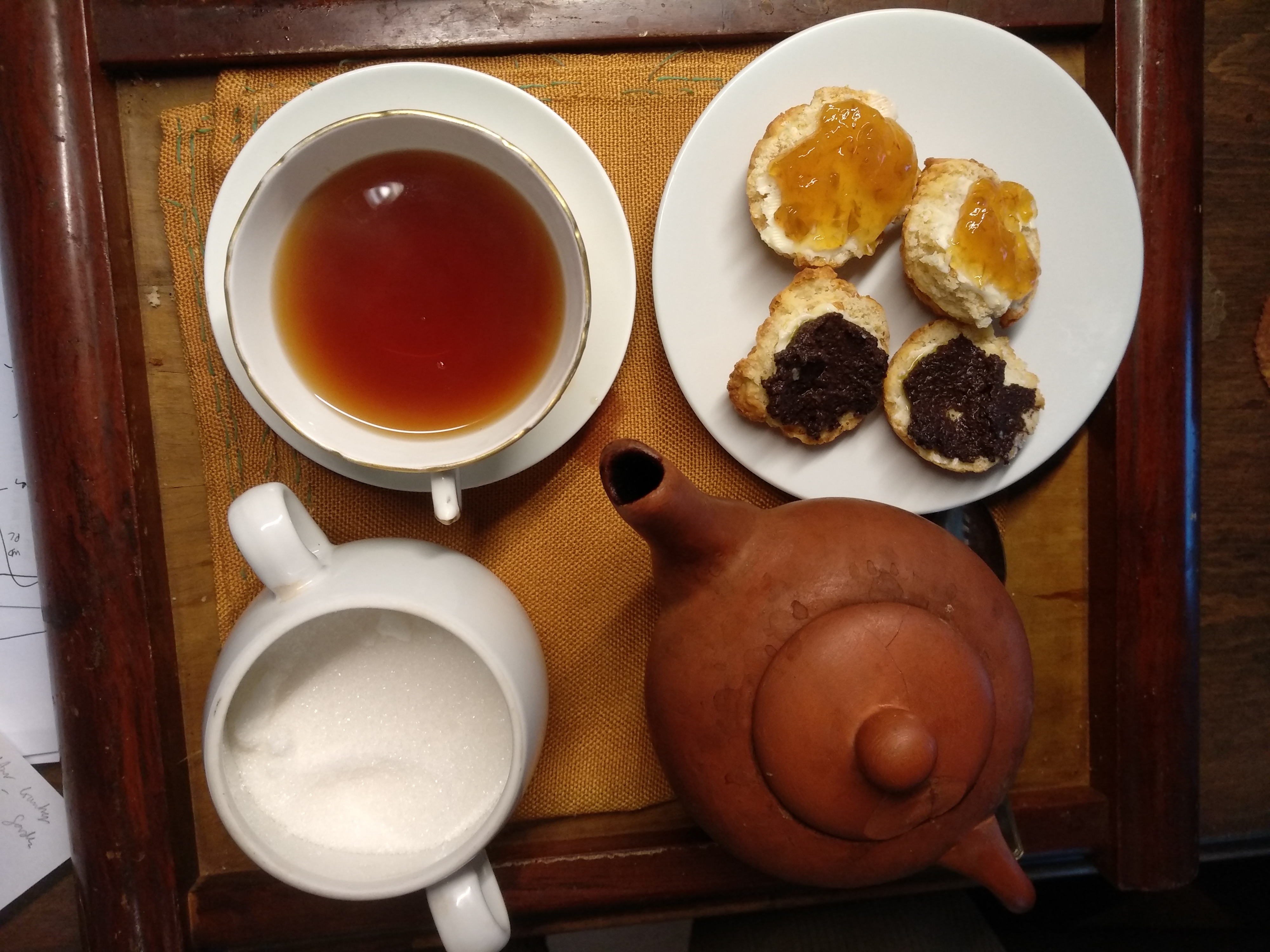
Estructura en tres parts que apareix en el primer moviment de sonates, simfonies i quartets
https://en.wikipedia.org/wiki/Sonata_form
Introducció
Exposició, primer tema: First subject group, P (Prime) – this consists of one or more themes, all of them in the tonic key. Although some pieces are written differently, most follow this form.
Segon tema [ (D major) of Haydn’s Sonata in G Major, Hob. XVI: G1, I, mm. 13–16.].
DEVELOPMENT
RECAPITULATION
(vist Silent Sea al Caixaforum el març de 2019, aquesta és similar The Quintet of the astonished. Com un Caravaggio en moviment)
bill_viola_catherines_room
Emergence 2002
Altres a Youtube:
[dins del museu de les sensacions, enllaç als sabors i gustos]
el que he menjat , Cuina, cuina2, Receptes, receptes catalanes, )
els sabors
verdura: https://ca.wikipedia.org/wiki/Col_de_jade%C3%AFta la col de jade
oktobert
Història | Reconstruir la història
Antiguetat i edat mitjana, Moderna s16 s17 s18 | S19 i s20, Ciències humanes | El “descobriment” de la prehistòria , Expedicions arqueològiques i jaciments, ciències auxiliars de la història | Els períodes de la història
¿Com hem passat d’un “univers humà” que en el temps s’estén d’unes poques generacions d’avantpassats, i en l’espai a uns quants pobles veïns, a tenir una visió d’altres cultures per tot el món que es remunten a la prehistòria i passen per una edat antiga, edat mitjana, edat moderna?
Igual que cada època ha tingut una idea de la “mida de l’univers”, que s’ha anat fent gran, la idea de “l’univers humà” que ens precedeix també ha anat canviant. Segurament inicialment els pobles només tenien una noció dels avantpassats i alguns pobles estrangers. ( història de l’exploració de la terra, cartografia ). Europa estava connectada amb Àsia per la ruta de la seda.
A l’antiguitat, tenim cròniques de guerres de grecs i romans, Herodot i Polibi. A l’edat mitjana s’escriuen històries de l’església.
Cap el 1500 (edat moderna s16 s17 s18) s’identifica una “edat mitjana” que seguiria l'”antiguitat” que ha estat redescoberta, mentre que l’època actual seria la “moderna”. Diferents nacions comencen a compilar la seva història. Les polèmiques dins de l’església fan néixer l’anàlisi filològica de textos (Mabillon). Filòsofs com Hobbes, Thomes Moro, Vico, Montesquieu, Rousseau reflexionen sobre les societats. Gibbon, Adam Smith. Amb la “descoberta” del Nou món es comença a tenir una idea de tots els pobles que hi ha a la terra.
S19 i s20, Ciències humanes. Al s19 amb la revolució industrial i el colonialisme s’acaba d’explorar el món i es planteja com estudiar societats organitzades de manera diferent a les nostres (antropologia cultural).
Neix la història moderna basada en la interpretació de textos i jaciments. Es duen a terme ambicioses expedicions arqueològiques. Els jaciments, permeten conèixer altres civilitzacions com les de l’antic Orient, els maies i els inques, i conèixer millor Egipte, l’antiga Grècia i Roma. Es sistematitzen les ciències auxiliars de la història: arqueologia, genealogia, cronologia, bibliografia, diplomàtica, epigrafia, paleografia, sigil·lografia i crítica textual. Amb el “descobriment” de la prehistòria i la Teoria de l’evolució de Darwin, aquest “univers humà” passa d’uns 6000 anys d’antiguetat, a milions.
La revolució francesa qüestiona la societat tradicional, es concep una possible ciència de l’home i les societats tant per descriure-la com per millorar-la, el positivisme i l’humanitarisme.
Les societats es pensen amb:
Així, al s20 comencem a tenir un “relat” més o menys compartit, i més o menys esbiaixat, sobre l’aparició de l’home a la terra, i les civilitzacions i cultures que s’han anat succeïnt
Com s’han establert els períodes de la història? (Veure Història, blocs, fets sobre invariants)
[A l’antiguetat no hi ha una distinció clara, potser una referència al mite de l’antiga edat d’or].
A l’edat mitjana es comptaven 6 edats de 1000 anys des d’Adam. (Sant Agustí), o les tres edats, abans de Moisès, després de Moisès, després de Jesús (Sant Pau).
Tres edats. Cap el 1500 els humanistes italians descobreixen l’antiguetat clàssica . Petrarca introdueix la idea de renaixement i d’edat fosca o edat mitjana. Així la història queda dividida en tres etapes, antiguetat, edat mitjana i moderna. Aquesta noció s’aplicava inicialment a les arts visuals, i només després es van tenir en compte altres factors de canvi com el bloqueig de la ruta de la seda pels turcs, el descobriment d’Amèrica, la impremta, la reforma de Luter. Es dividirà en l’alta edat mitjana (“Early” 500-1000), una època de caos i inestabilitat, la Plena edat mitjana (“High” error de l’alemany “Alt”, 1000-1300), i la Baixa edat mitjana (“Late” 1300-1500). El terme “gòtic” és introduit per Vasari per designar l’arquitectura del nord. A finals del sXX, per evitar el biaix eurocèntric, els historiadors introdueixen la denominació post-clàssica [nom?].
Una divisió posterior [El segle XX suposo qui la fa?] distingirà entre Edat moderna (Early modern 1500-1800) que arribaria fins a les revolucions francesa i industrial i Edat contemporània (Late modern 1800 – actual). A vegades s’introdueix una subdivisió a partir de 1945. [i jo potser n’afegiria una altra el 1989, amb la caiguda del mur, i la informatització].
Així doncs, els s16, s17 i s18 es viuran com a “moderns” dins de la subdivisió de tres edats. A començaments del s19 es “descobreix” la prehistòria. i es divideixen els jaciments segons les eines: edat de pedra, bronze, ferro. (igual que els jaciments de les espècies extingides es podien classificar en mamífers (cenozoic), grans rèptils (mesozoic), peixos i artròpodes (paleozoic)). L’edat de pedra es classificarà ( John Lubbock in 1865) en paleolític, mesolític i neolític. La noció de la “revolució” del neolític arriba més tard, acompanyada pels descobriments de les primeres ciutats.
Així, entrem al s20 amb una història de l’home que té es remunta a la prehistòria, amb una reconstrucció difícil de l’evolució dels homínids, l’antiguetat, l’era postclàssica i les eres modernes.
Història | Prehistòria, migracions, Paleolític -100.000 a -8000 | Neolític -8000 -3300 | Primeres civilitzacions -3300 a -800 | Antiguetat clàssica -800 a 500 | Edat mitjana. 500 – 1500 CE | Moderna. 1500 – 1800 | Contemporània 1800 – 1915 | Actual 1915 – ara
FITXES:
(1) Història Antiga i medieval / Història moderna (períodes)
(2) Excavacions i ciències auxiliars: prehistòria, grans expedicions arqueològiques, ciències auxiliars
(3) Història moderna, ciències humanes
Els que diuen que el fi justifica els mitjans, sovint tenen uns fins injustificables.
(atribuït a Chesterton?)